Ready to Discover the Best Malaysian Foods? Then check out these 100+ best foods to eat in Malaysia!
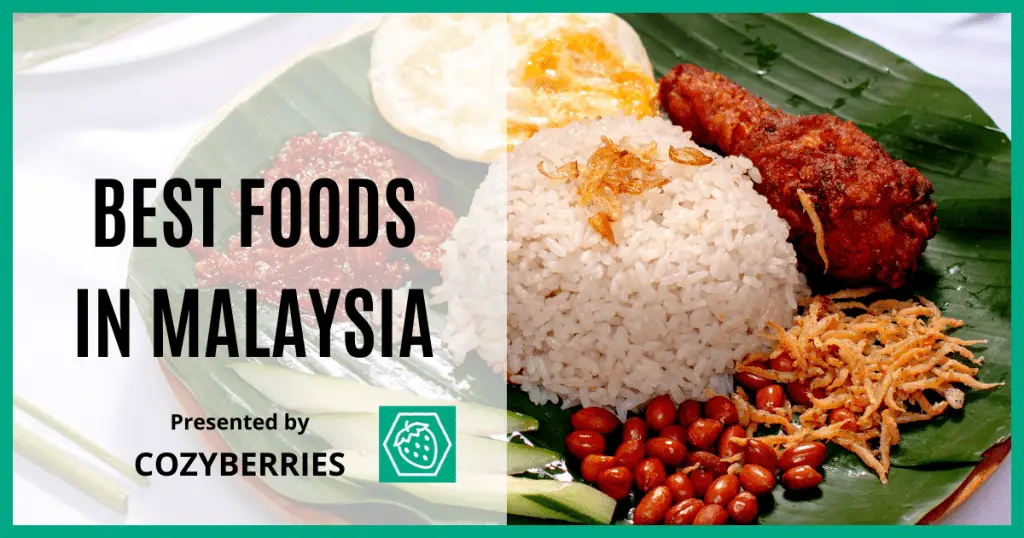
You are in the right place, as I am going to share with you 100+ best Malaysian foods, including where to find and eat these “must try” local foods.
With this top Malaysia foods list, you can now find all of Malaysia’s best cuisines in one place. You no longer need to worry about what and where to eat next, and most importantly, will not miss out on the most popular Malaysian foods!
I will also show you whether the food is commonly eaten as a main meal, side dish, snack, or dessert to help you in planning out your food journey in Malaysia.
This is the exact list that I am going to tell my foreign friends who visiting Malaysia what and where to eat.
In the later part of the article, I also included the Malaysian food guide to help you in exploring Malaysia’s foods and beverages including:
- Best beverages to drink
- Best tropical fruits to eat
- Places to find the best food
- Where and what to eat for breakfast, lunch, dinner, afternoon tea, and supper
- The six main cuisines in Malaysia
- Price of foods and payment modes in Malaysia
Let’s dive right in!
Rice Dishes in Malaysia: Best Malaysian Foods
1. Nasi Lemak (Coconut Milk Rice)
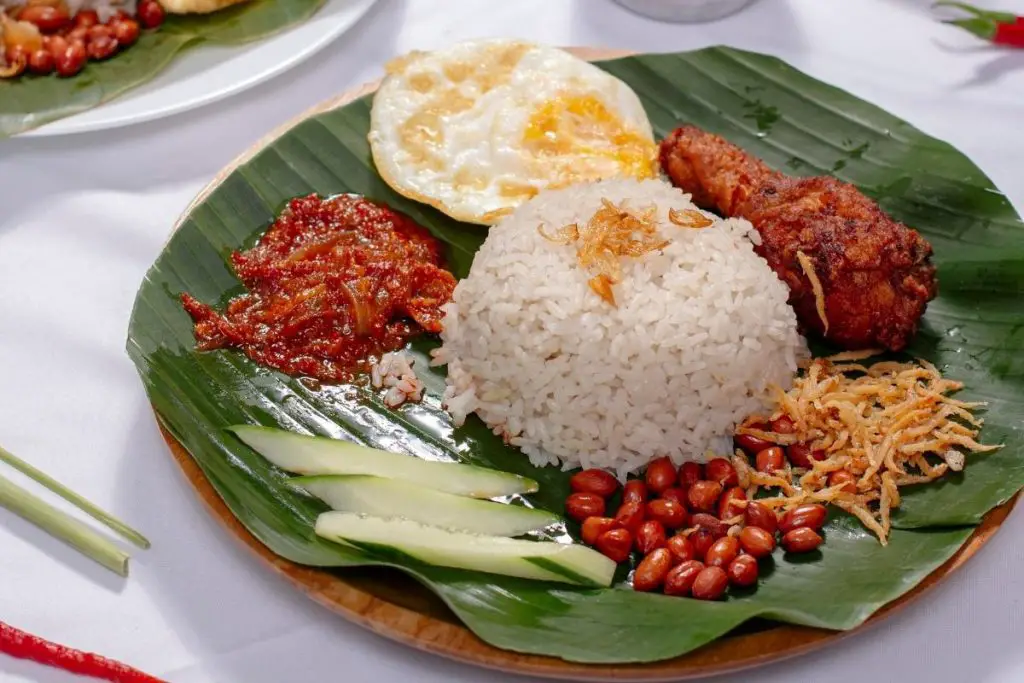
Nasi lemak is the most famous food in Malaysia. It is also considered a national dish in Malaysia.
It is delicious, flavourful, and easily accessible. It can be enjoyed as breakfast, lunch, dinner, or even teatime and supper!
The most important element for a good nasi lemak is the sambal (Malaysian chilli paste), followed by the rice, and then the sides.
The fluffy and fragrant rice (nasi) is cooked with coconut milk (santan) and pandan leaves and accompanied perfectly by sambal and sides like toasted peanuts, cucumber slices, fried crispy anchovies (ikan bilis), and a hard-boiled egg or fried egg.
Some also offer add-ons like chicken rendang, fried chicken, chicken curry, sambal squid (sotong), and more.
You can find nasi lemak served on a plate at restaurants, food courts and hawker centres or find it served wrapped in banana leaves and newspaper at roadside stalls or restaurants.
It is a must-eat food in Malaysia.
- Eat as: Main meal
- Where to Eat: Roadside stall, hawker centre, food court, restaurant, night market
- Main ingredients: Rice, coconut milk, sambal, peanuts, cucumber, fried anchovies, egg
- Cuisine: Malay
2. Nasi Kandar (Indian Mixed Rice with Curries)
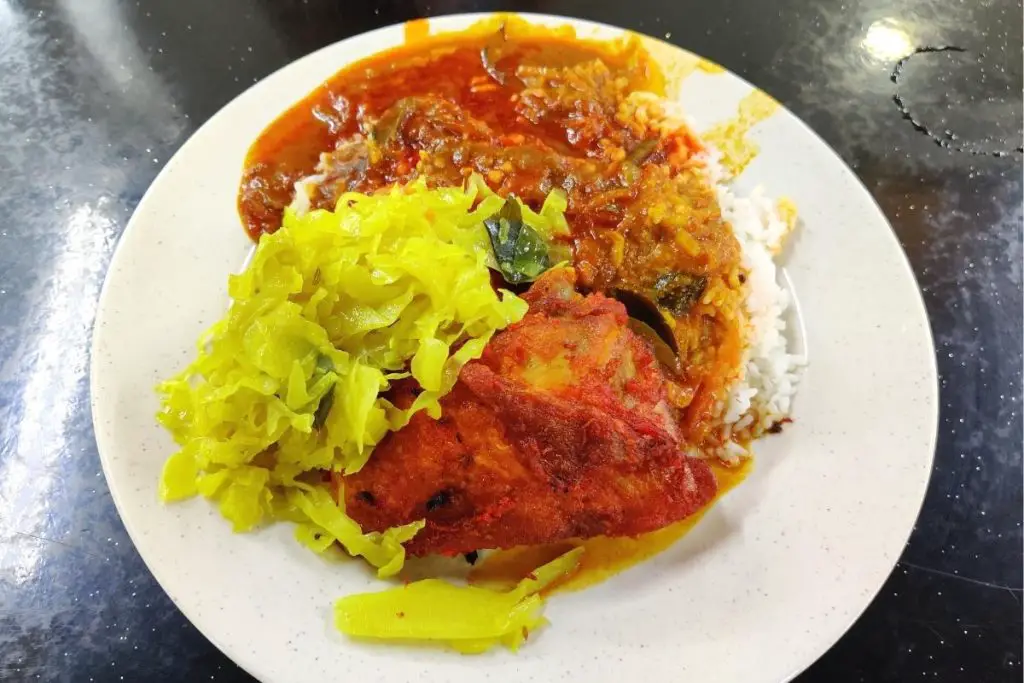
Nasi Kandar is one of the best Malaysian foods that is popular among all races. It’s basically rice with dishes of your choice like fried chicken, chicken curry, beef curry, fish curry, stir-fried cabbages in turmeric, bitter gourd, fried egg, and more.
To order, just request for nasi (rice) and then point out the dishes you want in front of the food counter, and then the server will take them for you.
Most importantly, make sure you ask for mixed gravy or mixed curries (kuah campur/kari campur) after they served the rice or once finish choosing the dishes.
Then, watch them top your plate of rice with a mixture of curries like chicken, fish, lamb, and beef.
When eating, you can taste the flavour of different curries explode in your mouth with each bite, plus the mouth-watering dishes, it is extremely good.
And this is what makes the nasi kandar stand out and become one of the best foods to eat in Malaysia. It is a beautiful mix of fragrance, flavours and texture.
You can find nasi kandar in Nasi Kandar restaurants and Mamaks all over Malaysia, mostly run by Indian Muslims.
It is popular in Kuala Lumpur, Selangor, Penang, Kedah, Pahang, Ipoh, Johor Bahru, and many other states.
- Eat As: Main meal
- Where to Eat: Nasi Kandar restaurant, Mamak
- Main Ingredients: Rice, curries, meat (chicken, beef, fish, lamb), vegetables
- Cuisine: Indian
3. Hainanese Chicken Rice
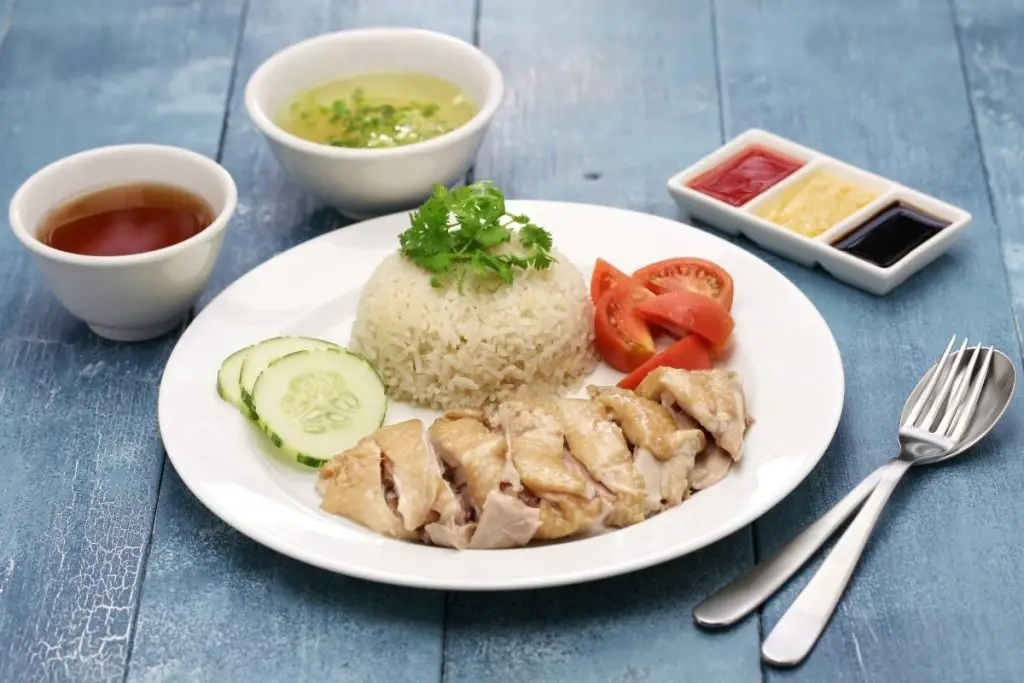
The Hainanese chicken rice is another great combination of chicken and rice dishes in Malaysia.
The dish consists of poached chicken and rice cooked with chicken stock.
The chicken meat is silky and mouth-watering, and the rice itself is tasty due to the essence of chicken stock.
It is usually served with cucumber and dipping sauces like ginger paste, chilli sauce and garlic.
You can find it in hawker centres, The Chicken Rice Shop, and Hainanese restaurants.
- Eat As: Main meal
- Where to Eat: Hainanese restaurant, The Chicken Rice Shop, hawker centre, food court
- Main Ingredients: Chicken, rice
- Cuisine: Chinese
4. Banana Leaf Rice
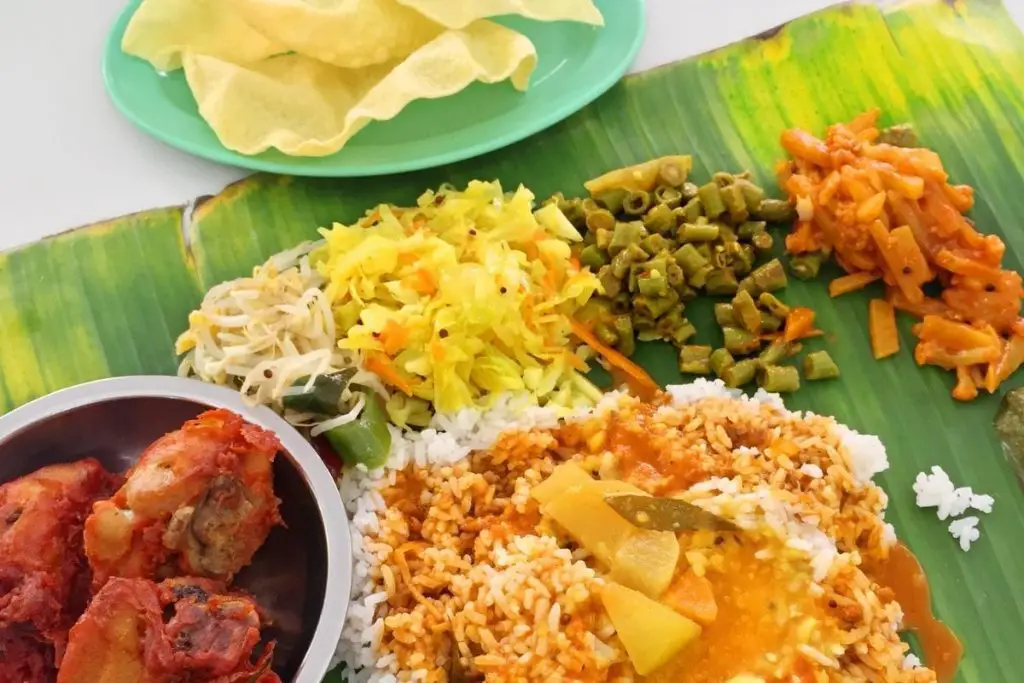
Banana leaf rice is a South Indian cuisine served on a large banana leaf. The dish consists of white rice, an assortment of vegetables, pickles, curries, and crispy poppadoms (fried crackers).
The dish is vegetarian-friendly, but you can also add meats like chicken, lamb, fish and beef curries and mutton rendang.
You can eat the dish in Banana Leaf Rice restaurants, and the recommended time to enjoy banana leaf rice is during lunch hour.
- Eat As: Main meal
- Where to Eat: Banana Leaf Rice restaurant
- Main Ingredients: Rice, vegetables, curries, pickles, poppadoms (fried crackers)
- Cuisine: Indian
5. Nasi Kerabu (Blue Herb Rice)
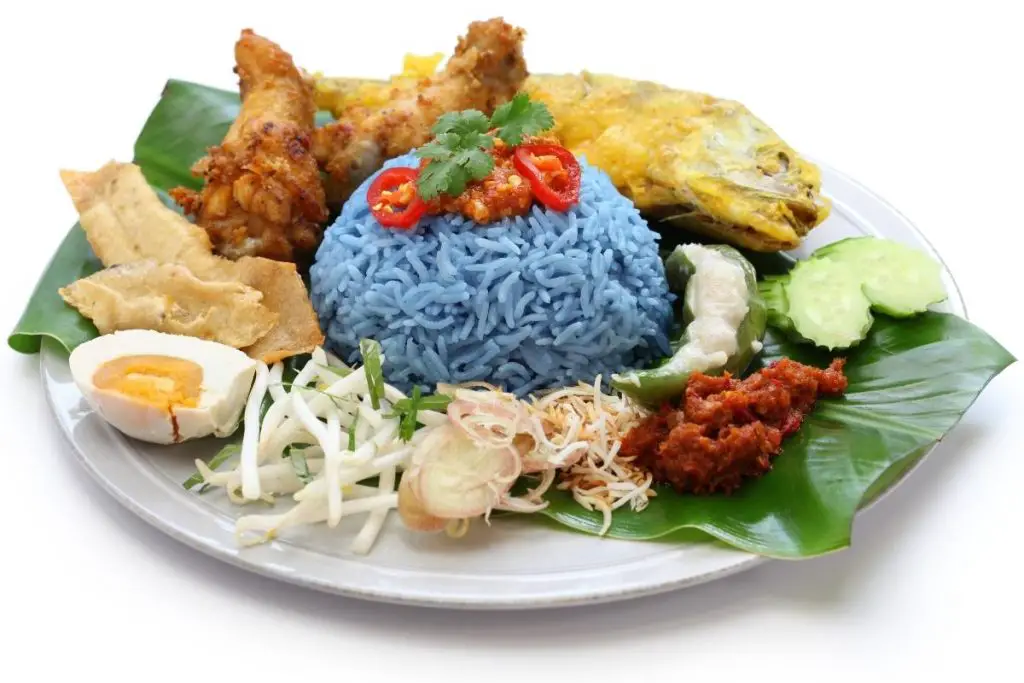
Nasi Kerabu is a famous Malaysian dish from the state of Kelantan.
It is known for its eye-grabbing blue colour rice, which gets the colour from the petals of the butterfly pea flower (Bunga telang).
Nasi kerabu is often served alongside bean sprouts, long beans, cabbage, cucumber, grated coconut, salads, spicy budu (fermented fish paste/sauce) and fresh herbs.
Some also come with a half of salted egg, fried chicken, fried fish, sambal, solok lada (stuffed green chilis), egg, and keropok keping (fish crackers).
- Eat As: Main meal
- Where to Eat: Malay night market, roadside stall, restaurant
- Main Ingredients: Rice, butterfly pea flower, bean sprouts, long beans, cabbage, cucumber, grated coconut, salads, spicy budu (fermented fish paste/sauce), fresh herbs
- Cuisine: Malay
6. Nasi Goreng Kampung (Traditional Malay Fried Rice)
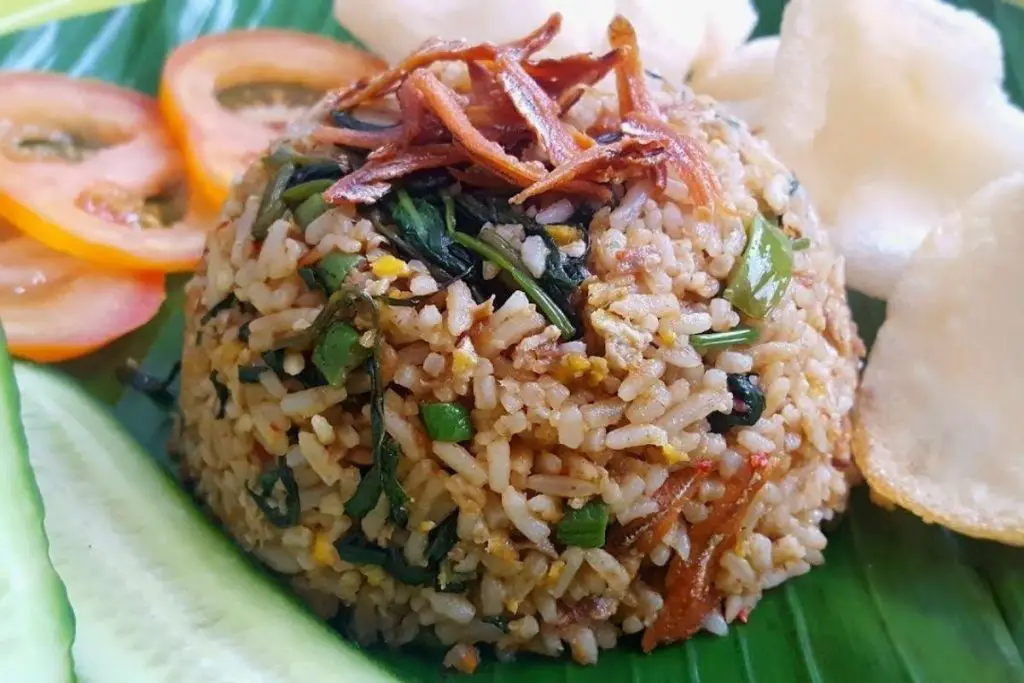
Nasi goreng kampung is one of the most famous styles of fried rice in Malaysia.
There are many types of fried rice in Malaysia and most of them are delicious and worth trying out!
The dish is made by stir-frying the rice with garlic, onions, shallots, belacan (shrimp paste), chilli peppers, eggs, and water spinach and is topped with slices of cucumber and tomato, and fried anchovies.
You can enjoy the dish in restaurants, Malay stalls and Mamak.
- Eat As: Main meal
- Where to Eat: Restaurant, roadside stall
- Main Ingredients: Rice, garlic, onions, shallots, belacan (shrimp paste), chilli peppers, eggs, water spinach, cucumber, tomato, fried anchovies
- Cuisine: Malay
7. Chicken Rice
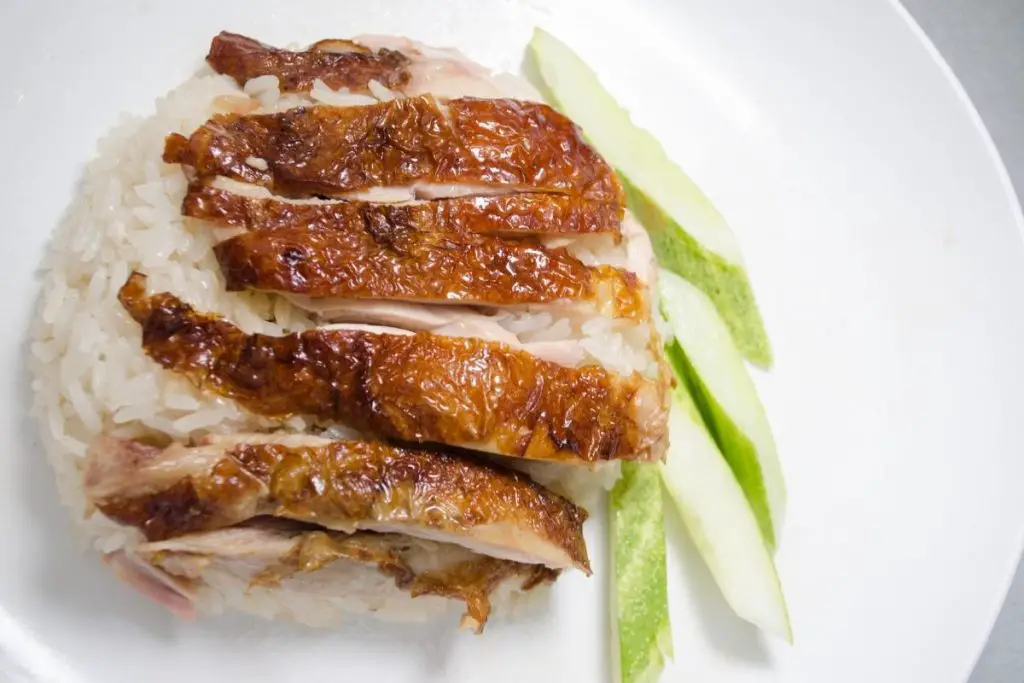
Chicken rice is one of the most common and delicious foods in Malaysia and is enjoyed by locals.
The dish consists of chicken (thigh, drumstick, breast, or wing), fluffy rice cooked with ginger, shallots and chicken broth, slices of cucumber, and soy sauce.
It also comes with a chilli sauce that matches the dish perfectly.
Most non-halal chicken rice stalls and restaurants also sell roasted pork belly and char siew (BBQ pork), so you can order the mix of these three to enjoy more flavours and deliciousness in one dish.
You can find it easily across Malaysia due to its popularity.
- Eat As: Main meal
- Where to Eat: Hawker centre, food court, restaurant, The Chicken Rice Shop, roadside stall
- Main Ingredients: Chicken, rice, cucumber, soy sauce
- Cuisine: Chinese
8. Ayam Percik (Chicken with Percik Sauce)
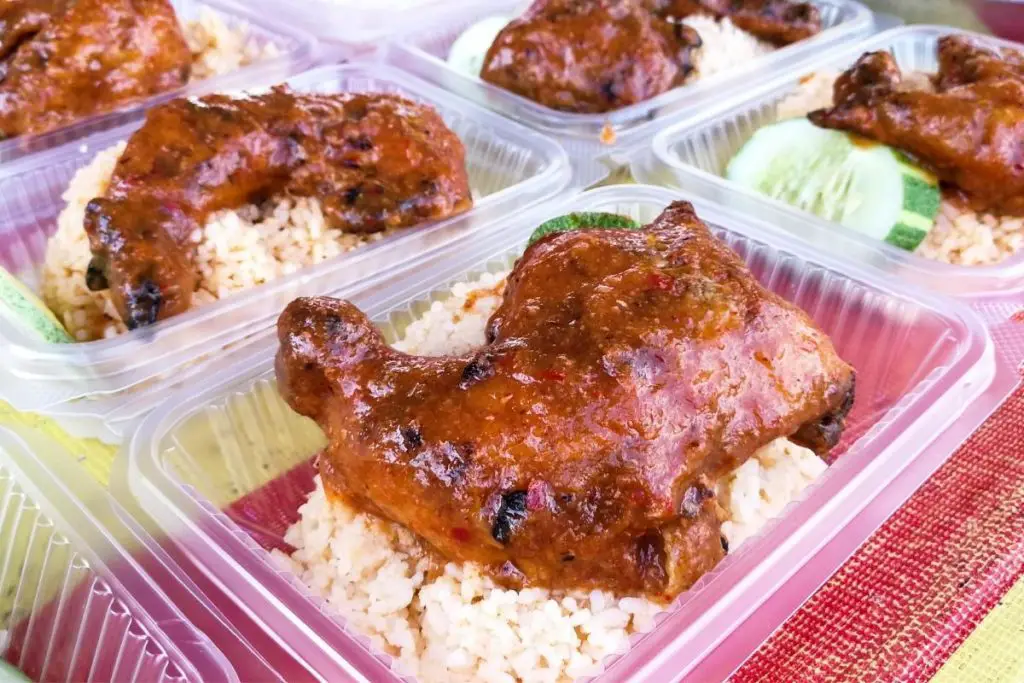
Ayam Percik is a barbecued chicken with percik sauce that is made of coconut milk, chilli, cumin, turmeric, lemongrass, garlic, coriander, galangal, and ginger.
The chicken is marinated with sauces and spices and grilled slowly over charcoal.
It is commonly served with white rice and fresh vegetables.
The dish is from Kelantan and can be found across Malaysia.
- Eat As: Main meal
- Where to Eat: Restaurant. Malay night market, roadside stall
- Main Ingredients: Chicken, coconut milk, chilli, cumin, turmeric, lemongrass, garlic, coriander, galangal, ginger
- Cuisine: Malay
9. Nasi Biryani/Briyani/Beriani (Indian Herb Rice)
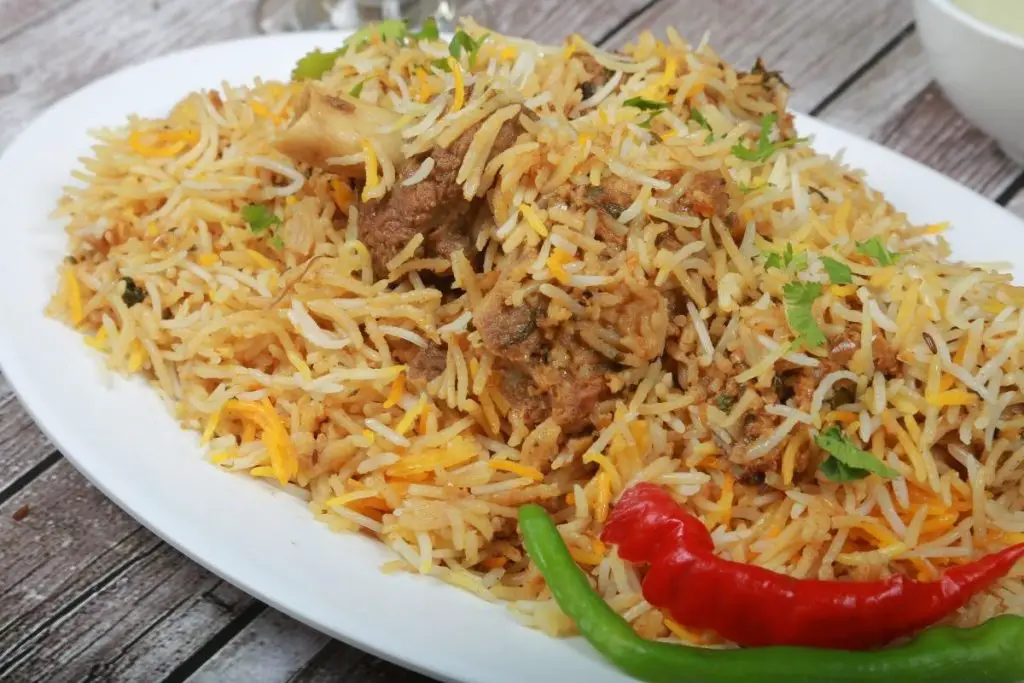
Nasi Biryani is a popular Indian mixed rice dish known for its rich taste, aromatic and variety of ingredients.
The dish is made by slowly cooking the long-grain basmati rice, meat (mutton, chicken or beef), eggs, dried fruits, vegetables, nuts, potatoes, and spices like saffron, cinnamon, cardamom, and cumin over a low fire.
You can find the food in Mamak and Indian restaurants.
- Eat As: Main meal
- Where to Eat: Mamak, Indian restaurant
- Main Ingredients: Basmati rice, meat (mutton, chicken or beef), egg, dried fruits, vegetables, nuts, potato, spices (saffron, cinnamon, cardamom, cumin)
- Cuisine: Indian
10. Claypot Chicken Rice
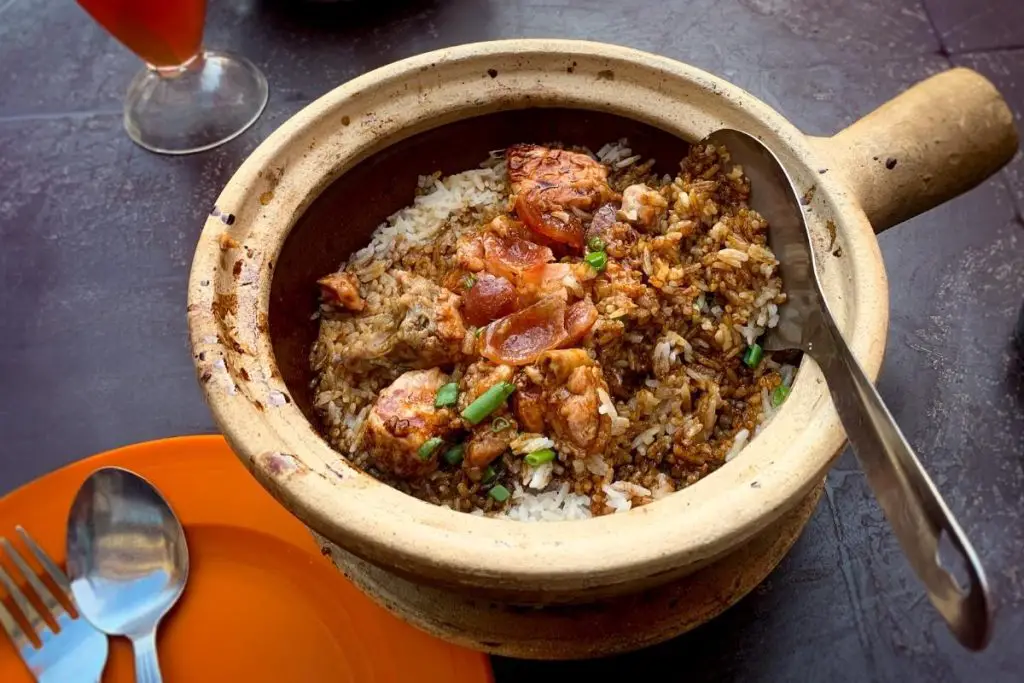
Claypot chicken rice is a popular rice dish served in a claypot.
It is made by filling the rice, Chinese sausage, marinated chicken meat, dried shiitake mushroom, green onion, shallot, salted fish, shredded ginger, and soy sauce in a claypot and cooking it over charcoal, resulting in a smoky taste.
Some also use pork lard and minced garlic sauce to improve the flavour of the claypot chicken rice.
Besides, the rice cooked in a claypot will form a scorched crust, which is crunchy and smoky in taste.
- Eat As: Main meal
- Where to Eat: Hawker centre, restaurant, food court, roadside stall
- Main Ingredients: Rice, chicken, Chinese sausages, mushrooms, ginger, shallots
- Cuisine: Chinese
11. Nasi Dagang (Terengganu Coconut Milk-infused Rice)
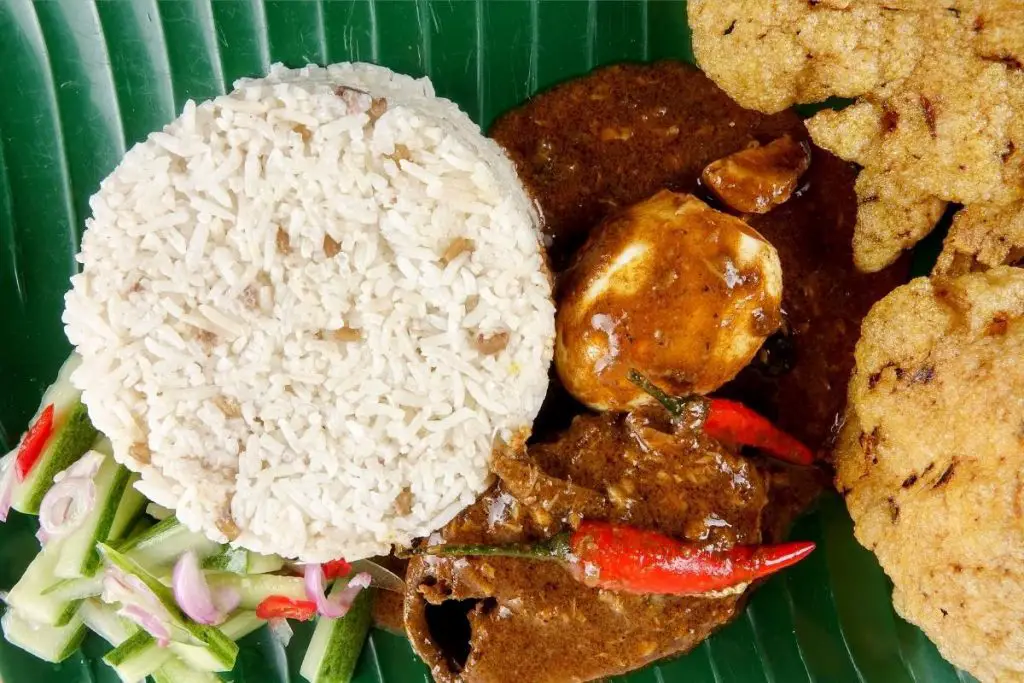
Nasi dagang is a popular dish for breakfast from Terengganu, Malaysia.
The fragrance rice is steamed with coconut milk, lemongrass, shallots, and fenugreek seeds.
It is usually served with kari ikan (fish curry), hard-boiled eggs, pickled vegetables like cucumbers and carrots, and sambal (chilli paste).
- Eat As: Main meal
- Where to Eat: Restaurant, roadside stall
- Main Ingredients: Rice, coconut milk, lemongrass, shallots, fenugreek seeds, garlic, young ginger
- Cuisine: Malay
12. Hakka Lei Cha/Lui Cha (Thunder Tea Rice)
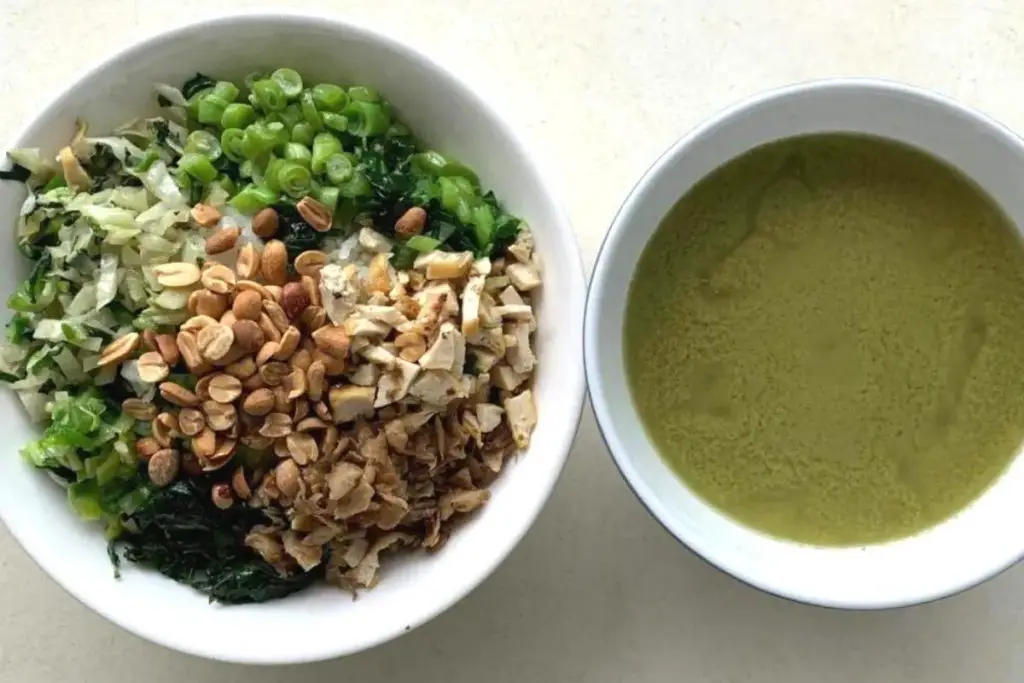
Lei Cha or Lui Cha is a popular Hakka dish in Malaysia that comes with a lot of vegetables.
The dish consists of rice/brown rice, long bean, cabbage, kale, string beans, preserved radish, tofu, black-eyed pea, peanuts, dried shrimp, rice crackers, and a bowl of green colour tea soup.
The lei cha soup is made with basil leaves, mugwort leaves, coriander leaves, green tea leaves, mint leaves, peanuts, and salt.
Lei cha is a vegetarian-friendly dish, but some lei cha includes dried shrimp, so make sure you request “no dried shrimp” if you are a vegetarian.
The best way to eat lei cha is to mix the ingredients with rice and drench the green soup on top of them.
You can find the dish in Lei Cha restaurants, hawker centres, food courts, and roadside stalls.
- Eat As: Main meal
- Where to Eat: Lei Cha restaurant, hawker centre, food court, roadside stall
- Main Ingredients: Rice (white or brown), long bean, cabbage, kale, string beans, preserved radish, tofu, black-eyed pea, peanuts, dried shrimp, rice crackers, basil leaves, mugwort leaves, coriander leaves, green tea leaves, mint leaves
- Cuisine: Chinese
13. Nasi Ulam (Malaysian Mixed Herb Rice)
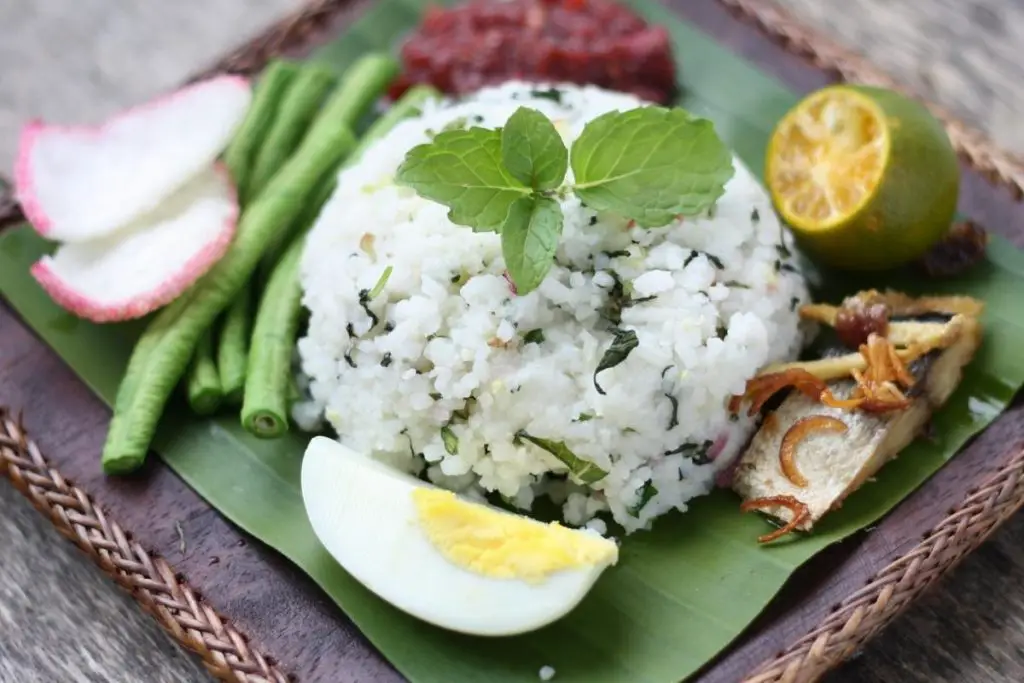
Nasi Ulam is a rice dish that combines steamed rice and various raw herbs such as cashew leaves, betel leaves and pegagan (Centella Asiatica).
The dish contains ingredients like vegetables, grated coconut, shallots, dried shrimps, and shredded dried fish.
- Eat As: Main meal
- Where to Eat: Nasi Ulam restaurant
- Main Ingredients: Rice, cashew leaves, betel leaves, pegagan (Centella asiatica), vegetables, coconut, shallots, dried shrimps, dried fish
- Cuisine: Malay
14. Nasi Tumpang/Nasi Tupe (Compressed Rice in Banana Leaf Cone)
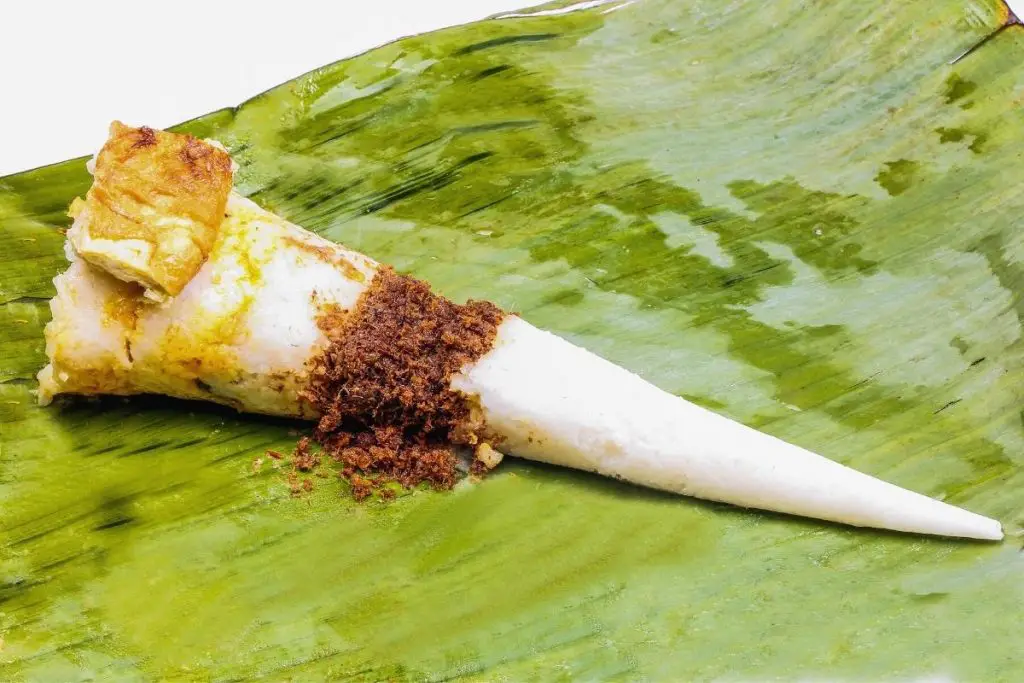
Nasi tumpeng is a popular rice dish breakfast from Kelantan, Malaysia.
It consists of rice with layers of dishes wrapped in a cone shape with banana leaves.
The layers of dishes are made with dried chillies, shallots, young ginger, cloves of garlic, coconut milk, boiled fish (ikan kembung/ikan tongkol), and eggs.
- Eat As: Main meal
- Where to Eat: Restaurant, roadside stall
- Main Ingredients: Rice, dried chilli, shallot, young ginger, garlic, coconut milk, fish (ikan kembung/ikan tongkol), egg
- Cuisine: Malay
15. Nasi Dulang Daun Pisang (Spicy Malay Rice Dish)
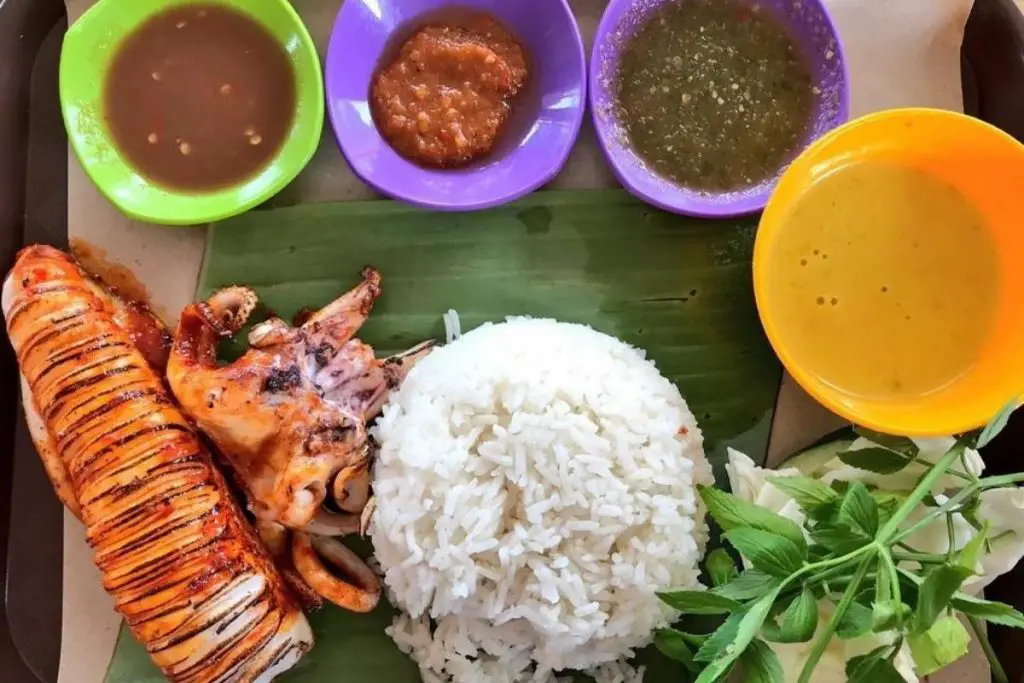
Nasi Dulang Daun Pisang is a spicy Malay rice dish served on a banana leaf in a tray.
The set meal consists of a bowl of masak lemak (yellow curry), three to four types of sambals, and meat (fried chicken, fried tilapia, seafood like grilled squid, or beef).
You can find it in Nasi Dulang Daun Pisang restaurants.
- Eat As: Main meal
- Where to Eat: Nasi Dulang Daun Pisang restaurant
- Main Ingredients: Rice, meat (chicken, tilapia, squid, or beef), masak lemak, sambals,
- Cuisine: Malay
Noodle Dishes in Malaysia: Best Malaysian Foods
16. Char Kuey Teow (Fried Flat Rice Noodle)
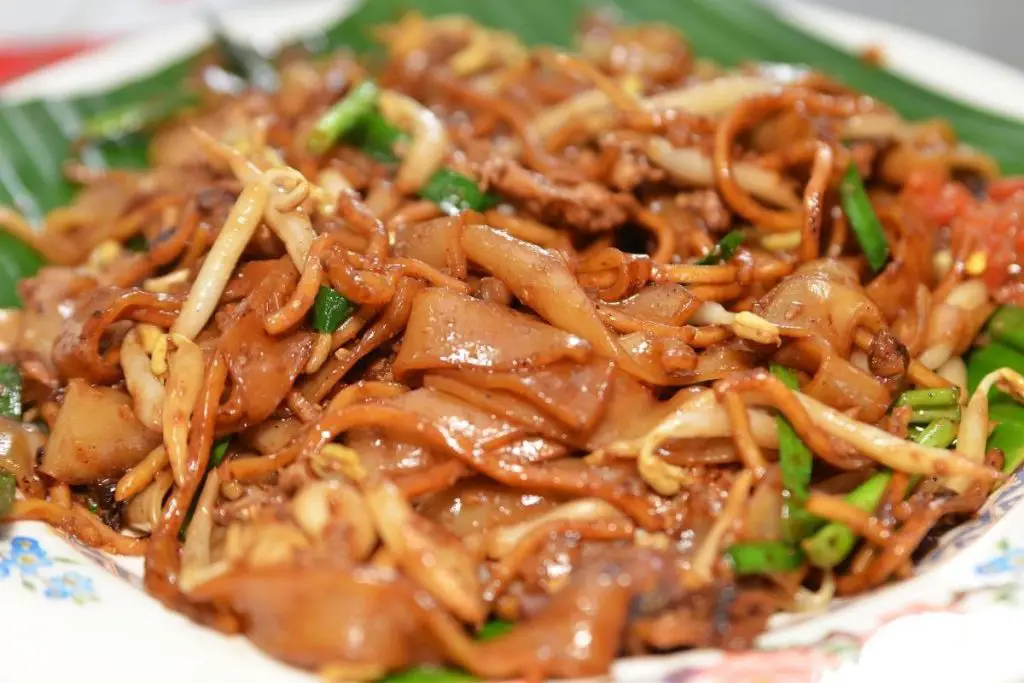
Char kuey teow is one of the most popular noodle dishes in Malaysia brought in by China’s migrants, and is also one of the best foods in Penang, Malaysia.
The dish is made by frying the flat rice noodles and ingredients like dark soy sauce, egg, shrimp, bean sprouts, Chinese chives, cockles, chilli, and sometimes pork lard.
It is stir-fried on high heat in a wok to produce “wok hei” (a smoky flavour and aroma), which is what a good char kuey teow should have.
Due to its popularity, you can find it easily in hawker centres and restaurants.
Some of the best char kuey teow can be found in Penang, followed by Kuala Lumpur and Selangor.
- Eat as: Main meal
- Where to Eat: Hawker centre, food court, restaurant
- Main ingredients: Flat rice noodles, egg, shrimp, bean sprouts, dark soy sauce, chilli, Chinese chives, cockles
- Cuisine: Chinese
17. Wanton Mee (Wonton Noodles)
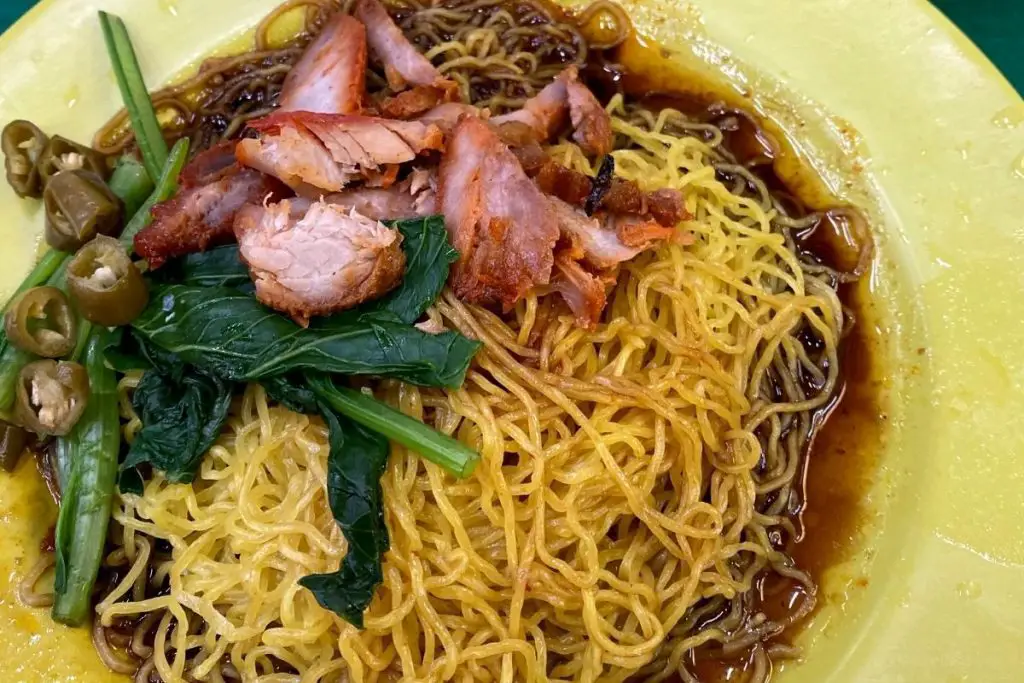
Wanton mee is one of Malaysia’s top foods that can be enjoyed all day!
It is made by boiling the springy egg noodles in a large pot, and then quickly dip into cold water and back into hot water again to make the noodles springy.
Then, the noodles are put into a bowl filled with sticky dark soy sauce and stirred evenly.
It has a dry and soup version, but I prefer the dry version as it is more mouth-watering.
The dish is served alongside char siew (BBQ pork), boiled or fried wonton, choy sum, pickled chillies, scallions, and sometimes fried pork lard.
You can find some of the best wanton mee in Kuala Lumpur, Selangor, Penang, and more.
- Eat As: Main meal
- Where to Eat: Hawker centre, food court, restaurant, roadside stall
- Main Ingredients: Egg noodles, char siew, wonton, choy sum, picked chillies, scallions, pork pard
- Cuisine: Chinese
18. Hokkien Mee (Stir-fried Thick Yellow Noodles)
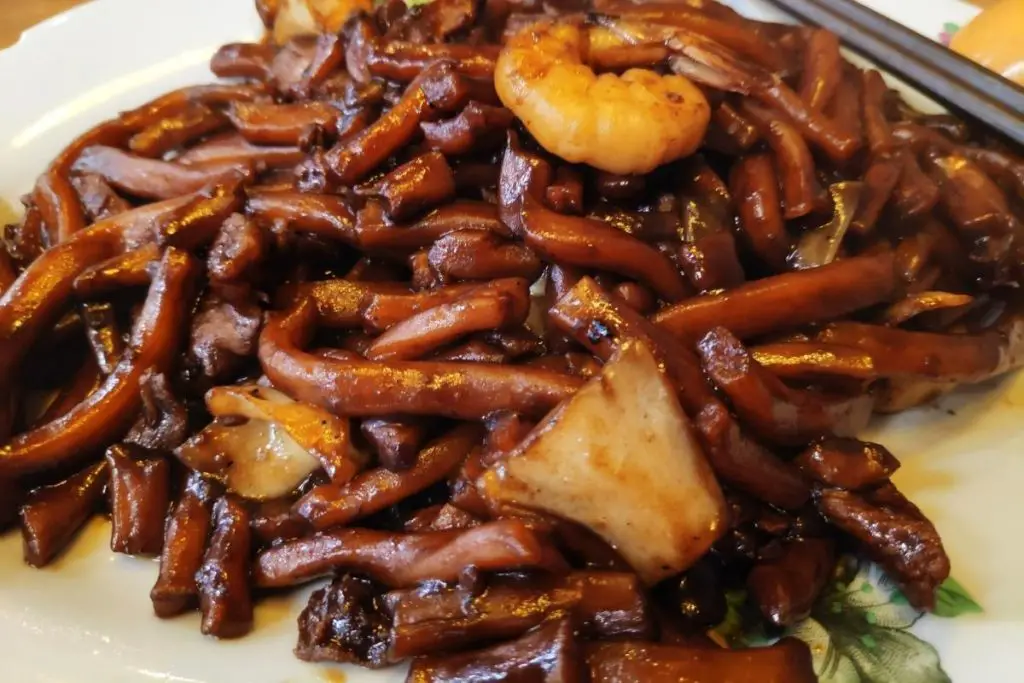
Hokkien mee is a famous noodle dish from Kuala Lumpur, Malaysia.
It is known for its fragrance smell and dark appearance.
The dish is made by stir-frying thick yellow noodles (tai lok mee) and ingredients like sliced pork, deep-fried pork lard, prawn meat, cabbage, and sauces (oyster and dark soy sauces) in a wok under high heat.
It is served with a small plate of sambal belacan (spicy shrimp paste), which is great when eating with the Hokkien mee.
What determines good Hokkien mee is the taste, “wok hei” (smoky aroma) and crispy pork lard.
You can find it in Hokkien mee restaurants, hawker centres, and Chinese seafood restaurants.
- Eat As: Main meal
- Where to Eat: Hokkien Mee restaurant, hawker centre, food court, Chinese seafood restaurant
- Main Ingredients: Egg noodles, char siew, wonton, choy sum, picked chillies, scallions, pork pard
- Cuisine: Chinese
19. Curry Laksa/Curry Mee (Noodles in Curry Soup)
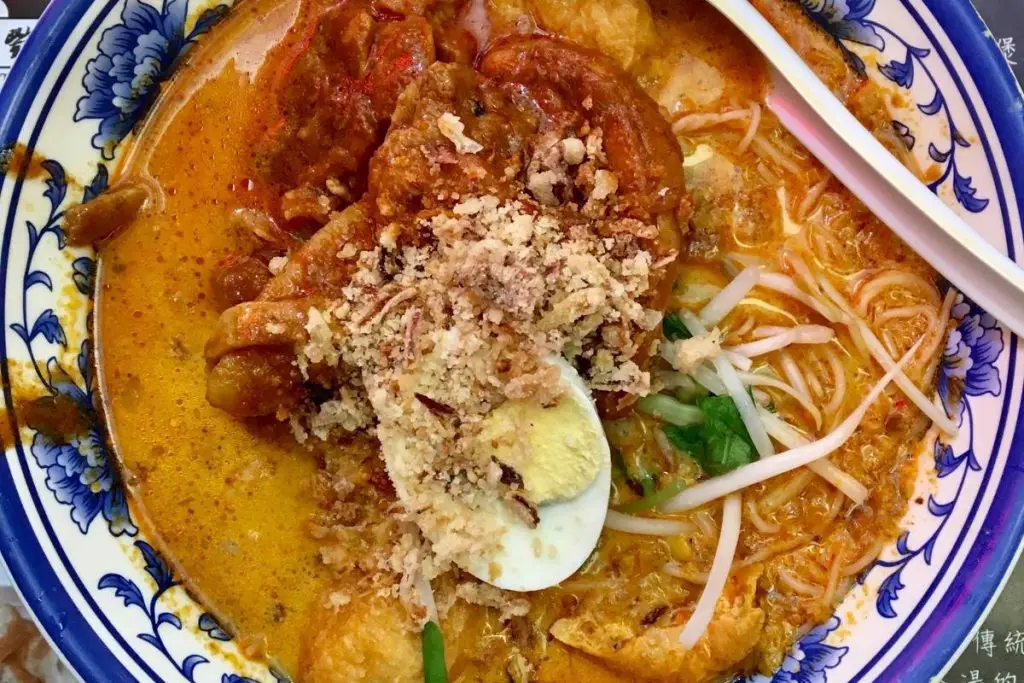
Curry laksa (also known as curry mee) is a popular noodle soup dish in Malaysia which consists of noodles, curry soup and sides.
The best part about the dish is the rich, spicy and creamy curry soup made with coconut milk and spices.
It comes with choices of noodles like yellow noodles, rice vermicelli (bihun), and thick laksa rice noodles. You can also ask for mixed noodles.
It is often accompanied by bean curd, deep-fried tofu, lemongrass, bean sprouts, half of a hard-boiled egg, shrimp, chicken, char siew (BBQ pork), cockles (kerang), congealed pork blood cubes, and a spoonful of sambal belacan.
- Eat As: Main meal
- Where to Eat: Hawker centre, food court, restaurant
- Main Ingredients: Noodles, bean curd, deep-fried tofu, lemongrass, bean sprouts, hard-boiled egg, shrimp, chicken, char siew (BBQ pork), cockles, sambal belacan
- Cuisine: Chinese
20. Mee Goreng Mamak (Mamak-style Fried Noodles)
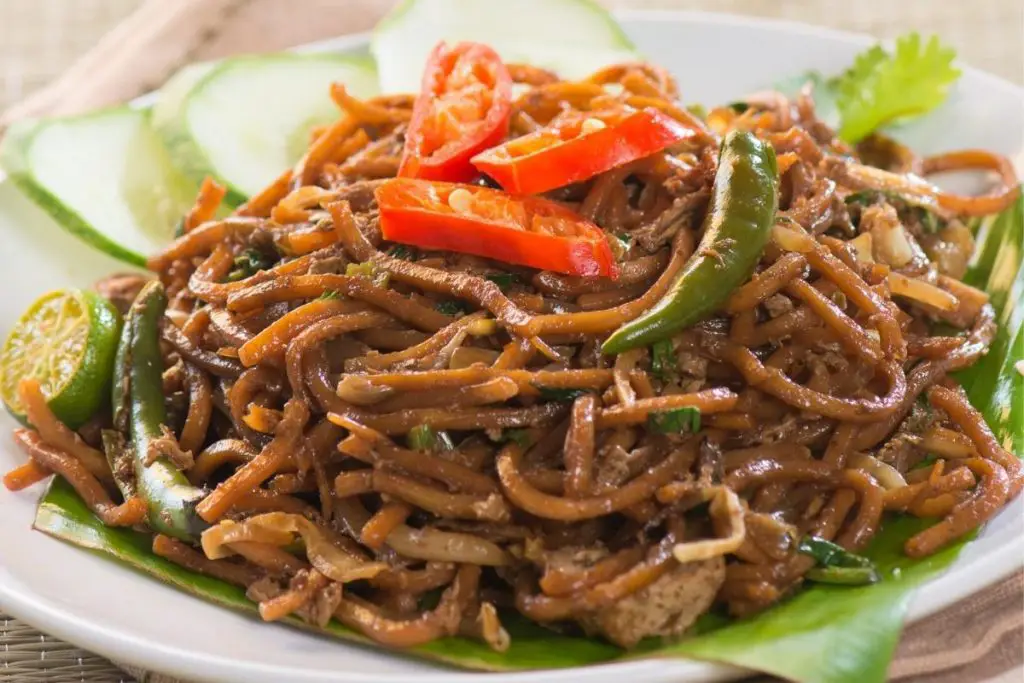
Mee Goreng Mamak is a spicy and savoury stir-fry noodle dish that you can find in Mamak and some restaurants and street stalls across Malaysia.
The Malaysian’s favourite dish consists of yellow noodles, fish cakes, chicken, shrimp, veggies, eggs, sweet soy sauce, and chilli. It is usually served with toppings like lime juice and crispy fried onions.
To me, it tastes better than normal mee goreng.
- Eat As: Main meal
- Where to Eat: Mamak
- Main Ingredients: Yellow noodles, fish cakes, chicken, eggs, shrimp, veggies, garlic, scallions, chilli, sweet soy sauce.
- Cuisine: Indian
21. Kolo mee/Kolok Mee (Sarawak Dry Noodles)
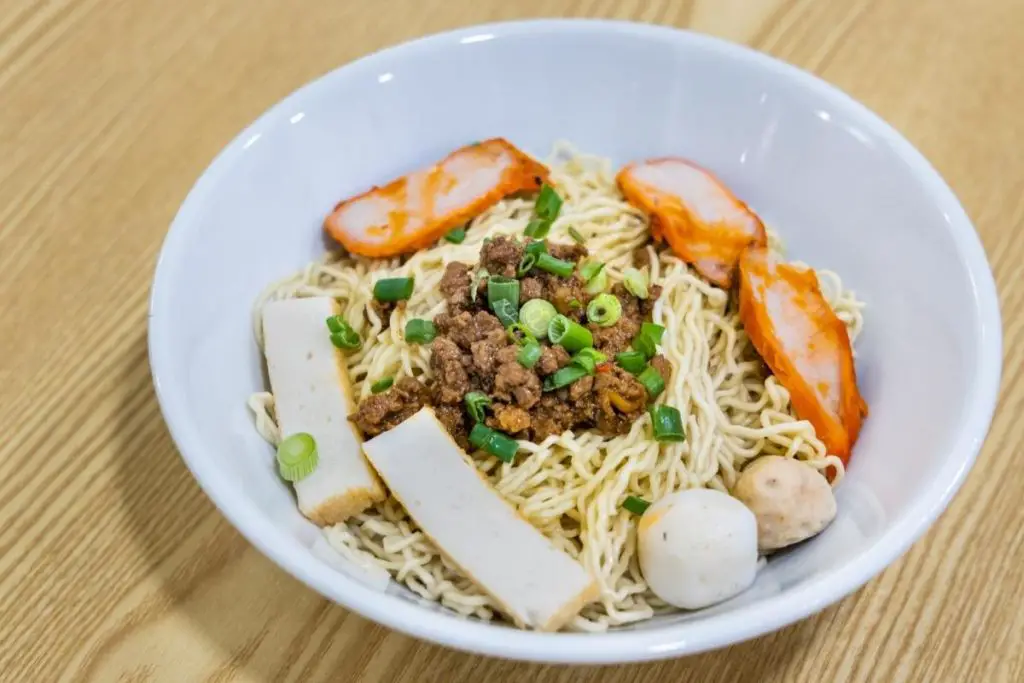
Kolo mee is a famous noodle dish from Sarawak, Malaysia.
The dish is made by mixing the boiled springy egg noodles with sauce and then add in minced pork, char siew (BBQ pork), sliced pork, sliced chicken, fish ball, choy sum, fried onions, wonton, shrimp, and sometimes pork lard.
You can enjoy the dish at hawker centres and restaurants.
- Eat As: Main meal
- Where to Eat: Hawker centre, food court, restaurant
- Main Ingredients: Mutton, celery stalk, onions, ginger, herbs, and spices
- Cuisine: Borneo
22. Penang Hokkien Mee/Prawn Mee (Prawn Noodle Soup)
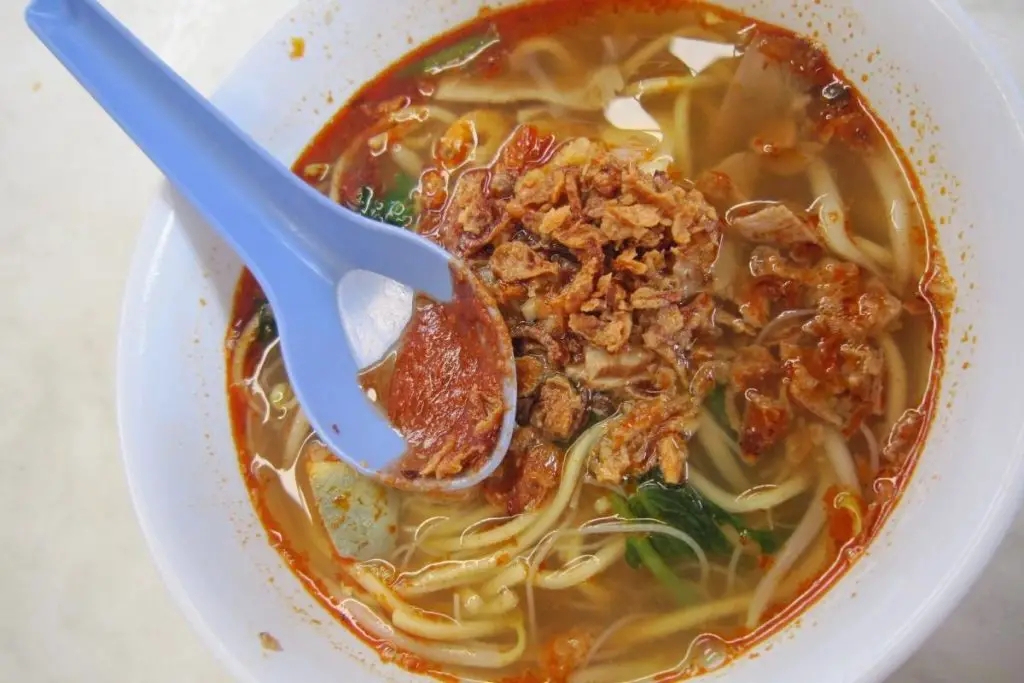
Penang Hokkien Mee is a famous prawn noodle dish in Malaysia. Hokkien mee in Penang is known as Har Mee or prawn mee in other states.
The dish is made with a combination of mee hoon (rice vermicelli) and yellow noodles, topped with sliced pork, shrimps, bean sprouts, kangkong, hard-boiled egg, and fried shallots, and filled with a broth that is flavourful, spicy and rich in umami.
The star of the dish is the umami-rich broth made from prawn heads, pork ribs, and shrimp.
You can find it at hawker centres and restaurants.
- Eat As: Main meal
- Where to Eat: Hawker centre, food court, restaurant
- Main Ingredients: Noodles, pork, shrimp, bean sprouts, kangkong, egg, shallots
- Cuisine: Chinese
23. Pan Mee (Hakka Flat Noodles)
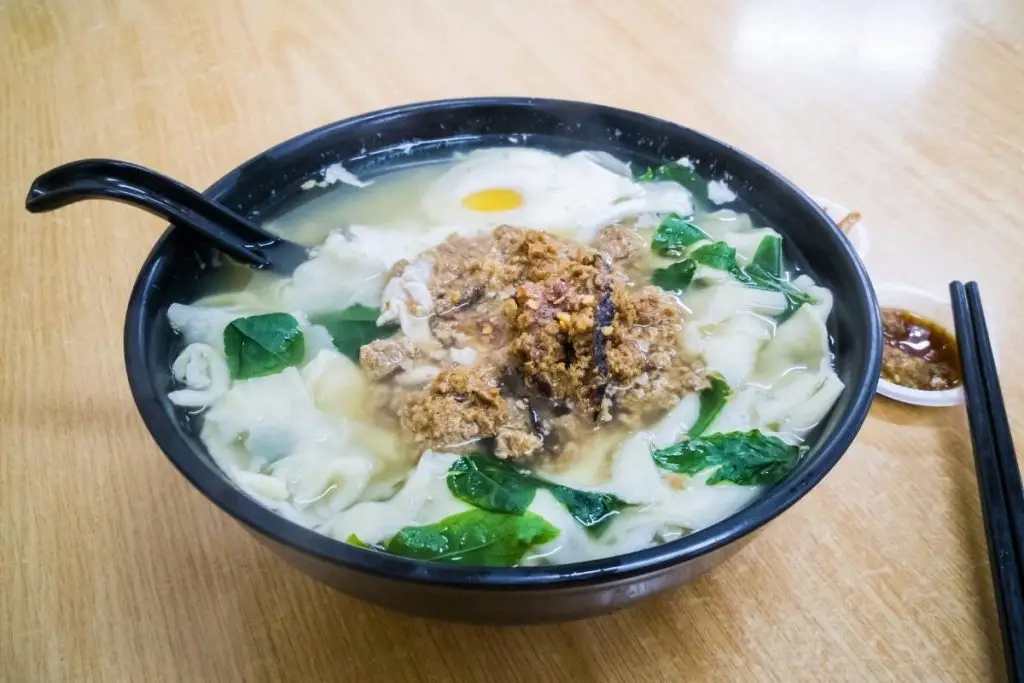
Pan mee is a popular noodle dish in Malaysia that comes in different versions like soup pan mee (served in rich anchovy broth), dry pan mee (with dark sauce), chilli pan mee (with chilli flakes), and stir-fried pan mee.
The noodle can be in a flat or thin form made by machine or hand-pulled form pinch by hand.
The dish consists of noodles (pan mee), minced pork, mushrooms, fried anchovies, a poached egg, and leafy greens, and is served with chilli sauce.
You can find pan mee in hawker centres, pan mee restaurants and restaurants.
- Eat As: Main meal
- Where to Eat: Hawker centre, food court, restaurant, roadside stall
- Main Ingredients: Noodles, pork, mushrooms, fried anchovies, egg, leafy greens
- Cuisine: Chinese
24. Chee Cheong Fun (Steamed Rice Noodle Rolls)
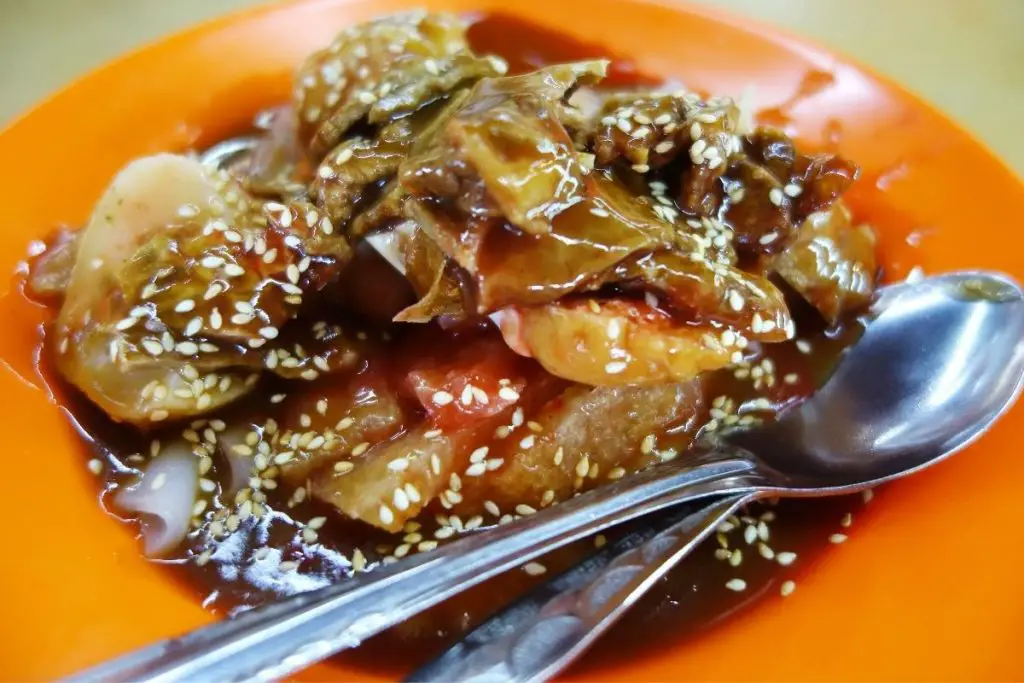
Chee Cheong Fun is a popular Cantonese dish in Malaysia that is enjoyed by local Chinese.
The rice noodle rolls are steamed and served with other ingredients like pork ball, fu zhok (fried bean curd), fish cake, and sausage, and topped with sweet sauce or/and chilli sauce and white sesame.
There are other versions of chee cheong fun that use flat rice noodles instead of rolls and are filled with shrimp or minced char siew (BBQ pork).
It is also eaten as a side or snack in dim sum or yong tau foo.
There is also a Malay version of chee cheong fun that is halal and comes with many choices of sides.
You can find it in hawker centres, night markets, dim sum restaurants, and yong tau foo restaurants.
- Eat As: Main meal, snack
- Where to Eat: Hawker centre, restaurant
- Main Ingredients: Rice noodles, pork ball, fu zhok (fried bean curd), fish cake, sausage, hoisin sauce
- Cuisine: Chinese
25. Asam Laksa/Assam Laksa/Penang Laksa (Spicy Sour Noodle Soup)
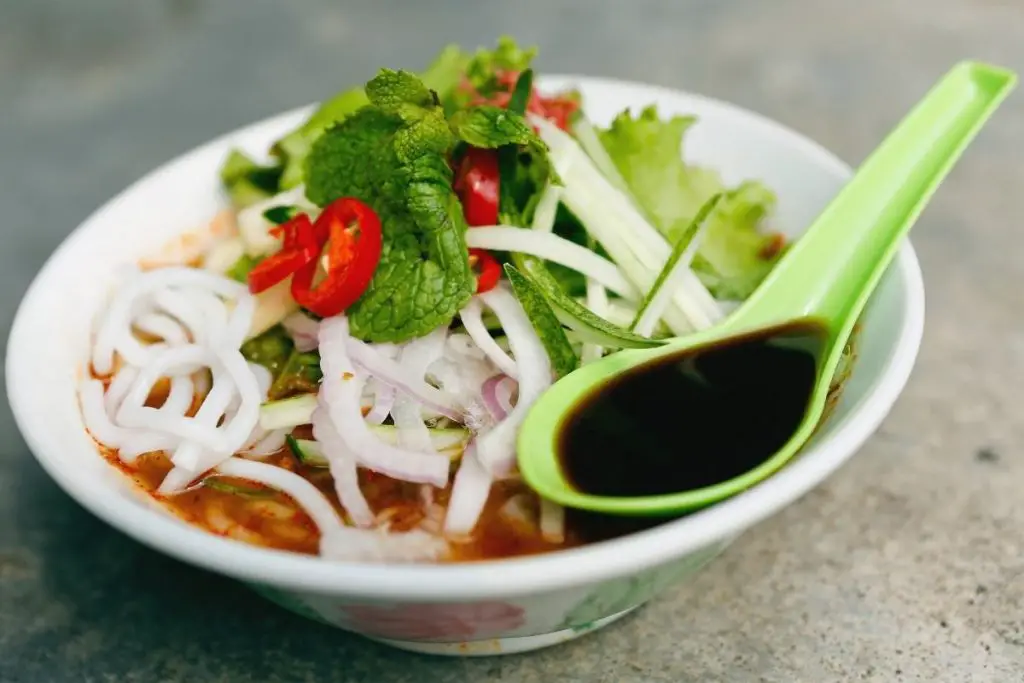
Asam Laksa also known as Penang Laksa and is one of the most famous dishes in Nyonya cuisine.
What makes it unique is the sour, spicy, sweet, savoury, sharp-tasting, and tangy fish broth, in which the flavours come from tamarind (asam).
The asam laksa is a bowl of thick rice noodles served with sour and spicy fish broth made by boiling the mackerel fish bones, herbs and spices.
It is often accompanied by shredded mackerel fish meat, vegetables like onion, mint leaves, lettuce, pineapple, red chilli, torch ginger and cucumber, and shrimp paste (hae ko).
Asam laksa is a must-try food when you are visiting Penang. Of course, you can also find some of the best asam laksa in Kuala Lumpur and other states.
- Eat As: Main meal
- Where to Eat: Hawker centre, food court, restaurant, roadside stall
- Main Ingredients: Rice noodles, tamarind, mackerel, onion, mint leaves, lettuce, pineapple, red chilli, torch ginger, cucumber, shrimp paste
- Cuisine: Nyonya
26. Sarawak Laksa (Sarawak Noodle Soup)
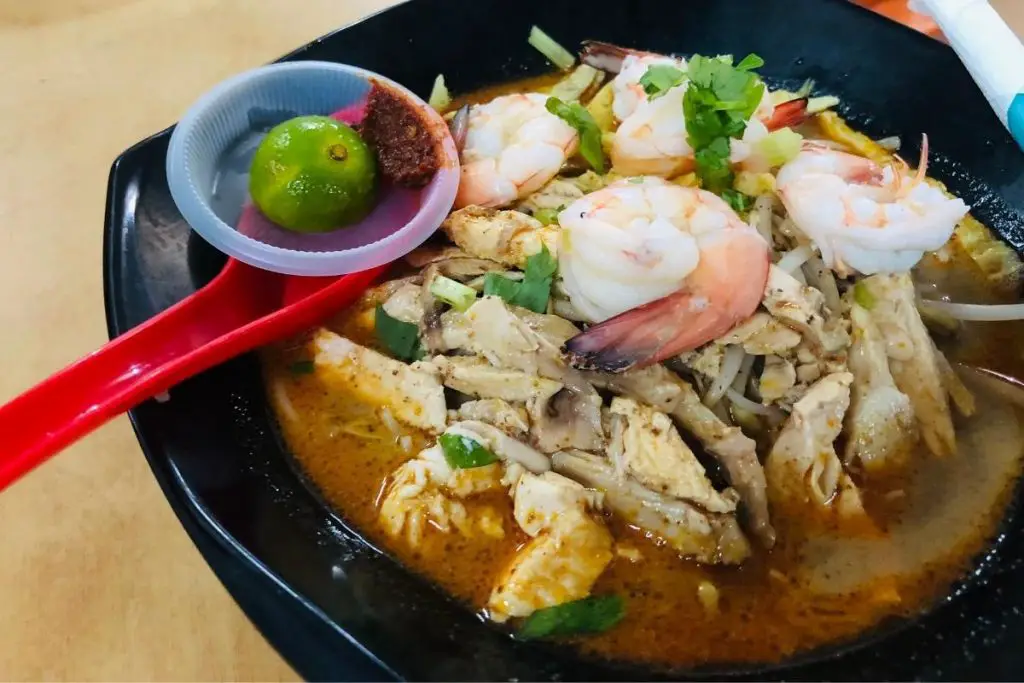
Sarawak laksa is a popular dish from Sarawak, Malaysia.
It uses coconut milk as the broth and is usually served with thick rice noodles or bihun (rice vermicelli noodles).
The dish is accompanied by chicken strips, shrimp, bean sprouts, and slivers of omelette.
It is often eaten as breakfast, but it is suitable to eat for lunch and dinner as well.
- Eat As: Main meal
- Where to Eat: Hawker centre, food court, restaurant
- Main Ingredients: Rice noodles, chicken, shrimp, bean sprouts, egg
- Cuisine: Borneo
27. Koay Teow Th’ng (Flat Rice Noodles Soup)
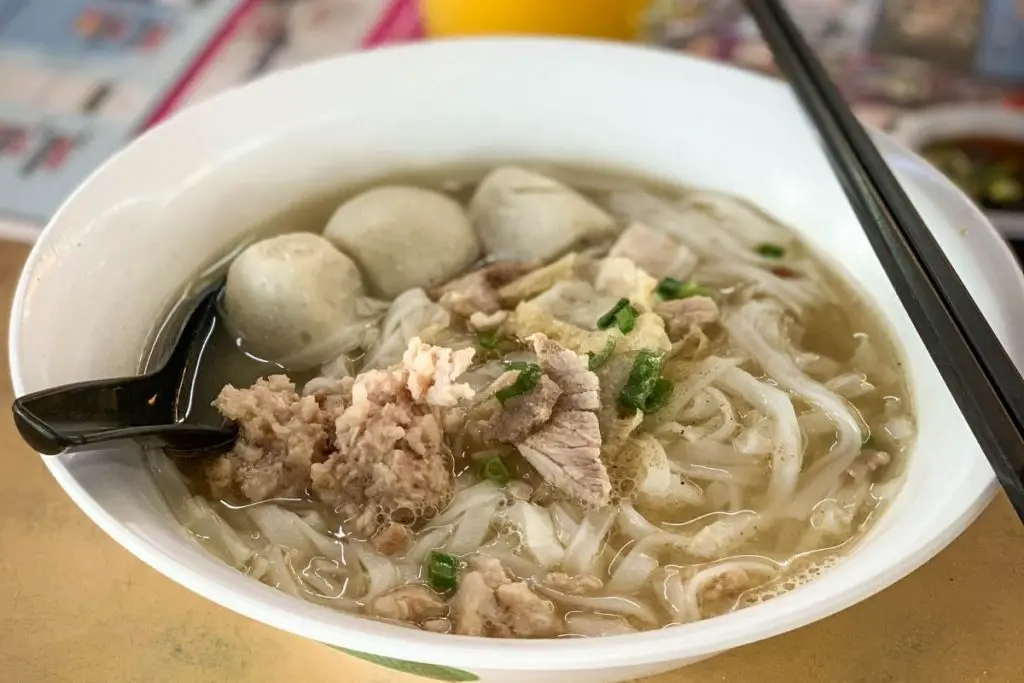
Koay Teow Th’ng is a famous Chinese noodle soup dish in Penang, Malaysia.
It is made by cooking flat rice noodles with a clear broth.
It is often served with sides like fish balls, meat (chicken, pork or duck), scallions, and vegetables.
- Eat As: Main meal
- Where to Eat: Hawker centre, food court, restaurant
- Main Ingredients: Rice noodles, fish ball, meat (chicken, pork, duck), scallions, vegetables.
- Cuisine: Chinese
28. Kway Chap/Kuey Chap/Kuay Chap (Teochew Noodle Soup)
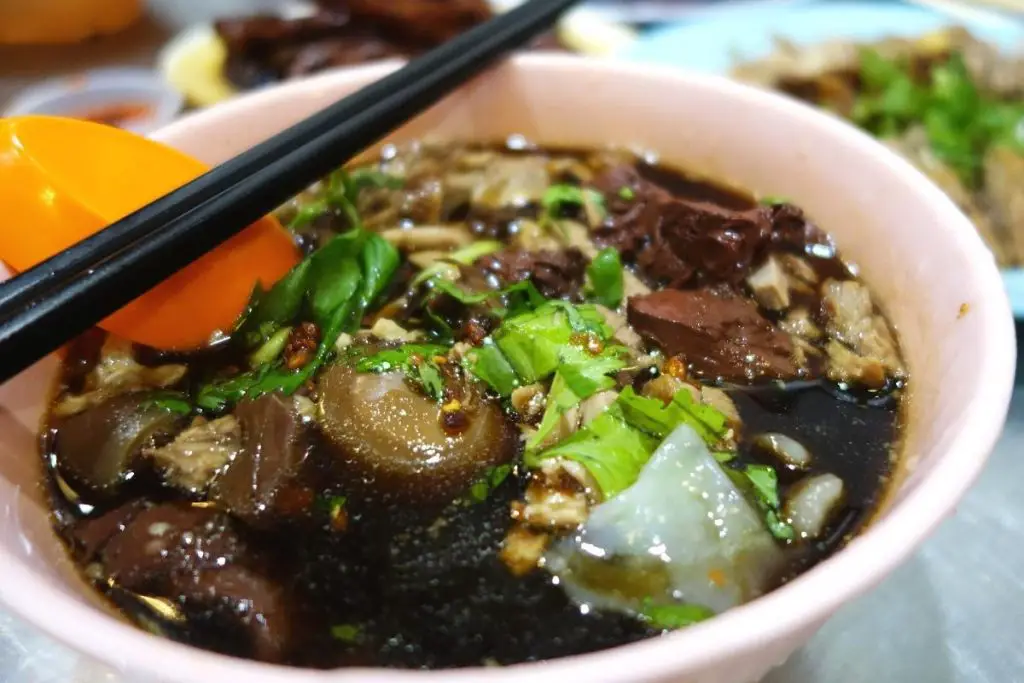
Kway chap is a Teochew noodle soup that is popular in Sarawak, Penang and Johor.
The dish uses broad and flat rice noodles (known as kway) and is served in a flavourful soup made with dark soy sauce, meat and spices.
It is often served with ingredients like braised duck meat, pork, fish cake, braised hard-boiled eggs, beancurd, preserved salted vegetables, coagulated blood, and an assortment of pork cuts such as pork belly, intestines, offal, and pig’s ear.
- Eat As: Main meal
- Where to Eat: Hawker centre, food court, restaurant
- Main Ingredients: Rice noodles, duck, pork, fish cake, egg, beancurd, preserved salted vegetables, coagulated blood, pork cuts (pork belly, intestines, offal, pig’s ear), dark soy sauce
- Cuisine: Chinese
29. Lor Mee (Thick Yellow Noodles in a Thick Starchy Gravy)
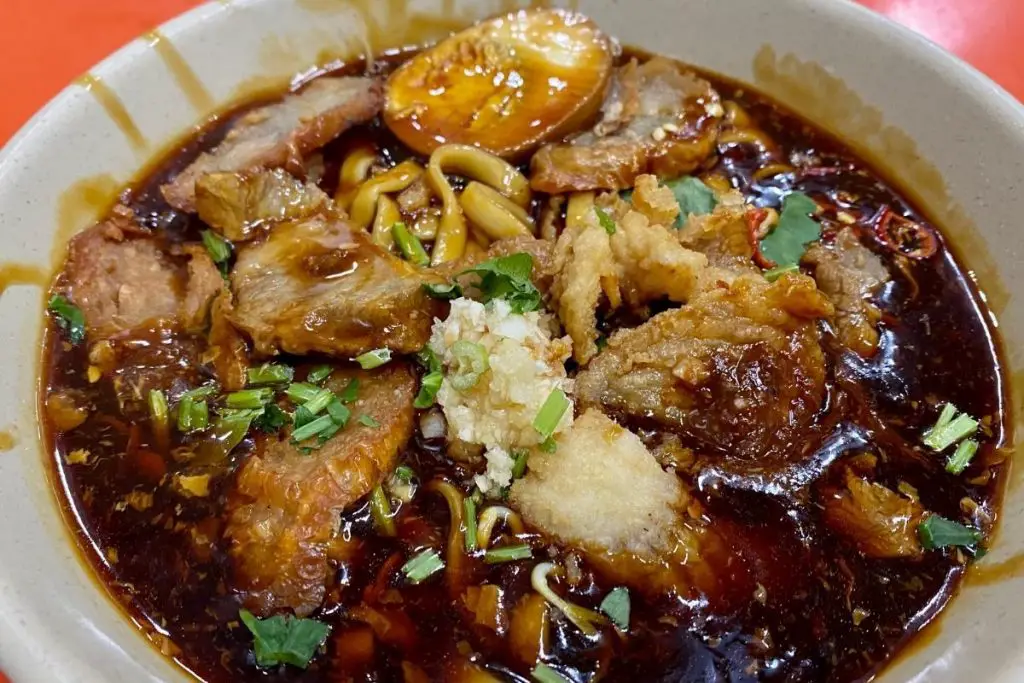
Lor mee is a famous noodle dish in Malaysia that consists of thick yellow noodles (tai lok mee) in a thick starchy gravy made with corn starch, eggs, spices, sauces, and water.
It is served with ingredients like pork, fish cakes, prawns, and choy sum.
The best way to eat lor mee is to add in the black vinegar (usually provided with the dish) and eat with deep-fried pork lard (can request from the stall vendor).
You can find lor mee in hawker centres and restaurants.
- Eat As: Main meal
- Where to Eat: Hawker centre, restaurant, food court, roadside stall
- Main Ingredients: Noodles, corn starch, egg, pork, fish cakes, shrimp, choy sum
- Cuisine: Chinese
30. Fish Head Noodles
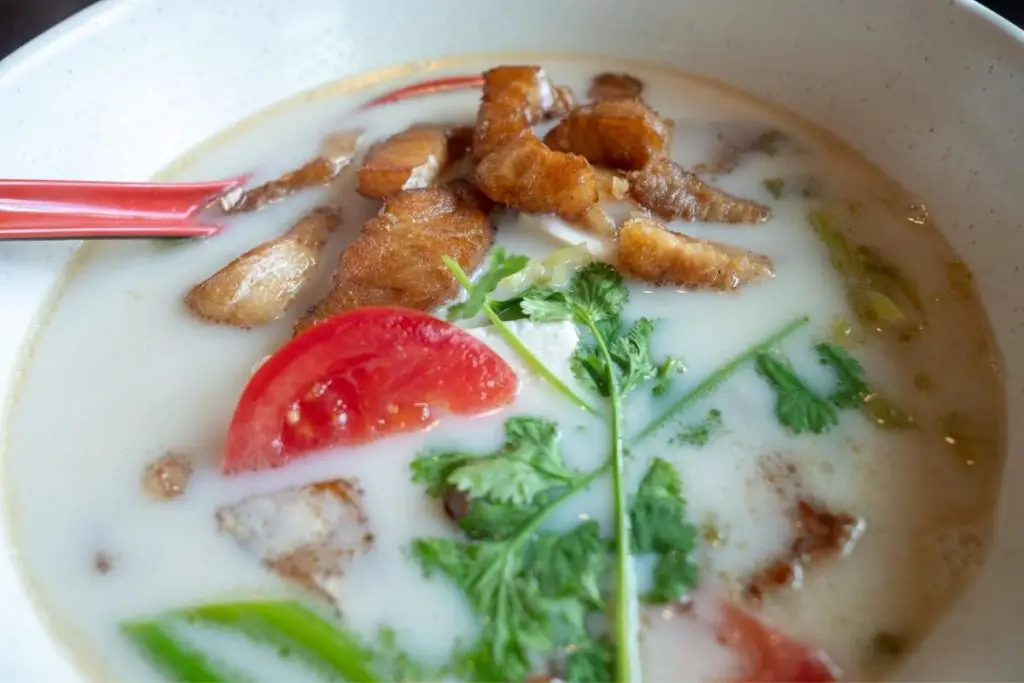
Fish head noodles is a savoury and milky noodle soup dish that consists of deep-fried fish head chunks/fish fillets (usually grouper), lai fun (thick rice noodles), preserved vegetables, tomatoes, fried shallots, spring onions, and milky broth made from evaporated milk and fish bones.
Some fish head noodles stall also sell other soup bases like curry and tom yam.
You can find the dish in hawker centres and food courts.
- Eat As: Main meal
- Where to Eat: Hawker centre, food court, restaurant, roadside stall
- Main Ingredients: Rice noodles, fish, preserved vegetables, tomato, shallot, spring onion, evaporated milk
- Cuisine: Chinese
31. Maggi Goreng (Stir-fried Instant Noodles)
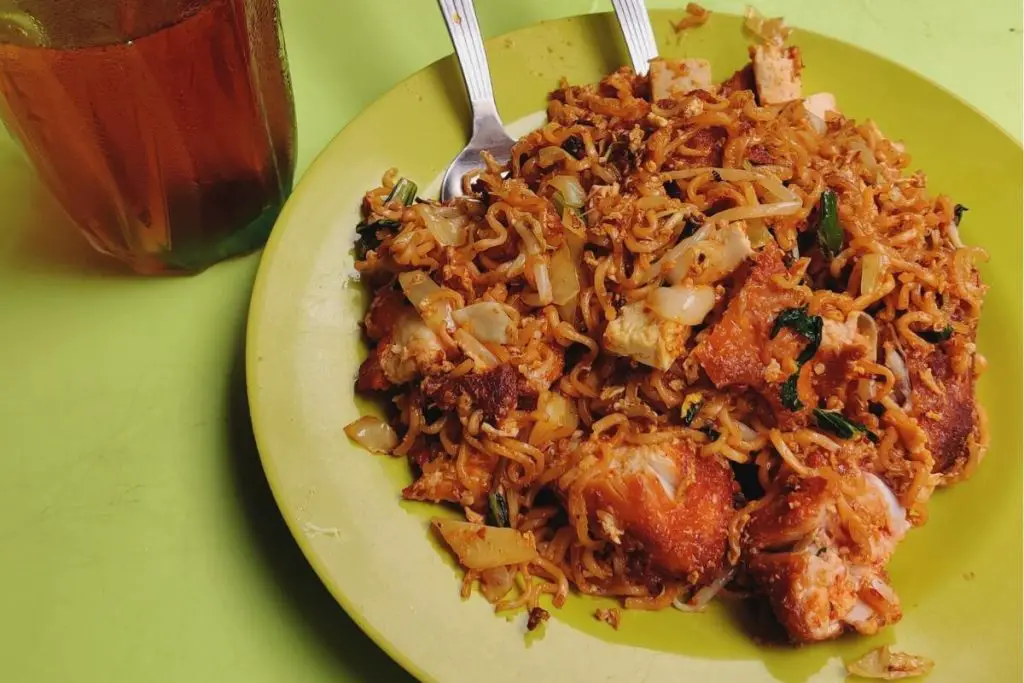
Maggie Goreng is another popular dish to eat in Mamak stalls in Malaysia.
The Maggie is instant noodles from brands like Indomie, Maggi and Mi Sedaap.
The dish is made by stir-frying the boiled maggie noodles, ingredients like eggs, chicken, tofu, vegetables, and soy sauce, and the seasonings in the pack of instant noodles.
The dish is often eaten with add-ons like telur mata kerbau (an egg sunny side up) and fried chicken.
- Eat As: Main meal
- Where to Eat: Mamak. restaurant, roadside stall
- Main Ingredients: Instant noodles, egg, chicken, tofu, choy sum, seasoning
- Cuisine: Indian
32. Mee Rebus (Boiled Noodles)
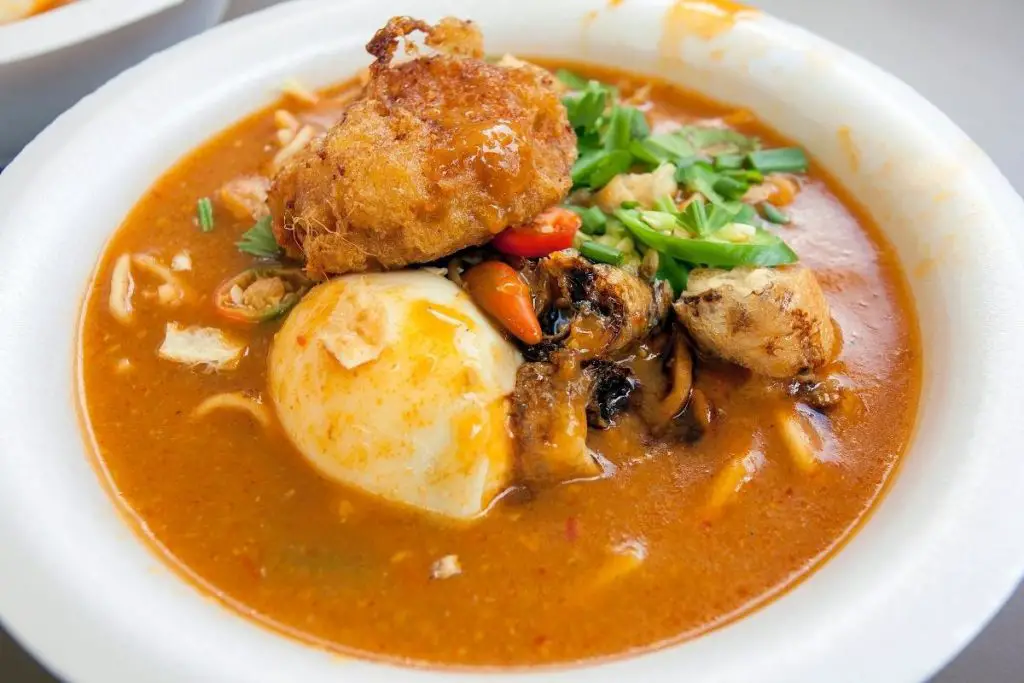
Mee rebus is a Malay-style noodle dish that is made by drowning the boiled yellow noodles in a rich and spicy curry-like gravy.
The gravy is made with shrimp broth, lemongrass, shallots, galangal, and corn starch or mashed potato (to thicken the broth).
It is often served with a hard-boiled egg, fried fish cake, boiled potatoes, chilis, spring onions, fried shallots, lime, and bean sprouts.
- Eat As: Main meal
- Where to Eat: Restaurant, roadside stall
- Main Ingredients: Noodles, shrimp, lemongrass, shallots, galangal, corn starch or mashed potato, egg, fish cake, potato, chilli, spring onions, lime, bean sprouts
- Cuisine: Malay
33. Claypot Lou Shu Fun (Stir-fried Noodles in Claypot)
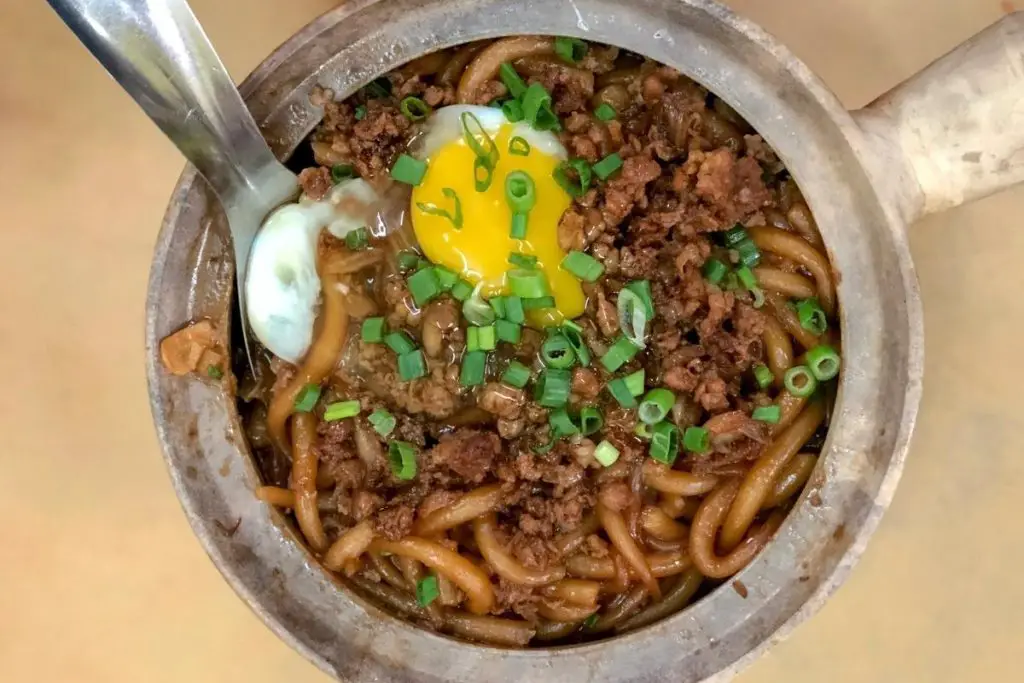
Claypot Lou Shu Fun is a popular noodle dish in Malaysia that use lou shu fun (also known as silver needle noodles), a white, semi-translucent, smooth and shiny noodle made from rice flour and corn starch.
The dish is made by stir-frying the boiled lou shu fun with minced meat, shitake mushrooms, fried salted fish, shallots, garlic, bean sprouts, Chinese cooking wine, soy sauce, dark soy sauce, and oyster sauce, and finally put an egg and served in a heated claypot to retain the heat.
You can find the dish in hawker centres, food courts and restaurants.
- Eat As: Main meal
- Where to Eat: Hawker centre, food court, restaurant
- Main Ingredients: Rice noodles, corn starch, meat (pork or chicken), shitake mushrooms, egg, salted fish, shallots, garlic, bean sprouts, Chinese cooking wine, soy sauce, dark soy sauce, oyster sauce
- Cuisine: Chinese
34. Laksam (Rolled Rice Noodles in Creamy Fish Broth)
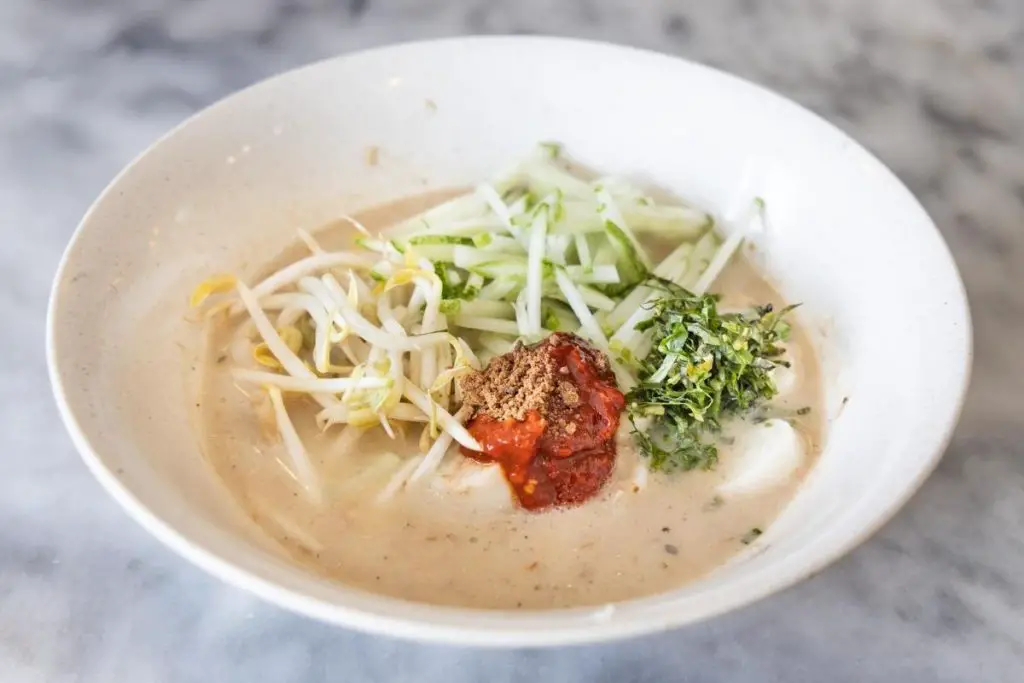
Laksam is a noodle soup dish from Kelantan and Terengganu, Malaysia consisting of rolled rice noodles served in a rich and creamy fish broth made with fish paste and coconut milk.
The rolled rice noodles are made by steaming the thin rice flour batter on a flat skillet and then rolling and slicing into small pieces.
The dish contains ingredients like shallots, garlic, ginger, sliced cucumber, and green beans.
- Eat As: Main meal
- Where to Eat: Restaurant, roadside stall
- Main Ingredients: Rice noodles, fish paste, coconut milk, shallots, garlic, ginger, cucumber, green bean
- Cuisine: Malay
35. Mee Bandung (Muar Noodle Dish)
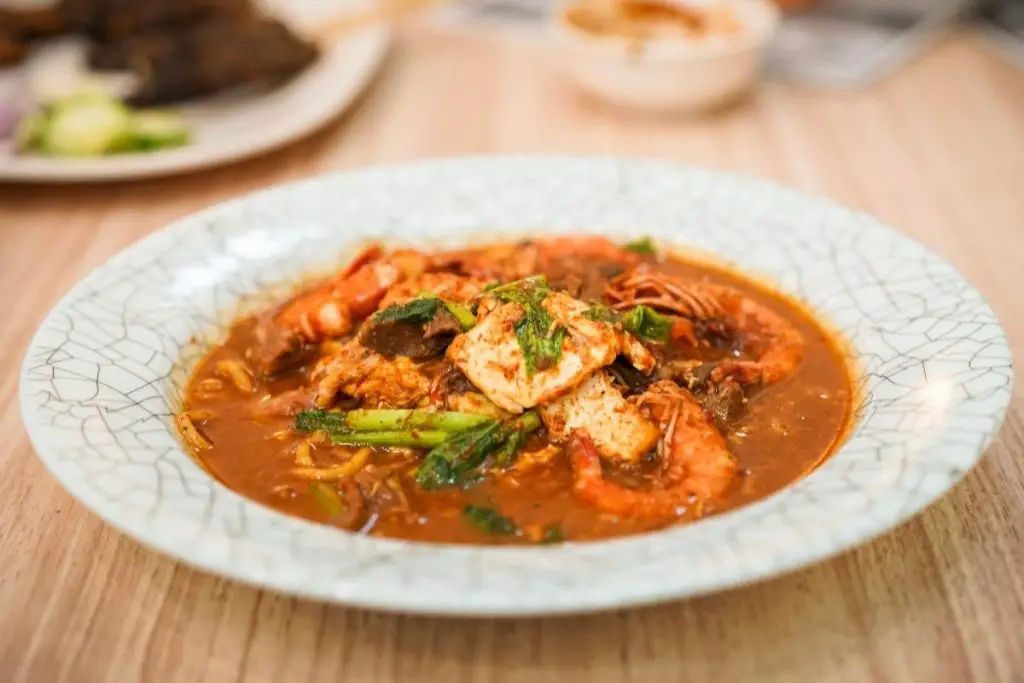
Mee Bandung is a traditional noodle dish from Muar, Johor.
The dish consists of yellow noodles and a thick broth made with dried shrimp, chilli, onions, shrimp paste, tomato sauce, spices, corn starch, and water, accompanied by eggs, prawns, fish cakes, chicken, and vegetables.
You can find the noodle dish at Mee Bandung restaurants.
- Eat As: Main meal
- Where to Eat: Mee Bandung restaurant
- Main Ingredients: Noodles, dried shrimps, chilli, onions, shrimp paste, tomato sauce, corn starch, egg, prawn, fish cakes, chicken, vegetables
- Cuisine: Malaysian
36. Tuaran Mee (Sabah Egg Noodle)
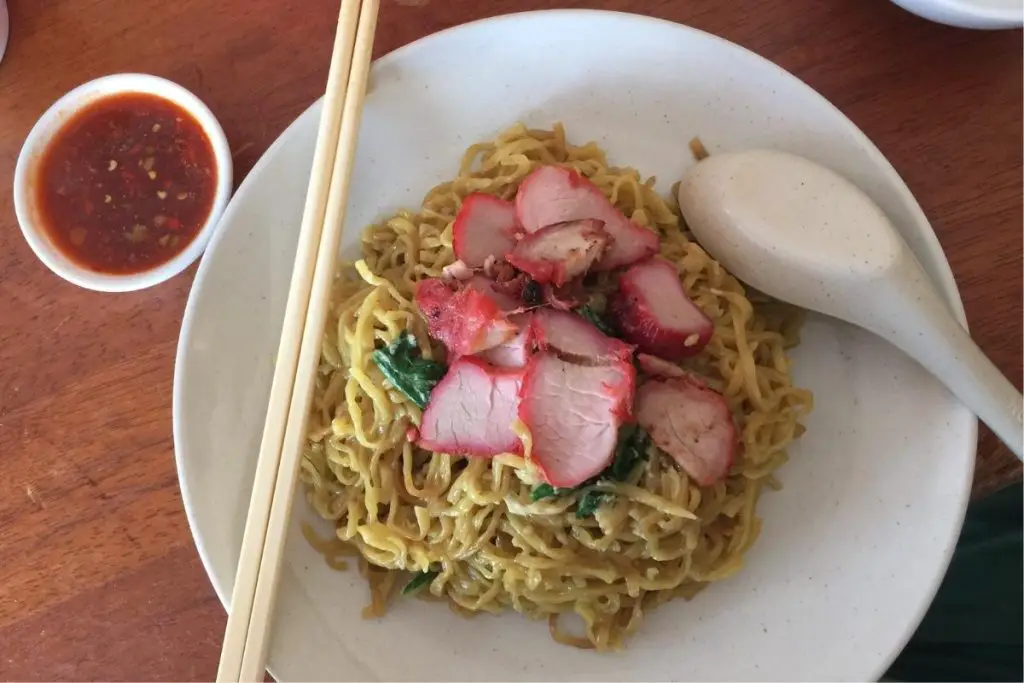
Tuaran mee is one of the popular traditional noodle dishes originating from Tuaran town, Sabah.
The handmade yellow egg noodle is first boiled and then fried to the crispy texture, and then served with slices of pork egg rolls (Chun Kien), char siew (BBQ pork), vegetables, and sometimes the meat marinated in lihing/lehing, a local sweet rice wine.
There is also a beef or chicken version of tuaran mee.
You can find the dish easily across restaurants and hawker centres in Sabah.
- Eat As: Main meal
- Where to Eat: Restaurant, hawker centre, roadside stall
- Main Ingredients: Egg noodles, pork egg rolls (Chun Kien), char siew (BBQ pork), vegetables, meat (chicken, beef), sweet rice wine
- Cuisine: Borneo
37. Sang Nyuk Mee (Sliced Pork Noodle)
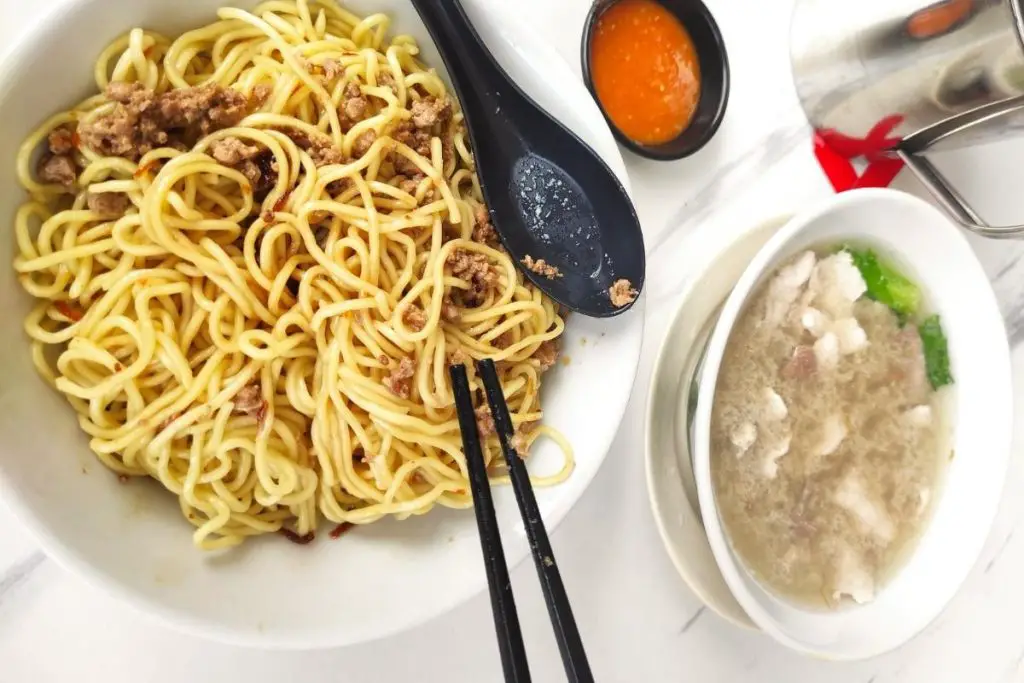
Sang nyuk mee (sliced pork noodle) is one of the local favourite noodle dishes originating from Tawau, Sabah.
The delicious pork noodle dish is consisting of noodles, slices of tender pork meat, pork balls, pork innards, scallions, shallots, and lard served in rich pork soup and chilli paste.
You can also opt for the dry noodles stirred with lard and dark sauce instead of the soup version.
You can find the dish easily across restaurants and hawker centres in Sabah.
- Eat As: Main meal
- Where to Eat: Restaurant, hawker centre, roadside stall
- Main Ingredients: Noodles, pork, pork ball, pork innards, scallion, shallot, lard
- Cuisine: Borneo
38. Ngiu Chap (Borneo Beef Noodle Soup)
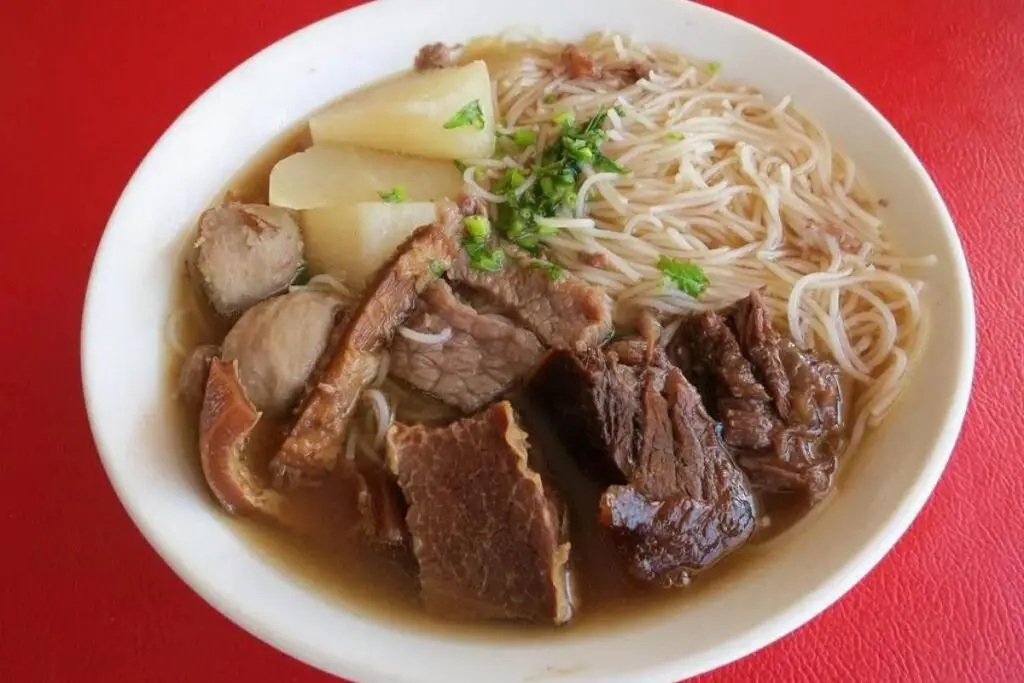
Ngiu Chap is a popular beef noodle soup in Sabah that consists of rice vermicelli noodles and various beef parts including beef livers, intestines, hearts, and tendons of bovines, served in a rich, thick and fragrant beef soup.
It is usually eaten by locals as breakfast or lunch.
You can find the dish across restaurants and hawker centres in Sabah.
- Eat As: Main meal
- Where to Eat: Restaurant, hawker centre, roadside stall
- Main Ingredients: Rice vermicelli, beef parts (livers, intestines, hearts, tendons of bovines)
- Cuisine: Borneo
39. Kampua Mee (Sarawak Dry Straight Noodles)
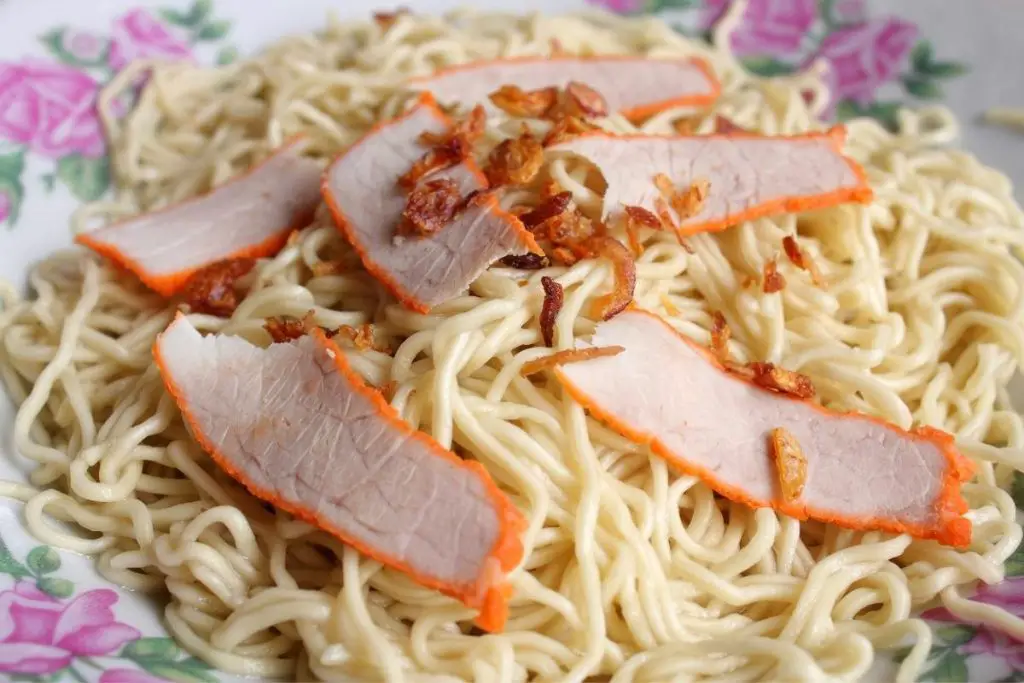
Kampua Mee is another popular noodle dish from Sibu, Sarawak that is similar to kolo mee but is drier and lighter and uses straight egg noodles instead of curly noodles.
The sauce for kampua mee is made with pork lard, fried shallots, white pepper, and soy sauce.
There are two versions of kampua mee, white and black. The difference is the black version use sauce with added dark soy sauce.
The dish is usually topped with slices of char siew and wanton.
You can find the food at stalls and restaurants in Kuching, and Peninsular restaurants that serve Sarawak dishes.
- Eat As: Main meal
- Where to Eat: Restaurant, hawker centre, roadside stall
- Main Ingredients: Egg noodles, pork lard, fried shallots, white pepper, soy sauce, char siew, wanton
- Cuisine: Borneo
40. Belacan Bihun (Rice Vermicelli in Shrimp Paste)
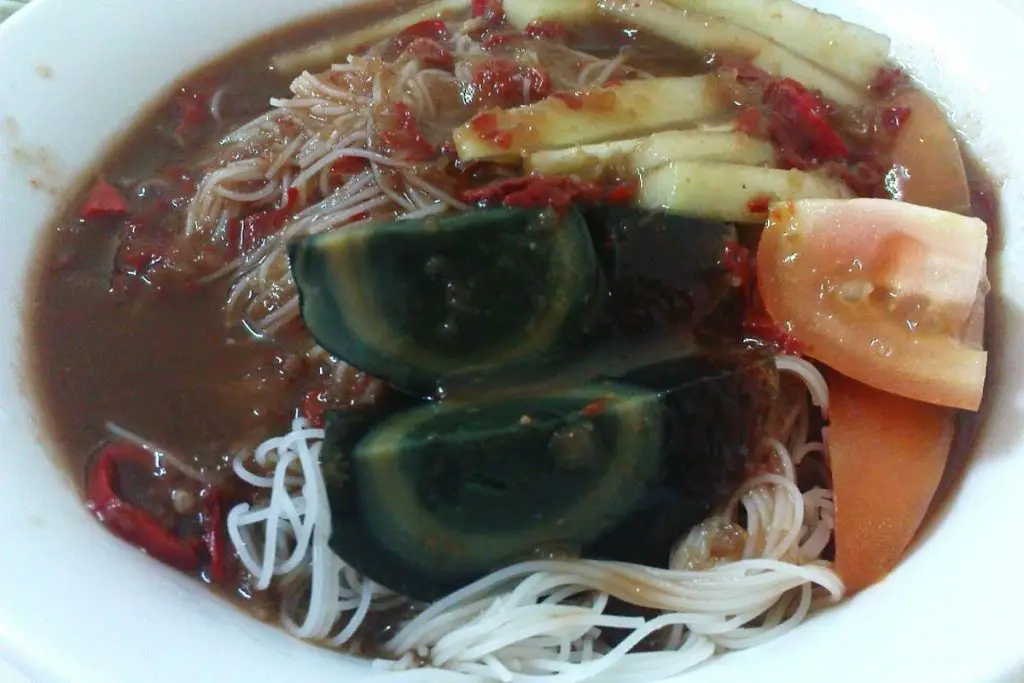
Belacan bihun is a common noodle dish in Sabah that consists of rice vermicelli, cuttlefish slices, telur padi (preserved egg), bean sprouts, onion, cucumber slices, and lime served in a sweet belacan broth (shrimp paste).
You can enjoy the dish at hawker centres and restaurants in Sarawak and Belacan Bihun restaurants in Peninsular.
- Eat As: Main meal
- Where to Eat: Restaurant, hawker centre
- Main Ingredients: Rice vermicelli, cuttlefish, preserved egg, bean sprouts, onion, cucumber, lime, sweet belacan (shrimp paste)
- Cuisine: Borneo
41. Tomato Kuey Teow (Flat Rice Noodles in Tomato-based Gravy)
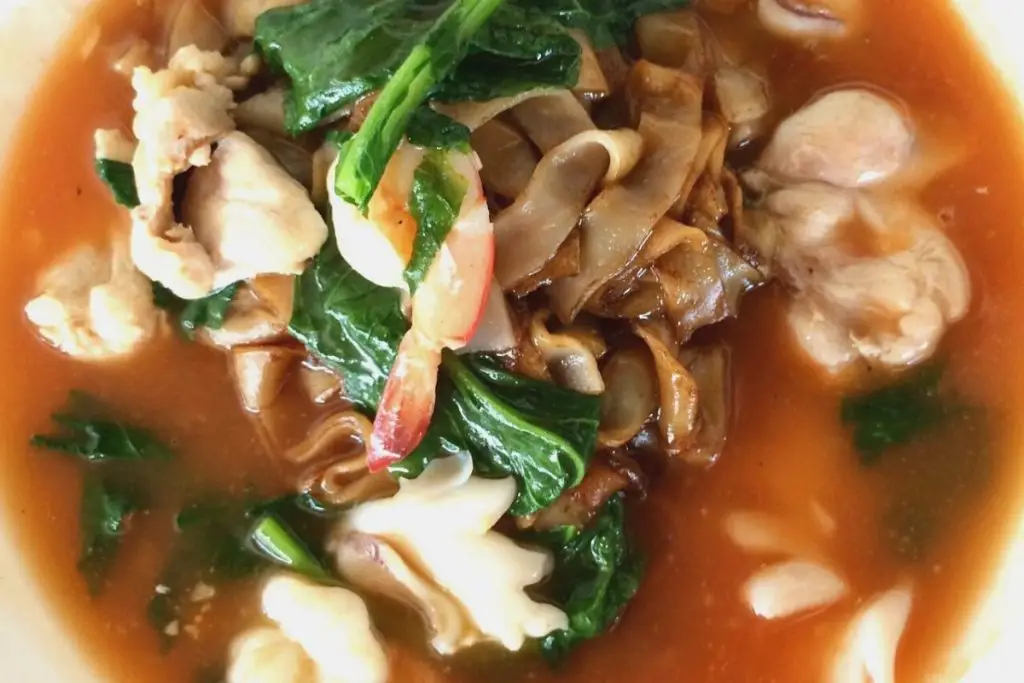
Tomato kuey teow is a popular noodle dish in Sarawak, Malaysia, which consists of flat rice noodles served in sweet tomato-based gravy and ingredients like chicken, seafood and vegetables.
The flat rice noodles can be replaced by other noodles like crispy noodles and mee hoon/bihun.
You can find the dish at stalls and restaurants in Sarawak and Peninsular restaurants that serve Sarawak dishes.
- Eat As: Main meal
- Where to Eat: Restaurant, hawker centre, roadside stall
- Main Ingredients: Rice noodles, chicken, seafood, choy sum, carrot, chicken stock, corn starch, tomato sauce, sweet sauce, oyster sauce, fish sauce, black pepper
- Cuisine: Borneo
42. Mee Sapi (Noodles with Beef-based Broth)
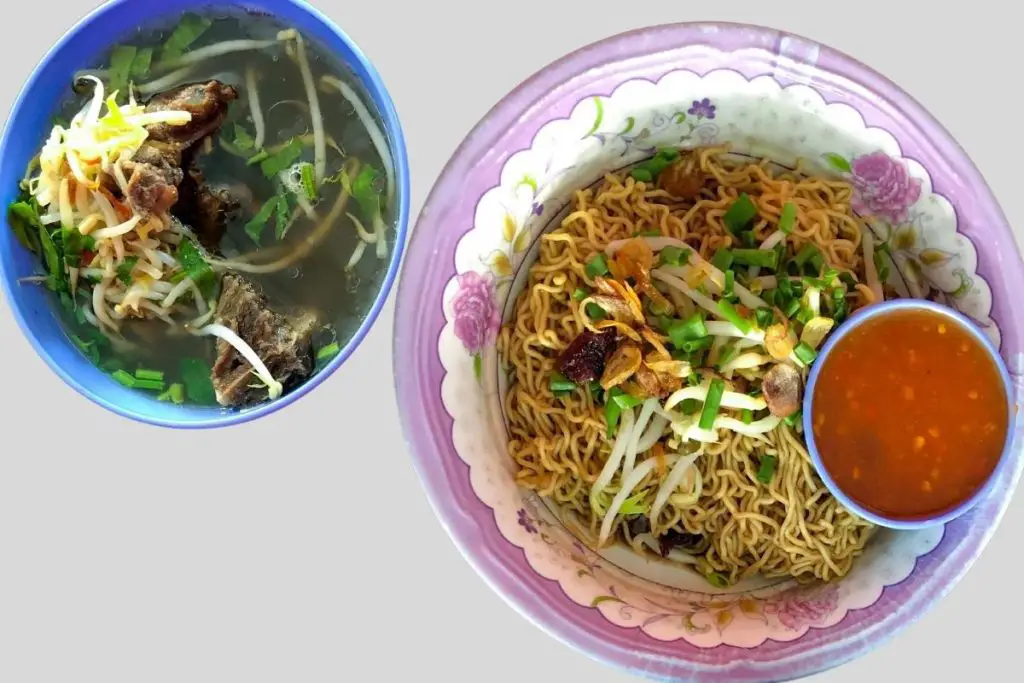
Mee Sapi is a Sarawak noodle dish that consists of noodles served with a bowl of beef-based broth and topped with tender beef slices and crunchy beansprouts.
You can also ask for the beef-based broth to be added directly to the bowl of noodles instead of a separate bowl.
The noodles available are dry noodles, kuey teow (flat rice noodles) and rice vermicelli (bihun).
The flavourful and dark colour beef broth is made by boiling the meat, bones and herbs for hours.
Mee Sapi is similar to kolo mee but uses beef instead of pork.
You can find mee sapi at stalls and restaurants in Kuching, and Peninsular restaurants that serve Sarawak dishes.
- Eat As: Main meal
- Where to Eat: Restaurant, hawker centre, roadside stall
- Main Ingredients: Rice noodles, beef, beansprouts, chilli, parsley, sweet sauce, onion, garlic, ginger, cinnamon stick
- Cuisine: Borneo
Soup Dishes in Malaysia: Best Malaysian Foods
43. Bak Kut Teh (Pork Rib Broth)
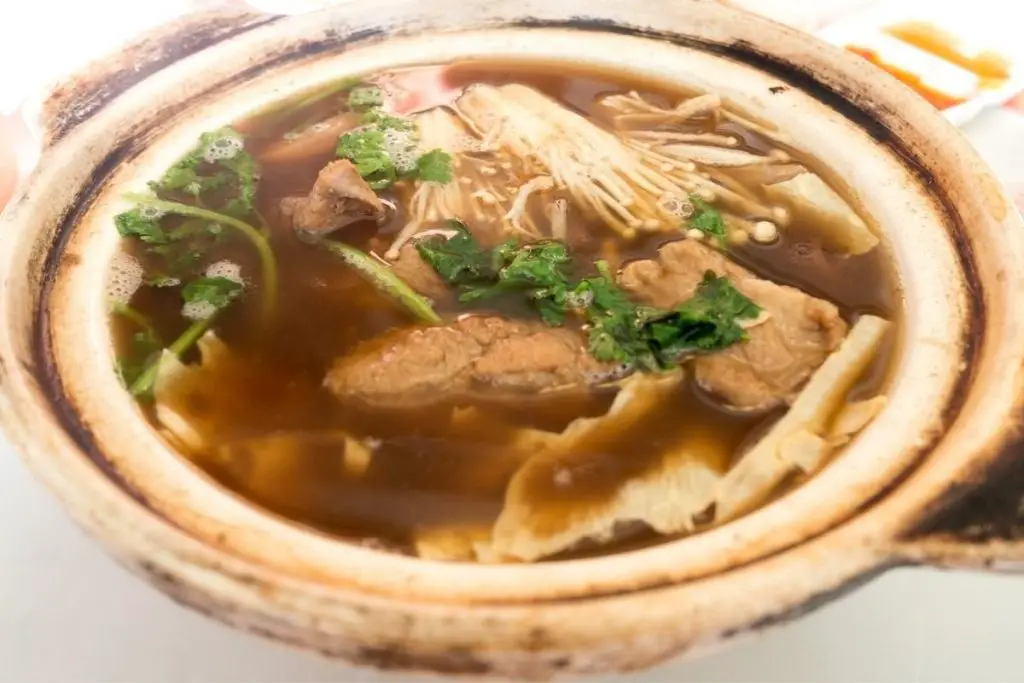
Bak kut teh is a famous pork rib dish in Malaysia that is enjoyed by local Chinese.
It is a large pot full of delicious pork ribs and broth.
Pork ribs are simmered in a savoury and flavourful broth made with herbs like Wolfberry, Chuanxiong, Angelica, and Polygonatum and spices like cinnamon, cloves, star anise, and fennel seeds for hours.
You can also add the pork belly and pork offals such as intestines and stomach.
Bak Kut Teh is often eaten with rice, slices of Youtiao/Yu Char Kway (fried dough), tofu puffs, Enoki mushrooms, shiitake mushrooms, choy sum, and seasonings like soy sauce-minced garlic and chopped red peppers.
Make sure you dip the Youtiao/Yu Char Kway into the broth before eating and don’t forget to drench your rice with the flavourful broth.
For drink, the Chinese-style tea is a perfect match to Bak Kut Teh to relieve oiliness.
There is also a dry version of Bak Kut Teh, but the best one is still the broth version.
You can find the best Bak Kut Teh in Klang, Selangor and Kuala Lumpur.
- Eat As: Main meal
- Where to Eat: Bak Kut Teh restaurant, hawker centre, food court
- Main Ingredients: Pork ribs, pork belly, herbs, spices
- Cuisine: Chinese
44. Sup Kambing (Mutton Soup)
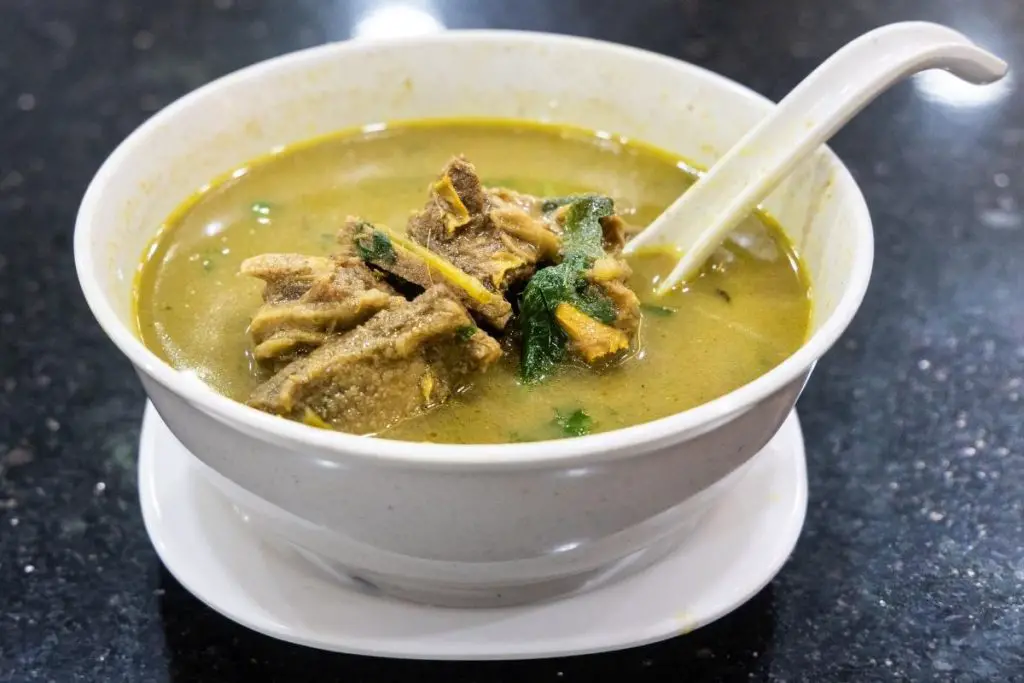
Sup kambing is a mutton soup dish with rich flavours and aroma.
The soup is made by boiling the bone-in mutton, celery stalk, onions, ginger, herbs, and spices for an extended hour.
It is best to eat with rice, bread or noodles.
You can find it at Sup Kambing restaurants and Mamak.
- Eat As: Main meal (as a side)
- Where to Eat: Mamak, restaurant
- Main Ingredients: Mutton, celery stalk, onions, ginger, herbs, and spices
- Cuisine: Southeast Asian
Malaysia Street Foods & Snacks: Best Malaysian Foods
45. Roti Canai (Flatbread)
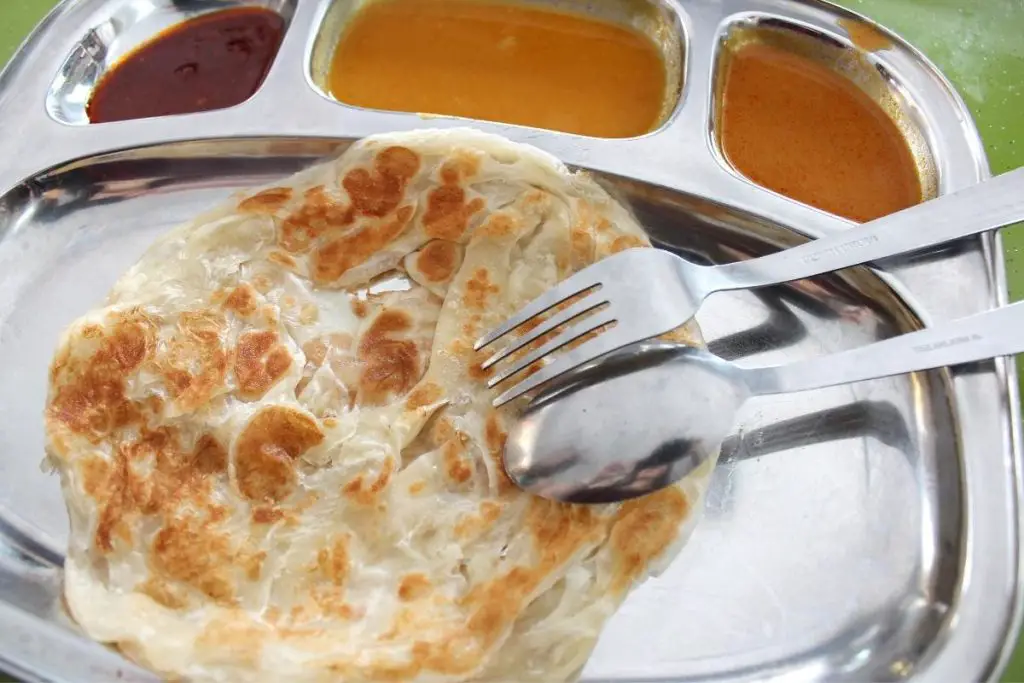
Roti canai (pronounced as “ro-ti-cha-nai”) is an Indian flatbread that is very famous in Malaysia and even considered a national dish.
It comes in a lot of varieties like roti bawang (with onions), roti telur (with an egg), roti planta (with margarine and sugar), roti cheese (with cheese), roti pisang (with banana slices), and many more.
It is made by oiling the dough, flattening it, tossing and folding it into a thin square-like shape, and pan-fried on a large skillet, resulting in a fluffy and crispy texture.
Roti canai is served with curries like dhal curry (lentil) and fish curry.
But to me, it is best served with dhal curry, just dip it fully into the curry and eat.
It is a food that I often craving for, whether is for breakfast, snack, supper, or even dinner as a main meal.
It is definitely one of the best foods to eat in Malaysia. One of my all-time favourites!
The best place to enjoy roti canai is Mamak.
- Eat as: Main meal, snack
- Where to Eat: Mamak, Malay stall, Indian restaurant
- Main ingredients: Flour, egg, butter, sweetened condensed milk, salt, oil, water
- Cuisine: Indian
46. Ramly Burger (Malaysian’ Favourite Burger)
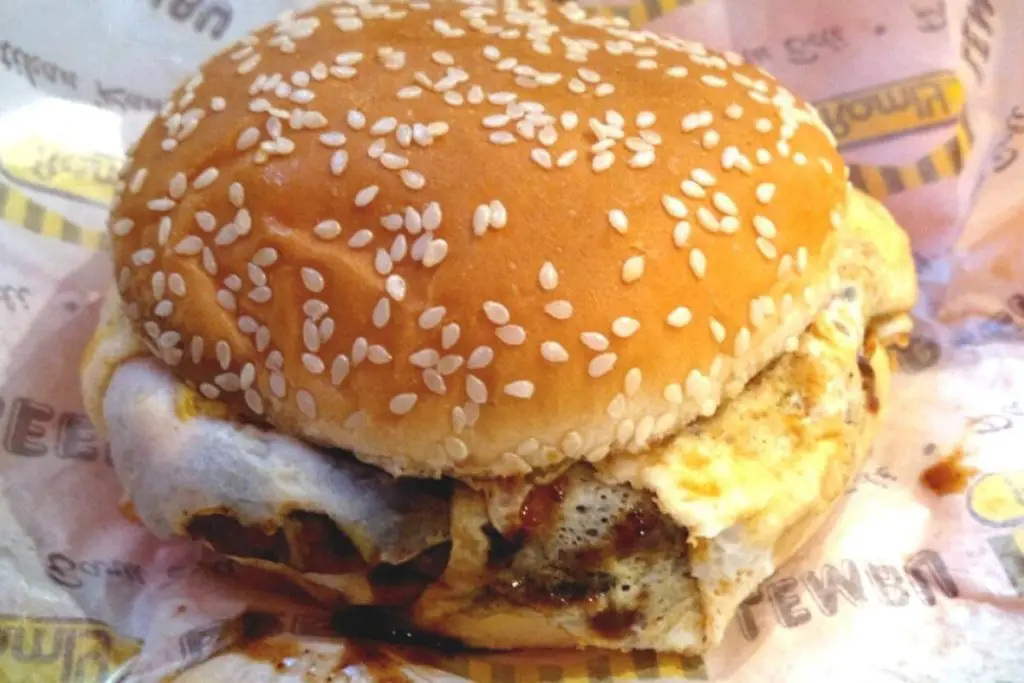
Ramly burger is considered the best street food in Malaysia. It is also one of the famous suppers and snacks that you can find at roadside stalls all over Malaysia.
The core of the Ramly burger, the meat patty (chicken or beef), is produced by a Malaysia well-known halal frozen food company named Ramly.
Each Ramly burger stall has its own unique recipes for preparing the Ramly burger, but the common ingredients are meat patty (chicken or beef), buns, butter/margarine, shredded cabbage, onion, shredded carrot, cucumber slices, shredded lettuce, tomato, cheese, egg, sauces (chilli, mayonnaise), and seasonings (Maggi seasoning, black pepper, ground white pepper).
Some Ramly burgers also use pineapples for extra flavour.
They grill the juicy meat patties on a hot iron griddle, season it, move it on a buttered bun and top it with shredded cabbages, onions, etc., then add chilli and mayonnaise sauce, and finish it with a buttered bun on top.
It is super delicious!
As most of the Ramly burger roadside stalls only operate from late afternoon or evening to late night, so the Ramly burger is often enjoyed as a supper or late-night snack.
Also, not all burger stalls at the roadside are Ramly burgers, some (minority) are Otai burgers, while not as famous as Ramly burgers, their burgers are great too.
Tip: Ramly burger special = meat patty with egg
Tip 2: They tend to put a lot of sauces, so if you don’t like too much sauce, you may request less sauce.
- Eat As: Snack, main meal
- Where to Eat: Roadside stall
- Main Ingredients: Ramly meat patties (chicken or beef), buns, butter/margarine, shredded cabbage, onion, shredded carrot, cucumber slices, shredded lettuce, tomato, cheese, egg, sauces (chilli, mayonnaise), and seasonings (Maggi seasoning, black pepper, ground white pepper)
- Cuisine: Malaysian
47. Satay (Grilled Meat Skewers)
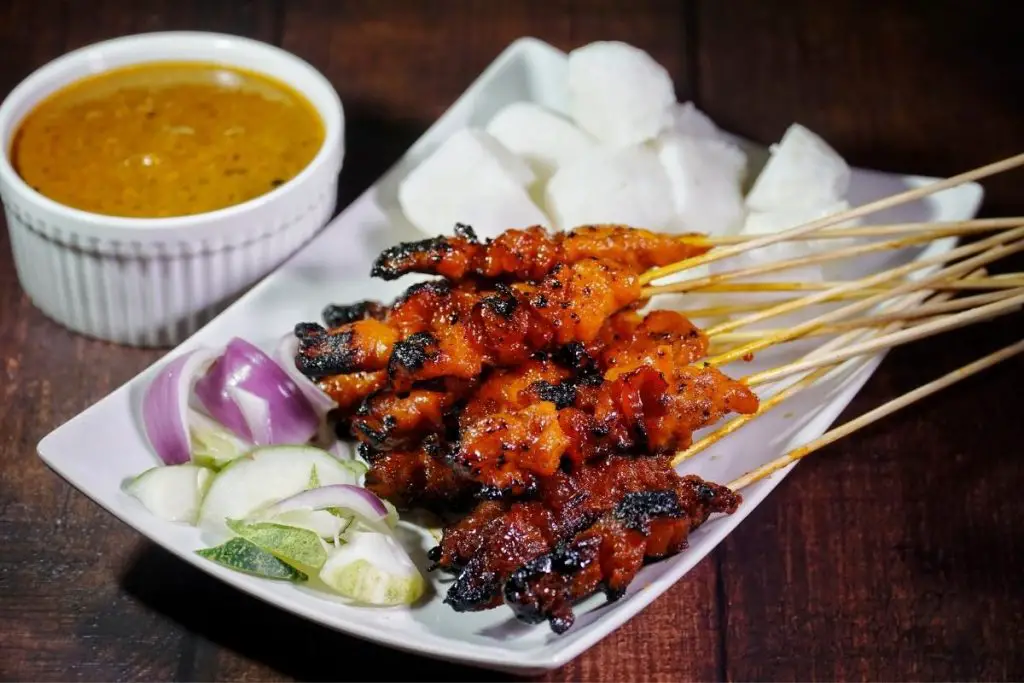
Satay is one of the best foods in Malaysia that is loved by locals and foreigners.
The meat (usually chicken, beef, lamb or pork) is put on a bamboo stick and grilled over charcoal.
The grilled meat skewer is juicy and mouth-watering and is even better when dipped into the peanut sauce.
It is commonly served with sides like onions, cucumbers and rice cake.
You can find it in food courts, Malay night markets, and hawker centres during evening hours. If you would like to eat it during the daytime, there are also satay restaurants that serve satay all day.
The satay is especially famous in Kajang, Selangor, which is known to have the best satay in Malaysia.
If you are in Sarawak, try out the juicy pork satay which is famous there!
- Eat As: Snack
- Where to Eat: Food court, hawker centre, Malay night market, Satay restaurant, Mamak
- Main Ingredients: Meat (chicken, beef, lamb or pork)
- Cuisine: Southeast Asian
48. Rojak Mamak/Rojak Pasembur
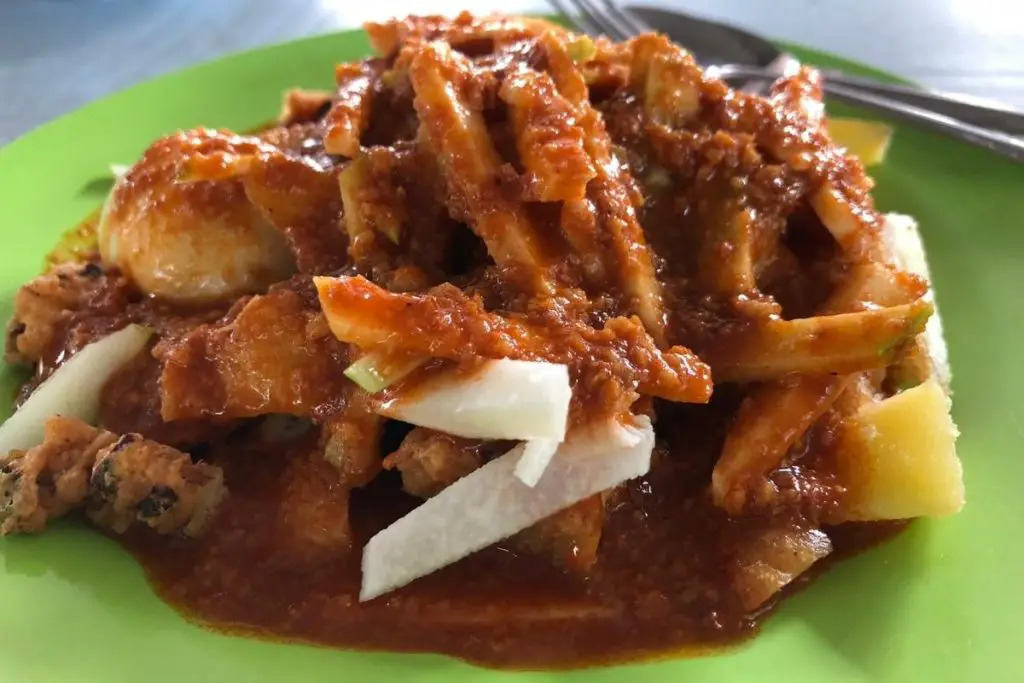
Rojak Mamak, also known as rojak pasembur, is a type of rojak that consists of fried flour cake, a hard-boiled egg, fried tofu, bean sprouts, sliced cucumber, potatoes, and fried crackers served in a sweet spicy peanuts sauce.
You can also find rojak stalls that sell rojak mee, which is rojak plus yellow noodles, and squid (sotong) as an add-on.
You can find this food in Mamak, roadside stalls and food trucks.
- Eat As: Snack, main meal
- Where to Eat: Mamak, roadside stall and food truck
- Main Ingredients: Flour, egg, tofu, bean sprouts, cucumber, potato, peanut
- Cuisine: Indian
49. Karipap (Curry Puff)
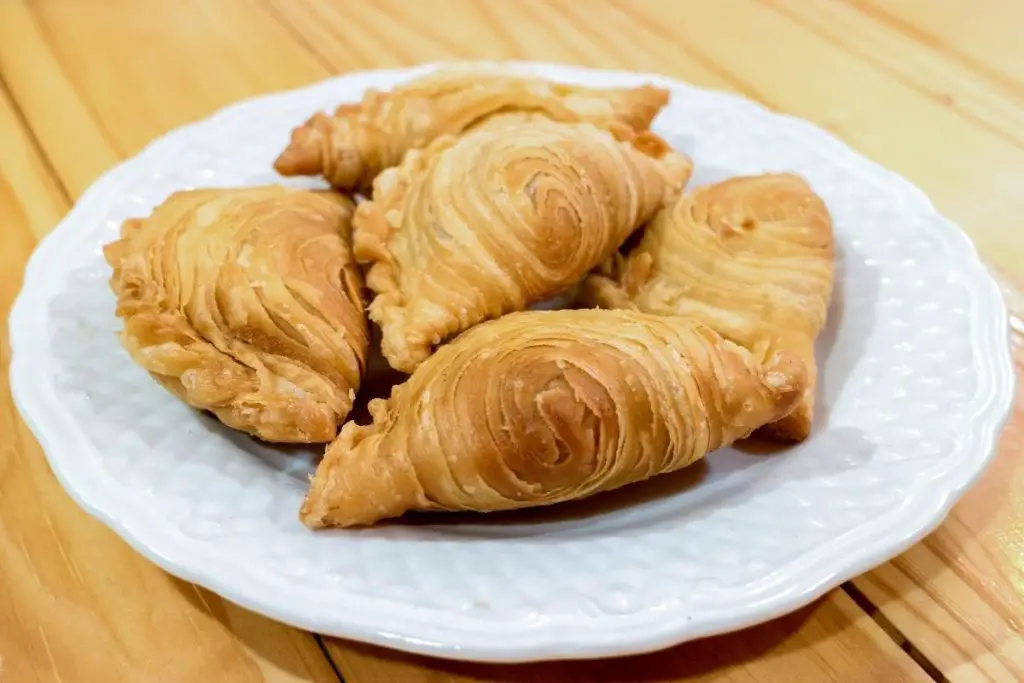
Karipap is one of the most famous and delicious kuih (pastries) or snacks in Malaysia that is enjoyed by locals.
It is a deep-fried shell-shaped pastry filled with potato curry or chicken curry. Some big-sized karipap contain potato curry, chicken curry and hard-boiled egg.
There is also baked karipap, but the deep-fried version is better.
It can be found at roadside stalls, night markets, stores, restaurants, and Mamak.
- Eat As: Snack
- Where to Eat: Roadside stall and food truck, restaurant
- Main Ingredients: Flour, potato curry, chicken curry
- Cuisine: Southeast Asian
50. Pisang Goreng (Banana Fritters)
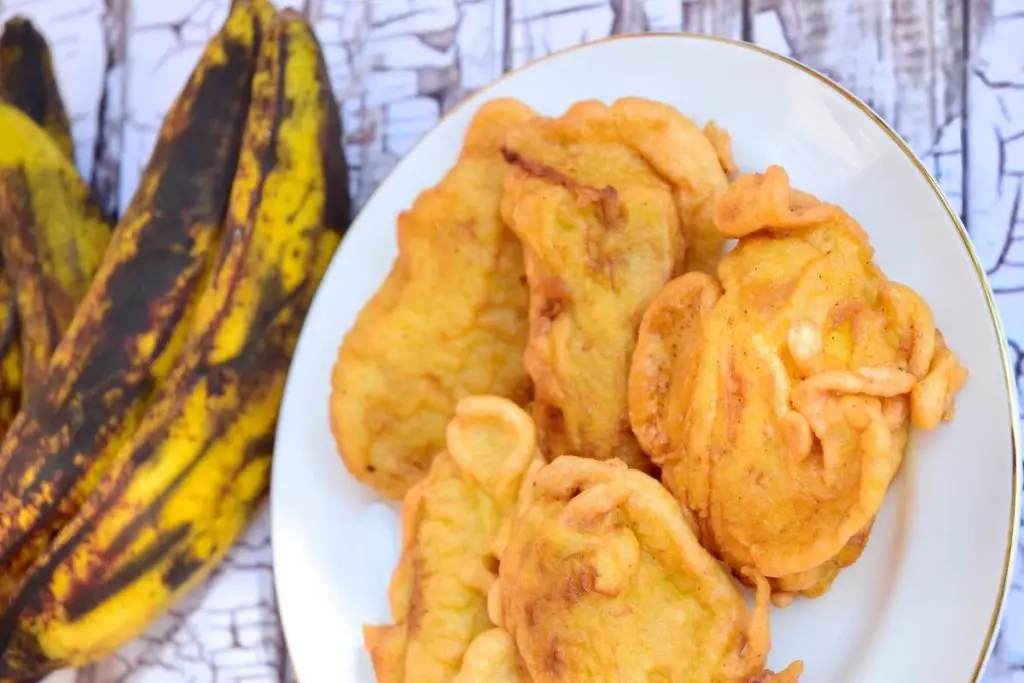
Pisang Goreng is a popular Malay snack in Malaysia that can be found at roadside stalls.
The ripe banana is covered with batter and deep-fried in a large wok full of cooking oil until crunchy golden-brown texture.
It is a combination of crispness, sweetness and deliciousness, a great match for your afternoon tea.
- Eat As: Snack
- Where to Eat: Roadside stall
- Main Ingredients: Banana, flour, egg
- Cuisine: Southeast Asian
51. Youtiao/Yu Char Kway/Cakoi (Fried Dough)
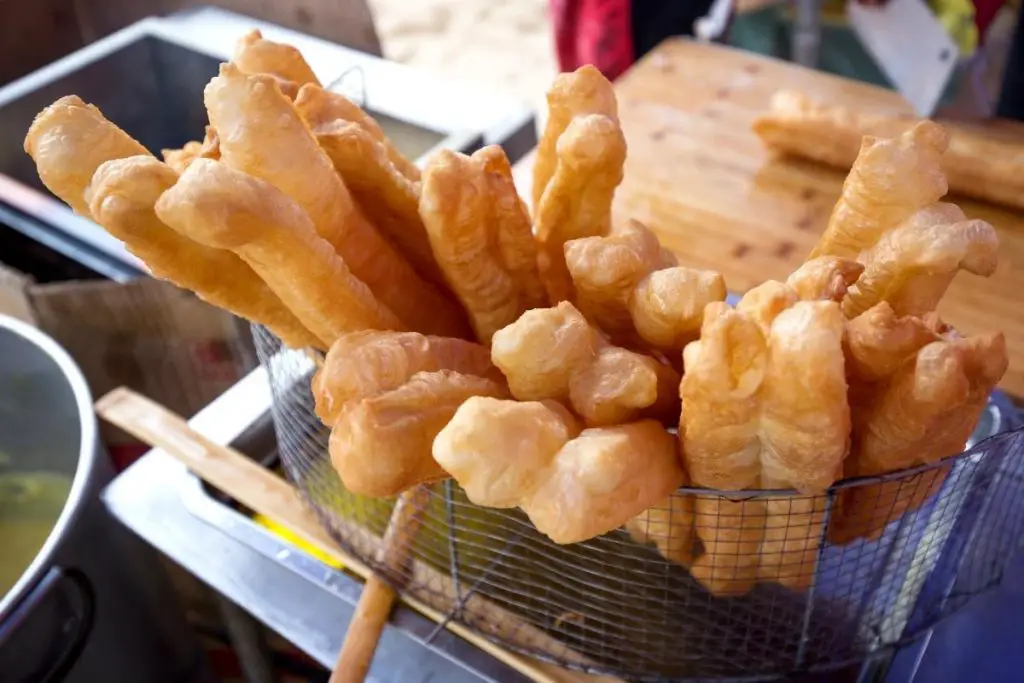
Youtiao or cakoi is a popular snack in Malaysia that you can find at roadside stalls.
It is made by deep-fried the long dough made with flour, baking powder, milk, salt, sugar, and water until golden-brown and crispy texture.
It can be eaten directly or eaten with other foods and drinks like Bak Kut Teh, porridge and soya milk.
- Eat As: Snack
- Where to Eat: Roadside stall, hawker centre
- Main Ingredients: Flour, baking powder, milk, salt, sugar
- Cuisine: Chinese
52. Keropok Lekor (Fried Fish Cracker)
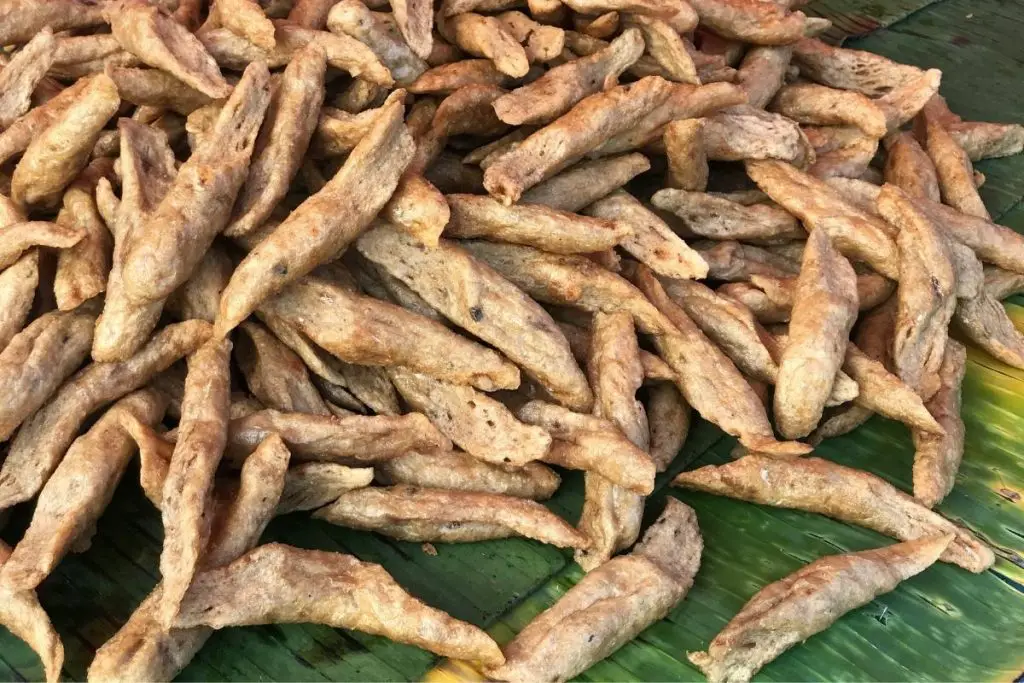
Keropok lekor is a popular Malay snack from Terengganu.
The fish cracker is made by first boiling the sausage-shape mixtures of fish meat, sago flour, salt, and sugar, letting it cool down, and then deep-fried to a crispy texture.
There is also a thin and crunchy version called keropok lekor selipar.
It can be eaten directly but is best served with a sweet chilli dipping sauce.
You can find keropok lekor in Malay night markets and roadside stalls.
- Eat As: Snack
- Where to Eat: Roadside stall, hawker centre
- Main Ingredients: Fish, sago flour, salt, sugar
- Cuisine: Malay
53. Kuih (Malaysia’s Snacks or Dessert)
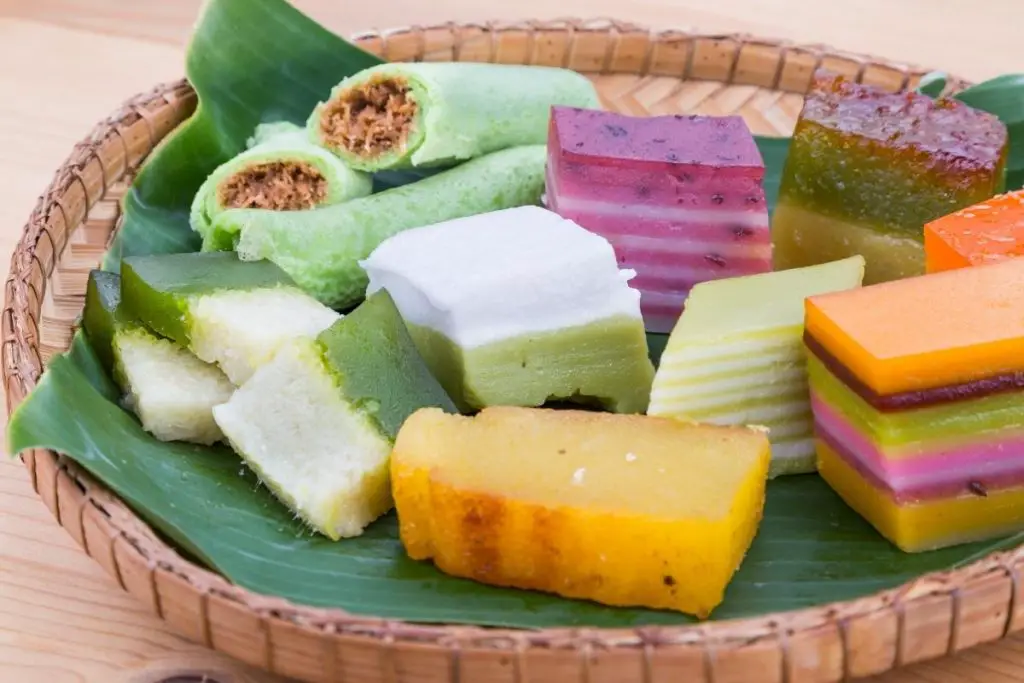
Kuih-muih are popular bite-size Malaysian pastries, desserts or snacks that come with a lot of variety, and each has a different shape and colour.
In Malaysia, you can find colourful and delicious Chinese kuih, Malay kuih and Nyonya Kuih.
Most kuih are sweet and made from glutinous rice or rice with common ingredients like gula Melaka (Malacca sugar), pandan leaves, grated coconut, coconut milk, and coconut cream. There are some kuih are savoury.
Some of the popular Chinese kuih are Ang Koo Kueh, Pandan Mochi, Ku Chai Kueh, Or Kuih, Niangao, Chwee Kueh, and Yi Bua.
Some of the popular Malay and Nyonya kuih are Kuih Kosui (or Kuih Lompang), Kuih Serimuka, Kuih Lapis, Kuih Gulung, Kuih Kochi, Kuih Keria, Kuih Nona Manis, Kuih Pinjaram, Kuih Bom (Pulut Bijan), Pulut Inti, Pulut Panggang, and Kuih Lopes.
You can find them in morning markets, night markets and roadside stalls.
- Eat As: Snack, Dessert
- Where to Eat: Roadside stall, morning market, hawker centre, Nyonya restaurant
- Main Ingredients: Glutinous rice, rice, sugar, coconut, coconut milk, pandan leaves
- Cuisine: Nyonya
54. Apam Balik (Malaysian Pancake)
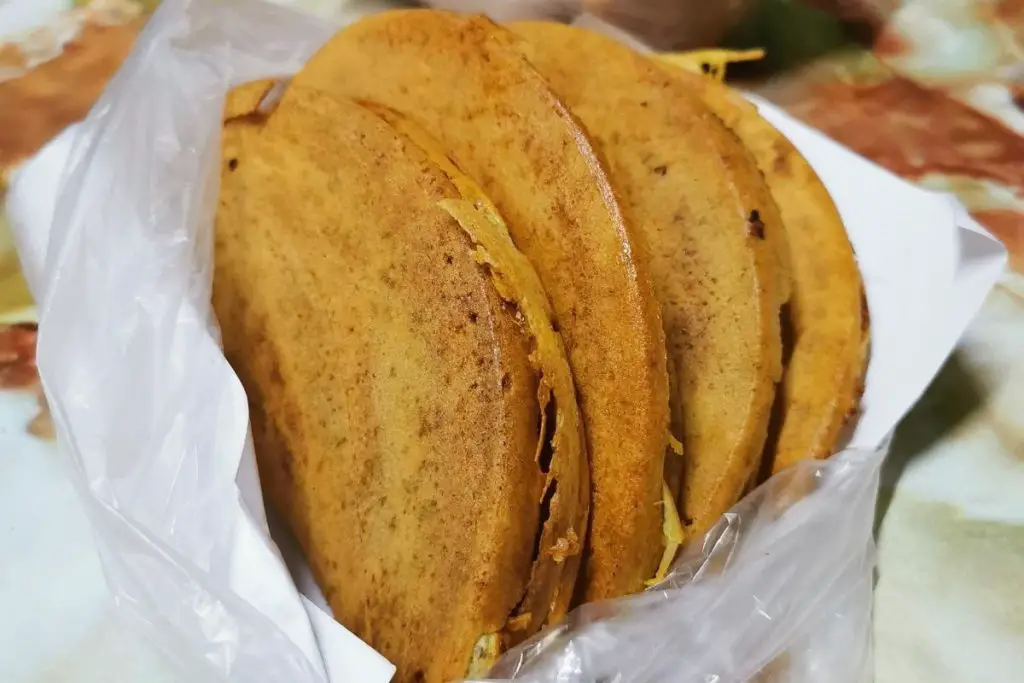
Apam Balik is a famous Malaysian dessert and snack that you can find in night markets and roadside stalls.
It is a pan-fried stuffed pancake that is either in a thick and soft or thin and crispy form.
The pancake batter is made of flour, baking soda, eggs, sugar, salt, and water. Some also add in ingredients like butter, vanilla extract, yeast, coconut milk, and milk.
The common fillings are sugar, cream corn, butter, and coarsely ground peanuts. You can also find apam balik with other fillings like chocolate, cheese and condensed milk.
If you love a sweet treat, then make sure you try this!
- Eat As: Snack, Dessert
- Where to Eat: Roadside stall, morning market, hawker centre, Nyonya restaurant
- Main Ingredients: Flour, baking powder, baking soda, sugar, eggs, peanut, margarine, butter
- Cuisine: Chinese
55. Otak-otak (Spicy Fish Cake)
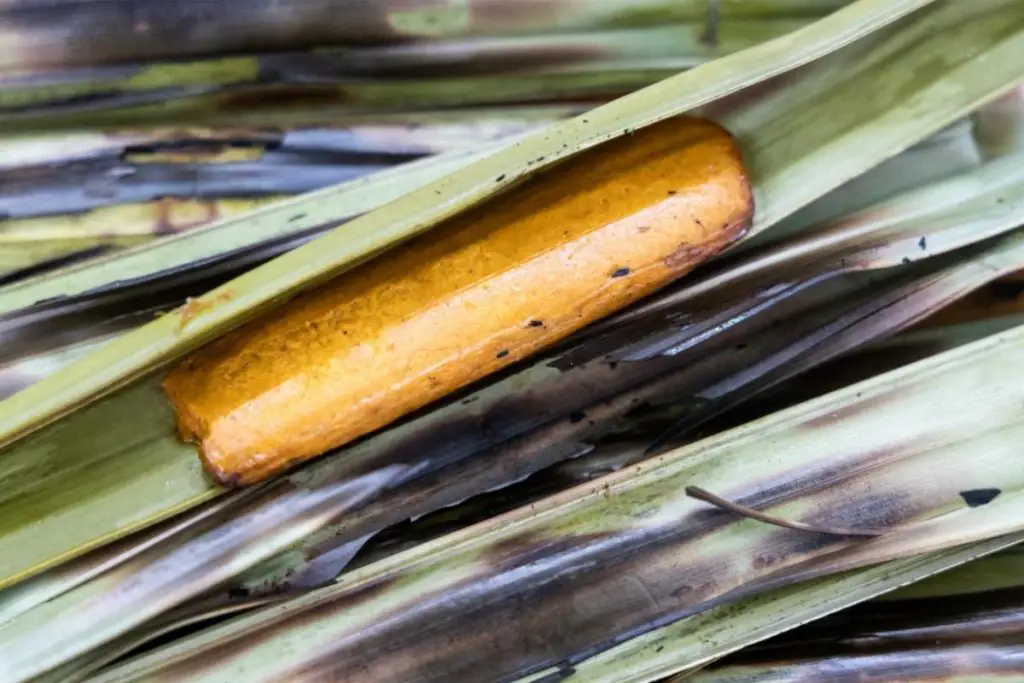
Otak-otak is a pinkish fish cake and is one of the popular snacks in Malaysia.
It is made by wrapping the spicy fish paste with banana leaf and then grilling over charcoal until it’s cooked.
You can eat it directly as a snack or eat it with rice.
- Eat As: Snack
- Where to Eat: Restaurant, roadside stall
- Main Ingredients: Fish, coconut milk, lemongrass, shallot, turmeric, chilli pepper, galangal
- Cuisine: Southeast Asian
56. Naan (Indian Thick Flatbread)
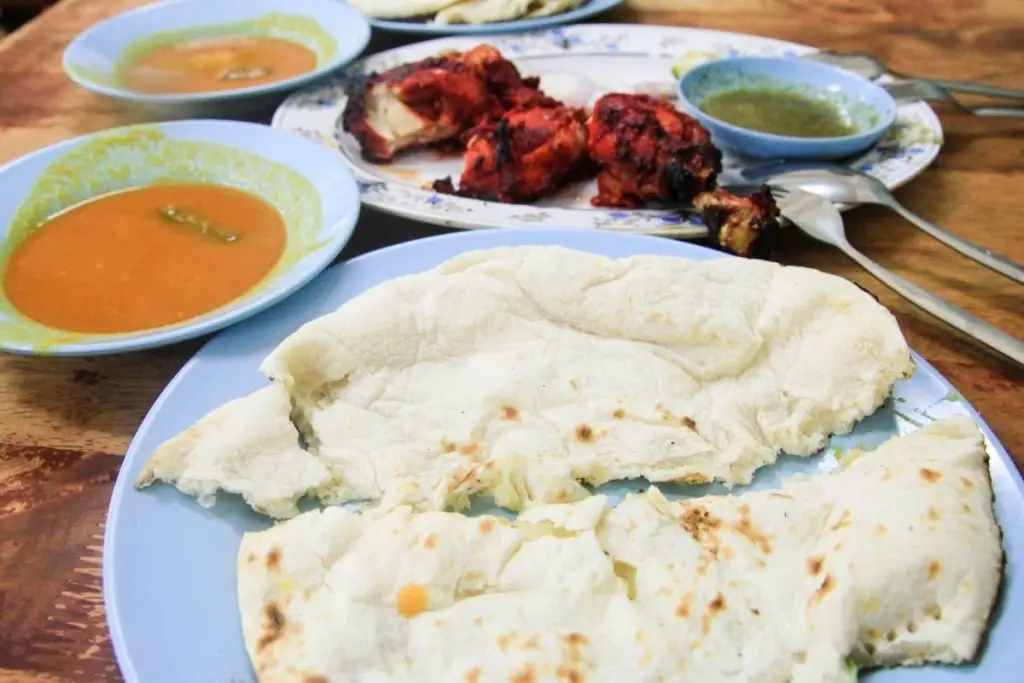
Naan is a soft and thick flatbread that is popular in Malaysia.
The dough is stuck on the wall of a clay tandoor oven and baked under high heat with charcoal or wood fire, resulting in a soft, fluffy, chewy, and airy naan.
It is often eaten with curries or tandoori chicken.
You may also try out the garlic cheese naan!
You can enjoy the food in Mamak.
- Eat As: Main meal, snack
- Where to Eat: Mamak
- Main Ingredients: Flour, yeast, yoghurt, salt, sugar, butter
- Cuisine: Indian
57. Roti Tisu/Roti Helicopter (Tissue Flatbread)
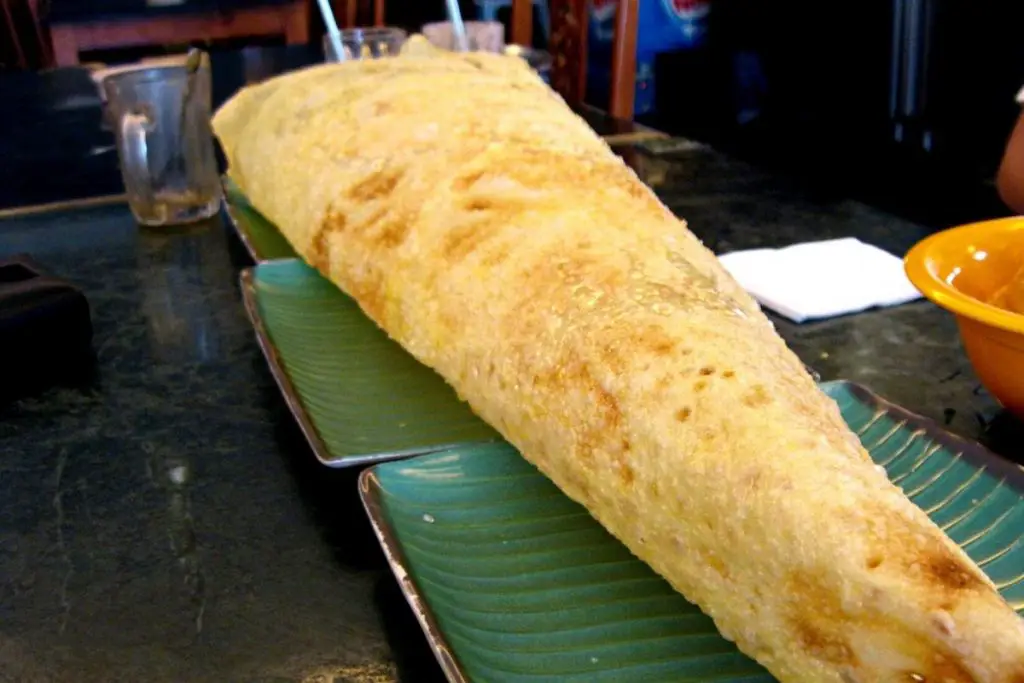
Roti Tisu is one of the varieties of roti canai and is known for its tissue-thin and tall cone shape.
It is sweet and crispy and usually served with curries.
The trick is to eat from the top, so it won’t fall while you are eating.
- Eat As: Snack
- Where to Eat: Mamak
- Main Ingredients: flour, salt, sugar, butter
- Cuisine: Indian
58. Roti Jala (Net Bread)
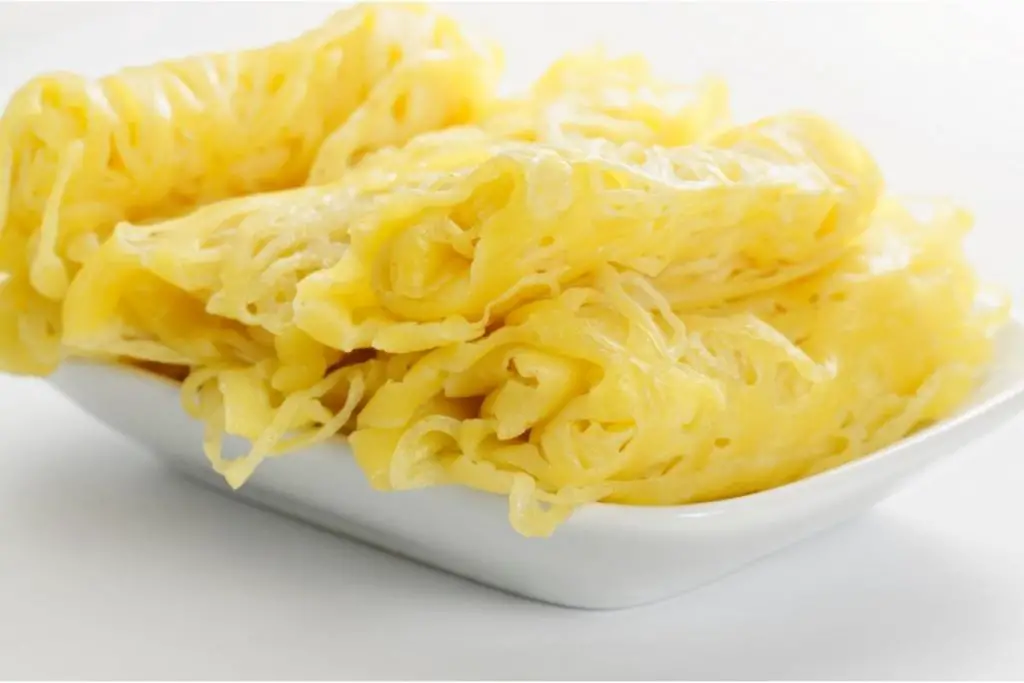
Roti Jala is a popular net-like crepe snack from Malaysia.
It’s made by pouring the batter on the skillet in zigzagging lines and then folding or rolling up.
The batter is a mixture of wheat flour, milk, eggs, and turmeric (which gives it a yellow colour).
The roti jala is often eaten with chicken curry or potato curry.
- Eat As: Snack
- Where to Eat: Roadside stall, restaurant
- Main Ingredients: Flour, milk, egg, turmeric
- Cuisine: Malay
59. Cucur Udang/Jemput–jemput Udang (Scallion Prawn Fritter)
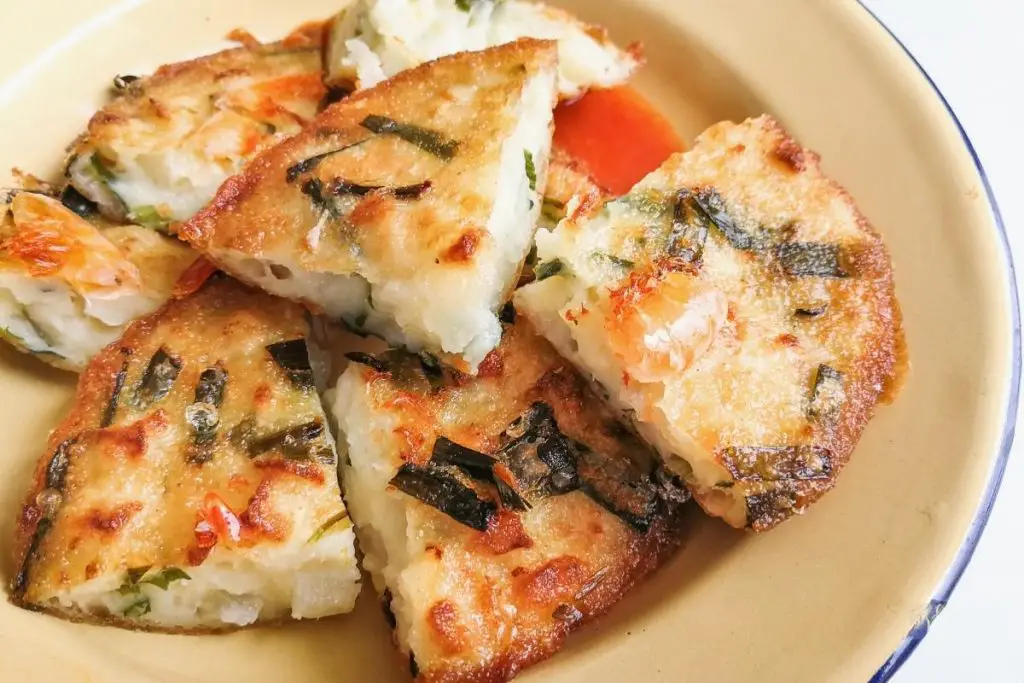
Cucur udang is a common fried snack in Malaysia that is crunchy and delicious.
The scallion prawn fritter is made by deep-frying the batter made from wheat flour, egg, yeast, prawn, water, salt, onions, bean sprouts, red chilli, turmeric powder and chives.
It is usually enjoyed with chilli sauce or peanut sauce, as breakfast or afternoon tea.
- Eat As: Snack
- Where to Eat: Roadside stall, hawker centre
- Main Ingredients: Flour, egg, yeast, prawn, salt, onions, bean sprouts, red chilli, turmeric powder, chives
- Cuisine: Malay
60. Popiah (Spring Roll)
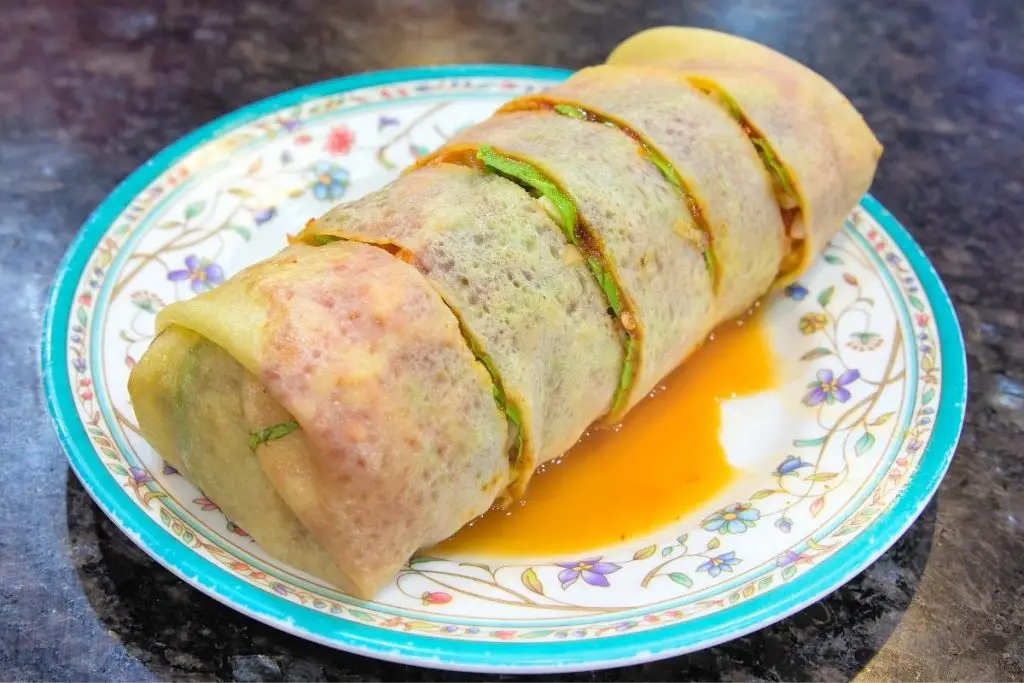
Popiah is a famous Malaysian snack that can be found in night markets, hawker centres and roadside stalls.
The soft popiah skin is stuffed with ingredients like yam bean (sengkuang), bean sprouts, cabbage, carrot, onion, shrimp, shallots, garlic, and sweet chilli sauce.
- Eat As: Snack
- Where to Eat: Hawker centre, night market
- Main Ingredients: Wheat flour, jicama/yam bean (sengkuang), bean sprouts, cabbage, carrot, onion, shrimp, shallots, garlic, sweet chilli sauce
- Cuisine: Chinese
61. Fried Popiah (Fried Spring Rolls)
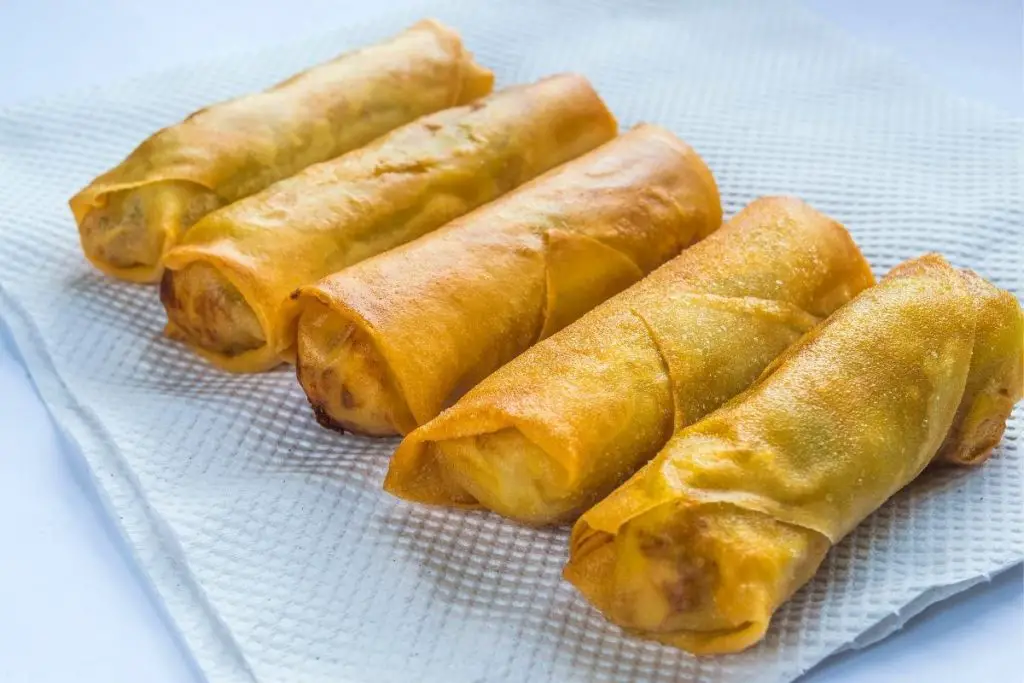
Popiah is a common Malaysian snack that is made by frying the popiah filled with minced meat (chicken or shrimp) and diced vegetables like jicama, carrot and turnip.
It is smaller and thinner than the popiah (spring rolls) and is usually served with chilli sauce.
You can find fried popiah in night markets and roadside stalls.
- Eat As: Snack
- Where to Eat: Hawker centre, night market, roadside stall
- Main Ingredients: Wheat flour, jicama/yam bean (sengkuang), shrimp or pork, carrot, onion, garlic, cabbage, salt, green onion, sweet chilli sauce
- Cuisine: Chinese
62. Oh Chien/O Chian (Oyster Omelette)
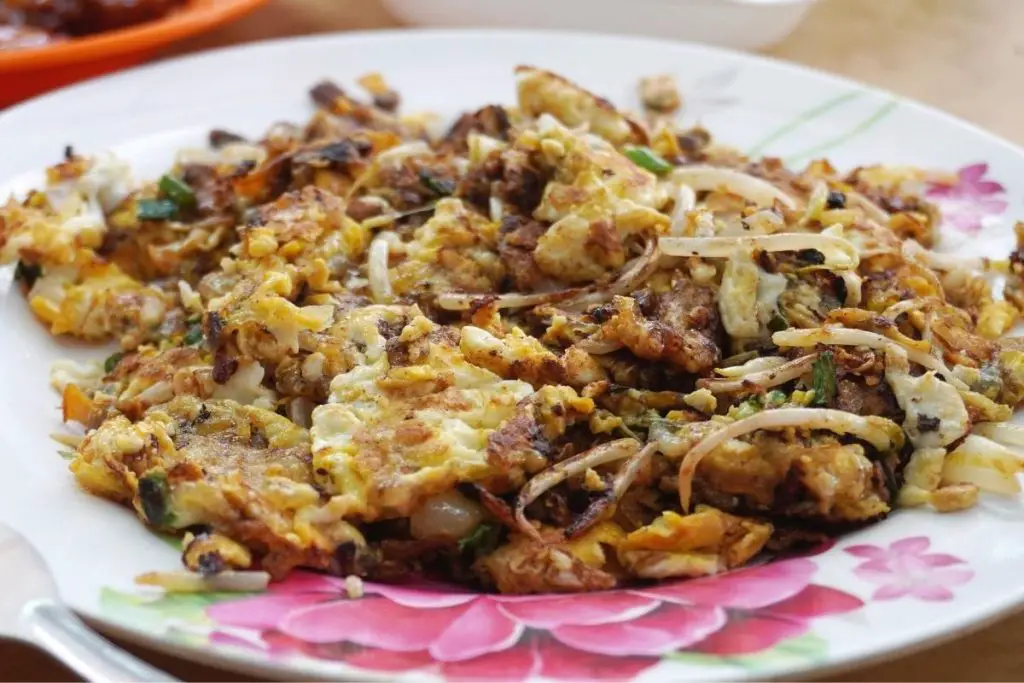
Oh Chien is one of the common street foods in Malaysia.
It is an oyster omelette made by frying the whipped egg, potato starch and fresh oyster on a large skillet until crispy.
The dish can be found in hawker centres, food courts, Chinese night markets, and roadside stalls.
- Eat As: Snack
- Where to Eat: Hawker centre, food court, Chinese night market, roadside stall
- Main Ingredients: Egg, sweet potato starch, oyster, fish sauce, garlic, chilli, spring onion, rice flour, salt, soy sauce
- Cuisine: Chinese
63. Roti John (Omelette Sandwich)
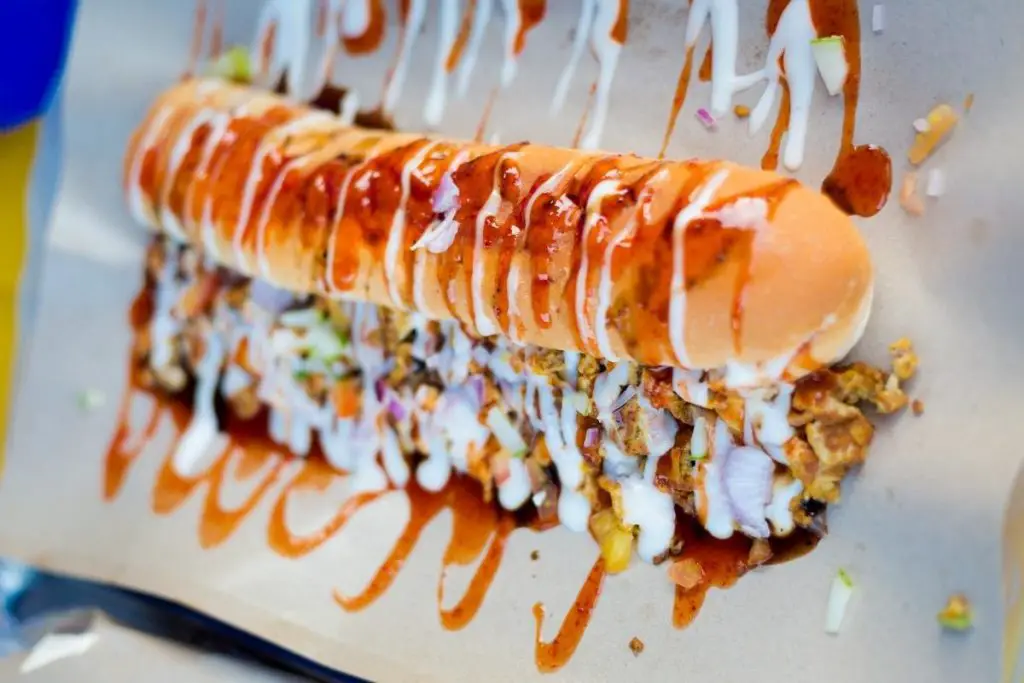
Roti john is an omelette sandwich fill made with baguette-type loaf and grilled minced beef, egg, onion, and sauces like chilli, tomato, ketchup, barbecue, and mayonnaise.
You can find it on food trucks, roadside stalls and Malay night markets.
- Eat As: Snack, main meal
- Where to Eat: Food truck, roadside stalls and Malay night market.
- Main Ingredients: Loaf, beef, egg, onion, sauces (chilli, tomato, ketchup, barbecue, mayonnaise)
- Cuisine: Malay
64. Loh bak/Lor bak (Five-Spice Pork Roll)
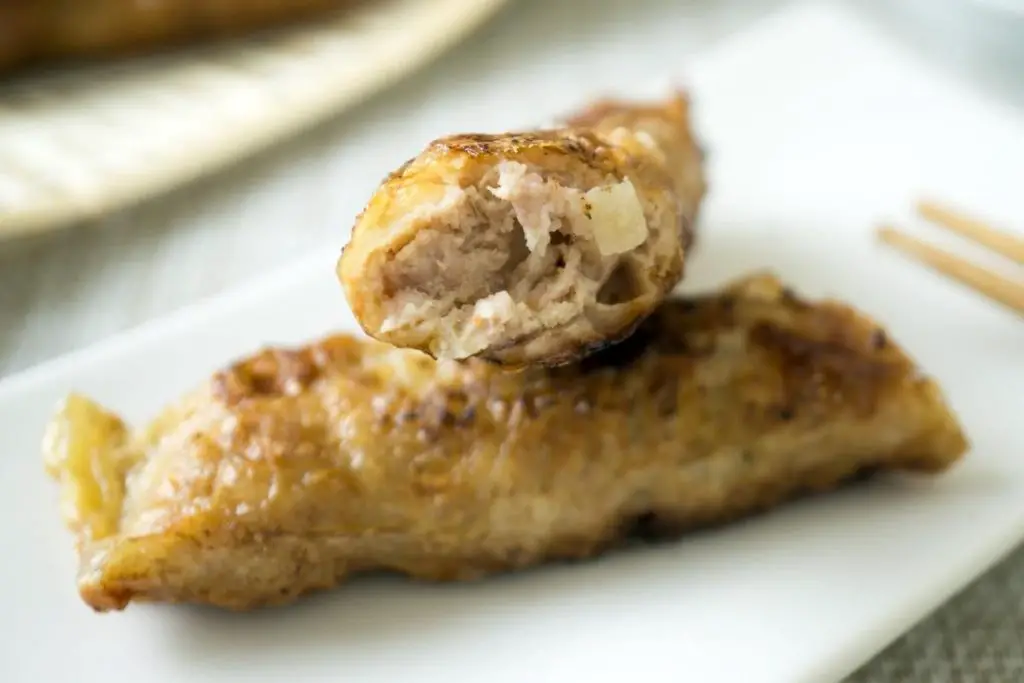
Lor bak (or known as ngoh hiang in Hokkien dialect) is a five-spice fried meat roll from Penang.
The crispy meat roll is made by marinating the meat (usually pork) with five-spice powder and wrapping it in bean curd skin, and then deep fry to the crispy texture.
It is often served with chilli sauce and dark-soy sauce.
You can find it in hawker centres, food courts, roadside stalls, and restaurants.
- Eat As: Snack
- Where to Eat: Hawker centre, food court, restaurant, roadside stall
- Main Ingredients: Pork, five spice powder, bean curd skin, jicama, onion, garlic, corn starch, egg
- Cuisine: Chinese
65. Lok-Lok
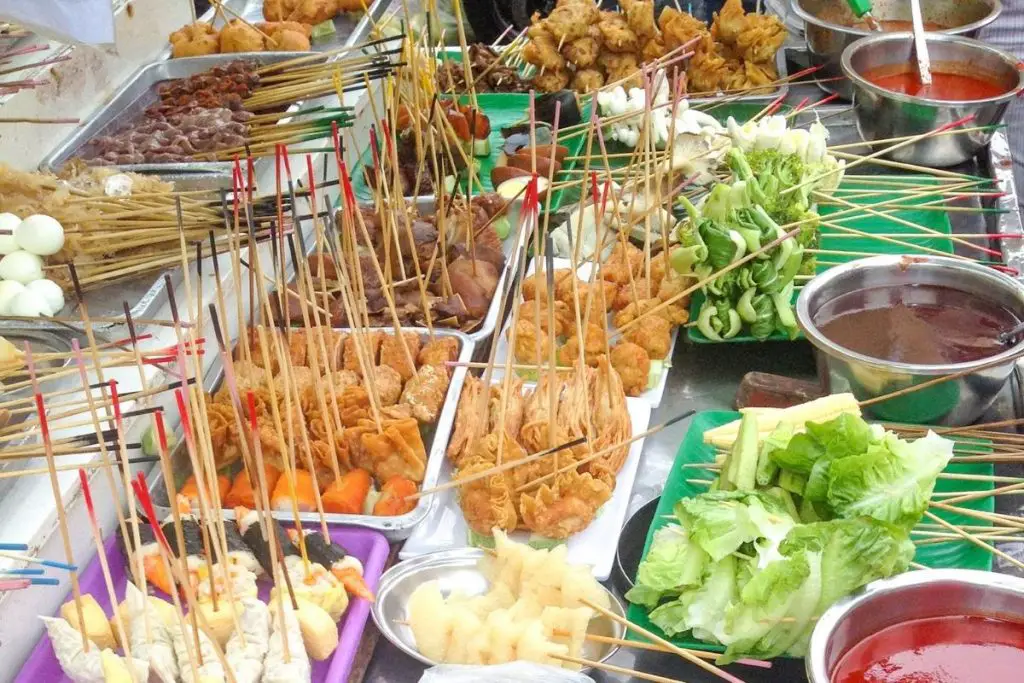
Lok-lok is a combination of skewers and steamboat that offer different skewers of meat, seafood, processed food, eggs, and vegetables.
The sticks are colour-coded for a different price.
Just grab any stick you want to eat, soak it into a boiling pot of clear soup/water, dip it into your favourite sauce (sweet sauce and chilli sauce) and enjoy your food!
You can find lok-lok at mobile food trucks and in Lok-lok restaurants.
- Eat As: Snack, main meal
- Where to Eat: Lok-lok food truck, lok-lok restaurant
- Main Ingredients: Meat, seafood, processed food, egg, vegetables
- Cuisine: Chinese
66. Murtabak (Pan-fried Bread/Pancake)
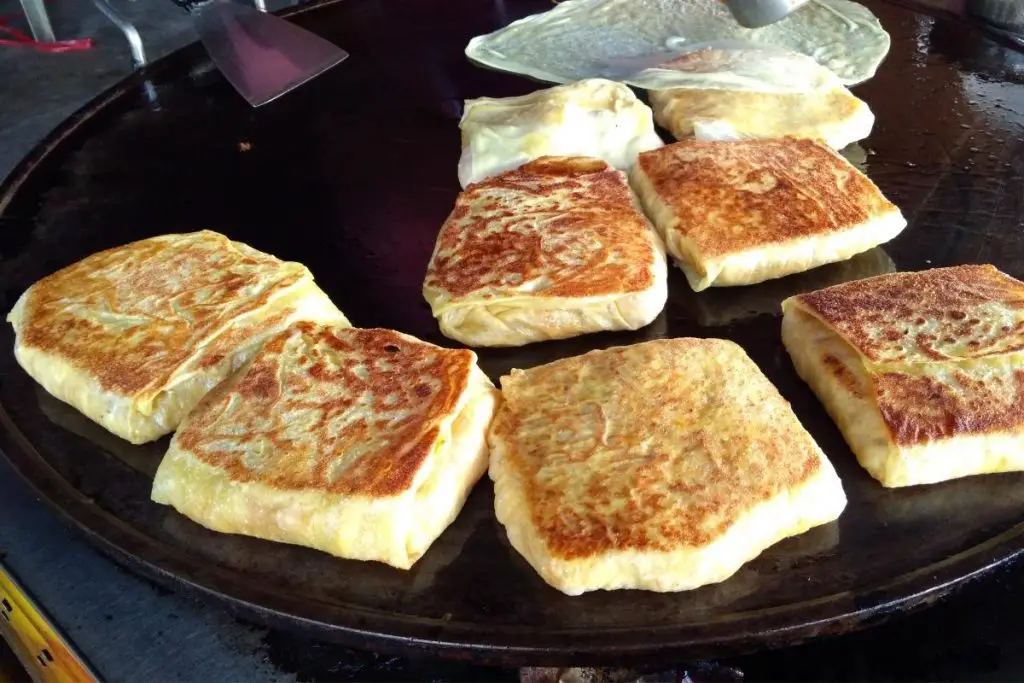
Murtabak is a pan-fried bread or pancake stuffed with minced meat, onions and eggs.
You can dip it in curry or spicy sauce for the extra flavour.
It can be found in Mamak, Malay night markets and roadside stalls.
- Eat As: Snack
- Where to Eat: Mamak, Malay night market, roadside stall
- Main Ingredients: Wheat flour, egg, leeks, chives, scallions, meat (chicken, beef, mutton), garlic, onion
- Cuisine: Southeast Asian
67. Rojak (Spicy Fruit Salad)
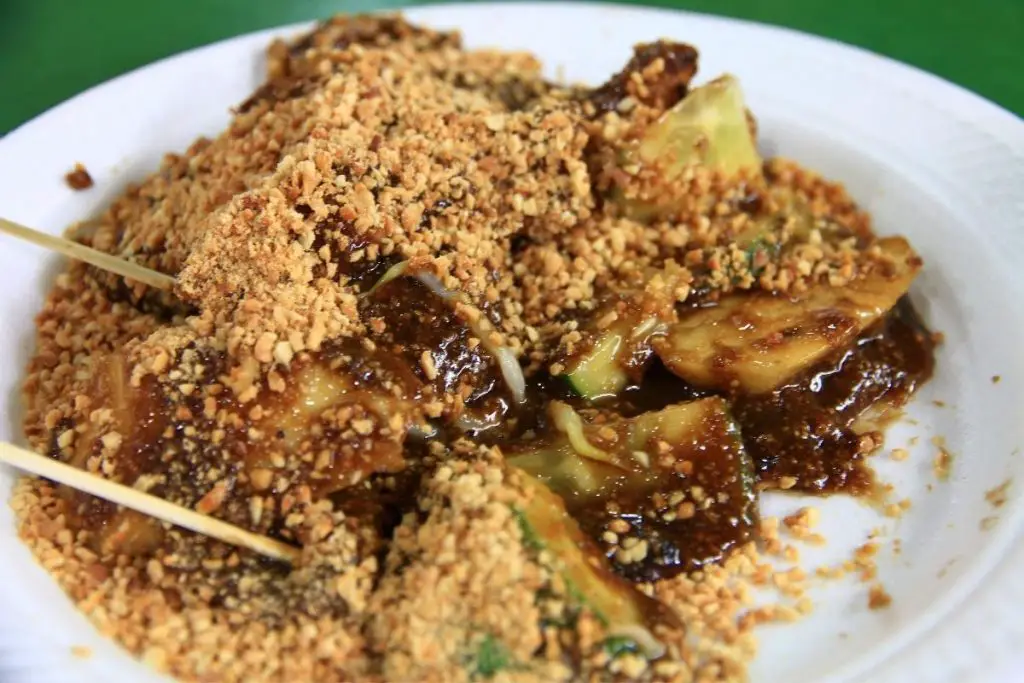
Rojak is a Malaysian tangy and spicy fruit salad that consists of sliced fruits, vegetables, fried tofu, and crispy crackers with a spicy palm sugar dressing.
The rojak sauce is spicy, sweet and sour and is made with shrimp paste, chilli, palm sugar, and peanuts.
The fruits and vegetables usually are pineapple, mango, cucumber, turnip, and half-ripe papaya.
You can find it in hawker centres, night markets and roadside stalls and food trucks.
- Eat As: Snack
- Where to Eat: Hawker centre, roadside stall, night market
- Main Ingredients: Pineapple, green mango, papaya, jicama, cucumber, turnip, palm sugar, peanuts, fried tofu, crispy crackers, hoisin sauce, sweet soy sauce, belacan (shrimp paste), chilli
- Cuisine: Southeast Asian
68. Lemang (Glutinous Rice Cooked in Bamboo)
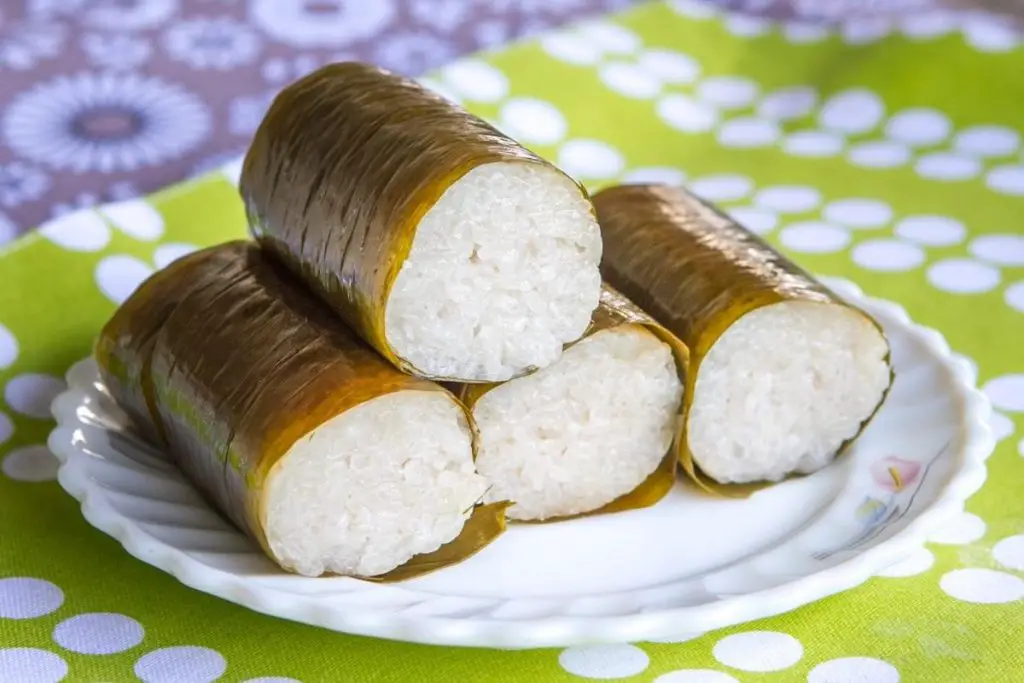
Lemang is a sticky and wet glutinous rice that is often eaten with other dishes like meat and vegetables.
The food is made by stuffing the glutinous rice, coconut milk and salt in a hallowed bamboo tube with banana leaves, and then leaving the bamboo tube over the fire to cook slowly.
- Eat As: Snacks, Main meal
- Where to Eat: Roadside stall, restaurant, Malay night market
- Main Ingredients: Glutinous rice, coconut milk, salt
- Cuisine: Malay
69. Satay Celup/Sate Celup
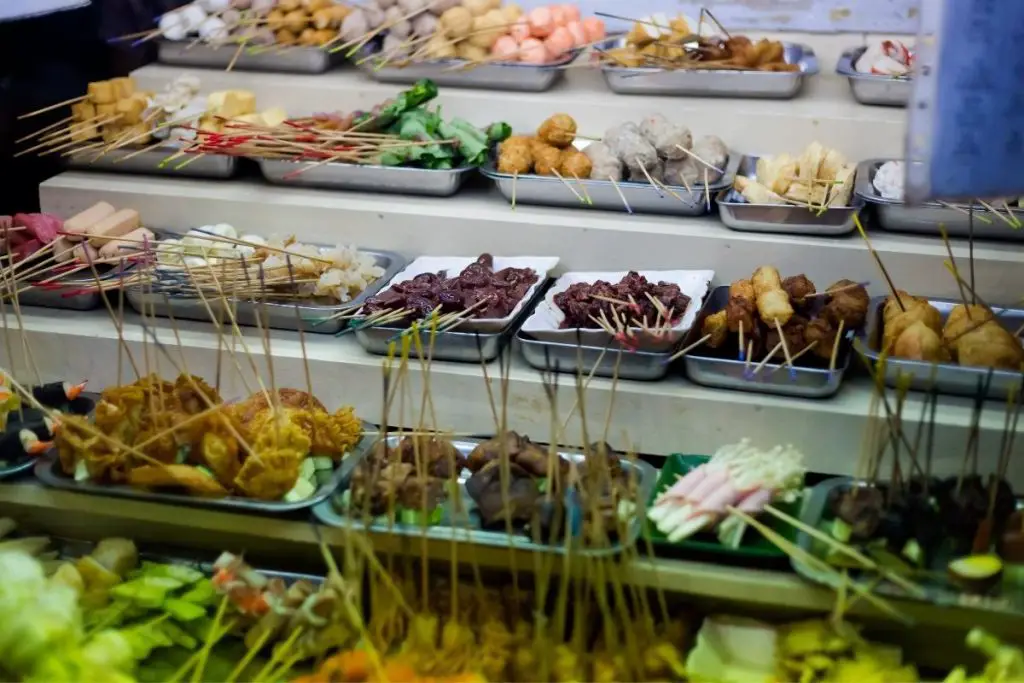
Satay celup is famous food in Melaka, Malaysia. It is lok-lok but with a hot boiling pot of spicy satay gravy instead of clear soup/water.
It is a self-serve dish and has a large variety of skewers of seafood, meat and vegetables.
You can enjoy the food at satay celup restaurants, and the best ones are in Melaka (Malacca).
- Eat As: Snack, Main meal
- Where to Eat: Satay Celup restaurant, Food Stall
- Main Ingredients: Meat, seafood, vegetables, tofu, peanuts, chilli
- Cuisine: Malaysian
70. Rempeyek (Deep-fried Cracker)
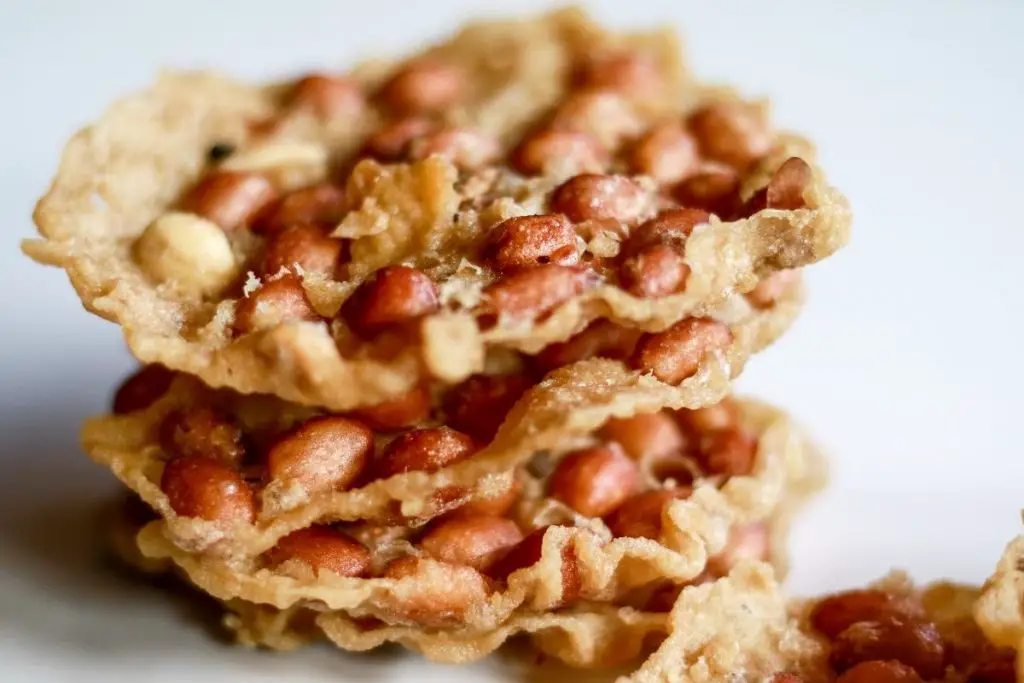
Rempeyek is a deep-fried cracker made from rice flour, peanuts and dried anchovies or dried shrimp. It is crispy and salty.
It is a common snack in Malaysia and can be found in groceries marts and roadside snack stalls.
- Eat As: Snack
- Where to Eat: Roadside stall, supermarket, groceries mart
- Main Ingredients: Rice flour, peanuts, dried anchovies/dried shrimp, salt
- Cuisine: Southeast Asian
71. Bahulu (Malaysian Madeleines)
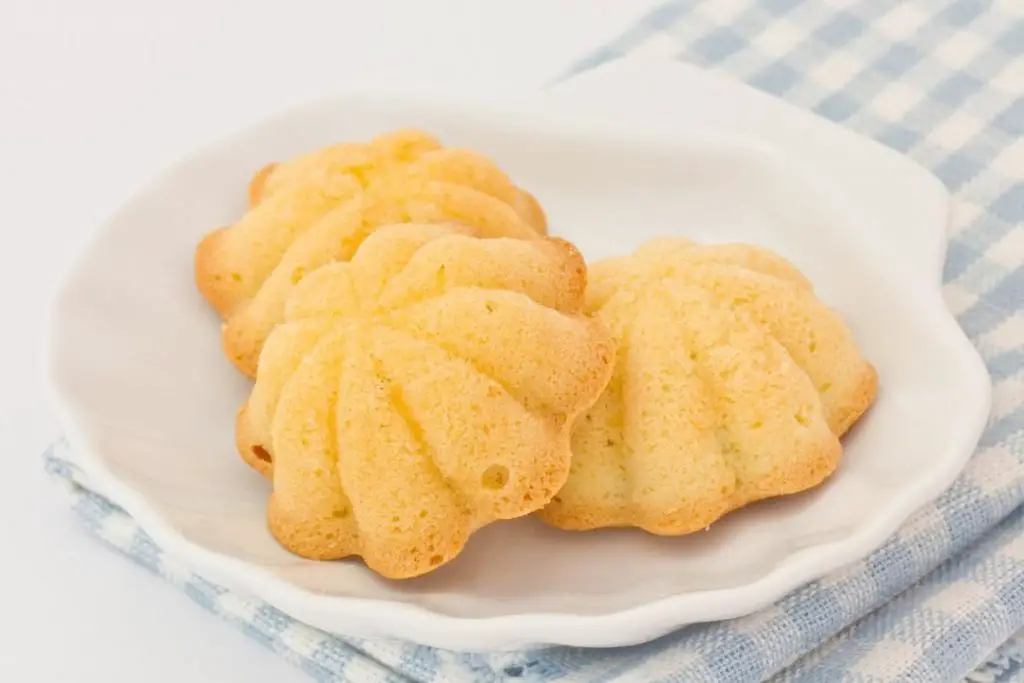
Bahulu is also known as Malaysian madeleines (egg sponge cake), it is a traditional Malay pastry that is usually enjoyed during festivals like Hari Raya, Chinese New Year, and Ramadan.
It is made from eggs, sugar, flour, baking powder, vanilla, and oil, and has various shapes like a star (known as bahulu cermai), rolls (known as bahulu gulung), goldfish (known as bahulu ikan), and layered (known as bahulu lapis).
You can also find other flavours of bahulu such as pandan, chocolate, fruit, and more.
- Eat As: Snack, dessert
- Where to Eat: Roadside stall, supermarket
- Main Ingredients: Flour, egg, sugar, baking powder, vanilla
- Cuisine: Malay
72. Kueh Tutu (Putu Piring)
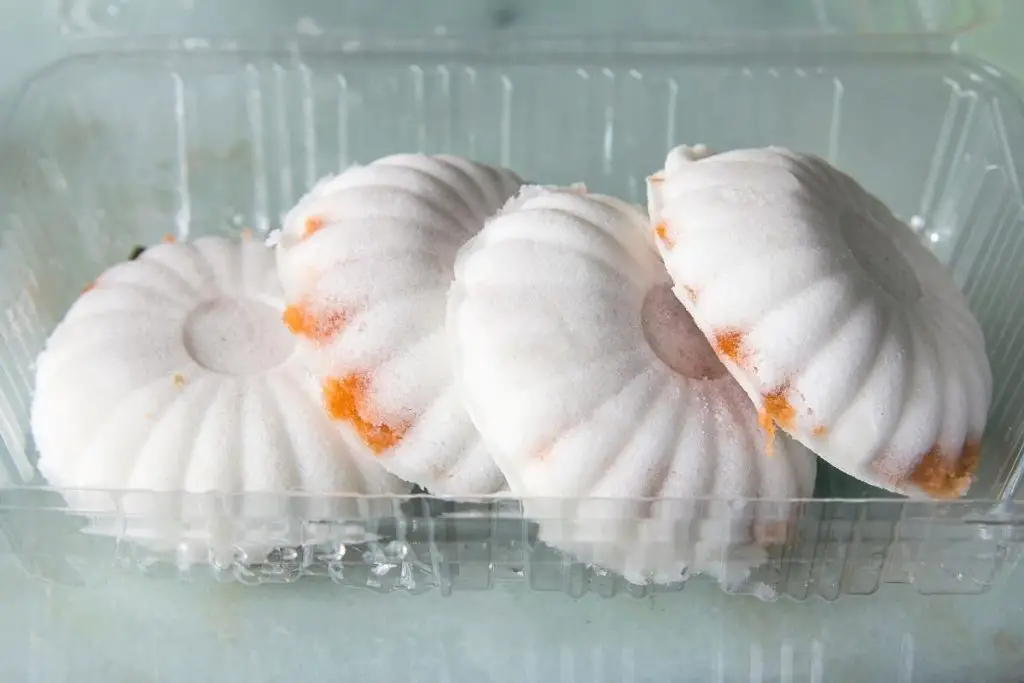
Kueh tutu is also known as putu piring, a steamed rice cake filled with palm sugar, ground peanuts, or grated coconut.
The sweet snack or dessert is made by steaming the rice or glutinous rice flour with the fillings.
- Eat As: Snack, dessert
- Where to Eat: Roadside stall, morning market
- Main Ingredients: Rice/glutinous rice flour, peanuts, palm sugar, coconut
- Cuisine: Chinese
73. Papparoti and Rotiboy (Malaysia Coffee Bun)
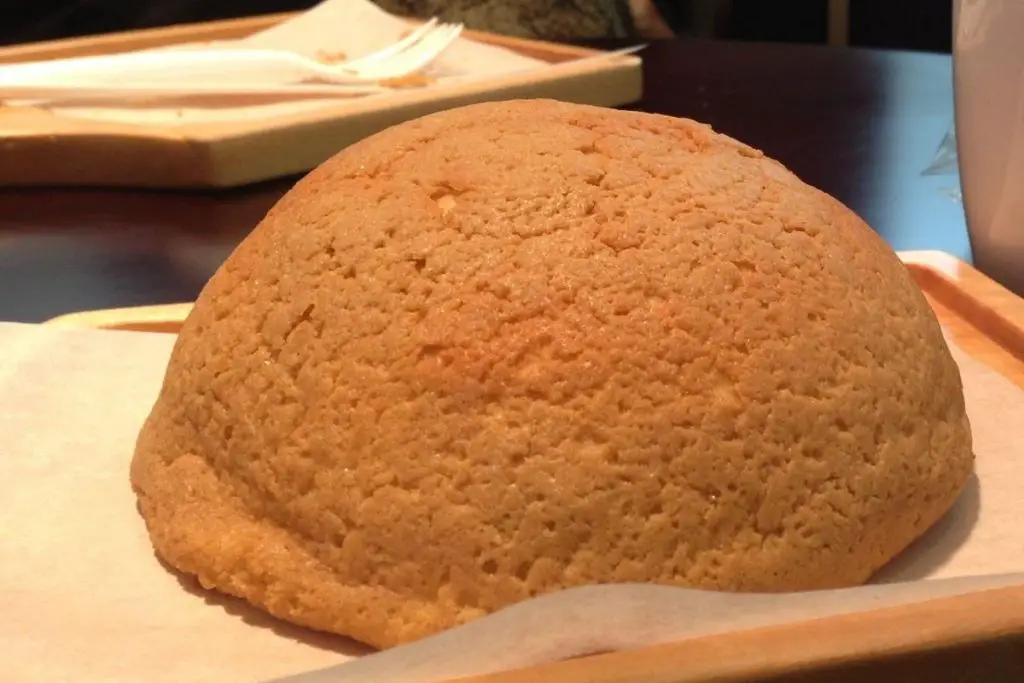
Papparoti and Rotiboy is a coffee bun originating from Malaysia that has a strong flavour that you can smell even from a distance.
The bun is made with flour, butter, milk, yeast, eggs, sugar, and salt and topped with a layer of coffee and caramel before baking.
The outside of the coffee bun is crispy, and the inside is soft and rich in buttery taste.
It is often enjoyed with hot tea or coffee.
- Eat As: Snack
- Where to Eat: Papparoti/Rotiboy kiosk and shop
- Main Ingredients: Flour, butter, milk, yeast, egg, sugar, salt, coffee, caramel
- Cuisine: Malaysian
74. Cempedak Goreng (Fried Cempedak)
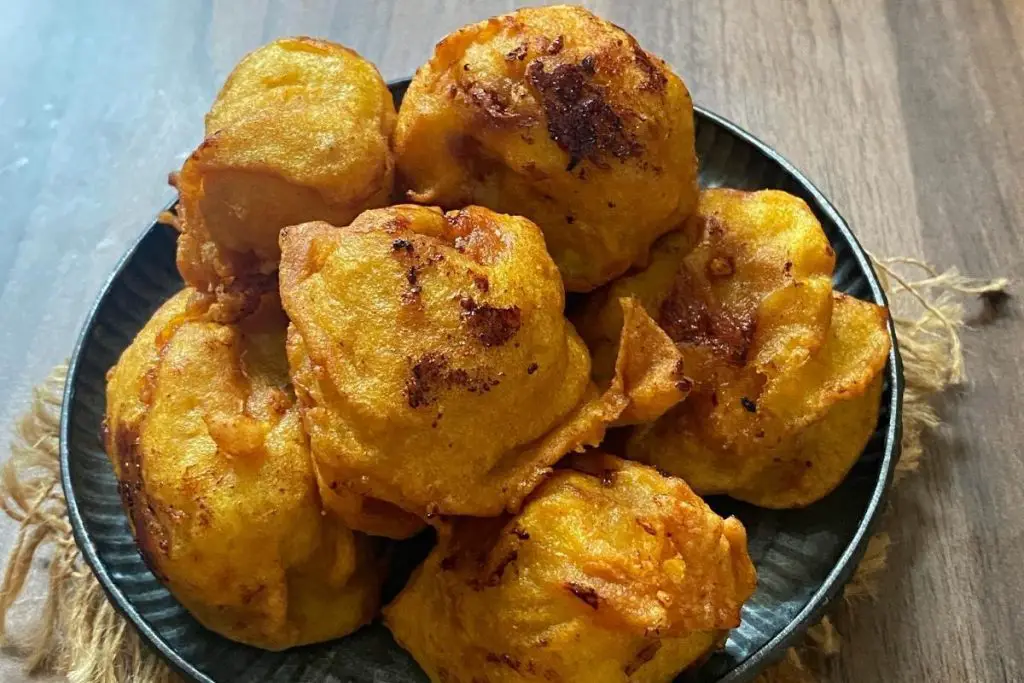
Cempedak Goreng is a fried snack in Malaysia that is made by deep-frying the cempedak fruits (Artocarpus integer) covered with batter made of flour, butter, egg, turmeric powder, sugar, salt, and water.
It is crunchy on the outside, and soft and sweet on the inside.
You can find it at roadside stalls and night markets.
- Eat As: Snack
- Where to Eat: Roadside stall
- Main Ingredients: Cempedak fruit, flour, butter, egg, turmeric powder, sugar, salt
- Cuisine: Malaysian
75. Cendawan Tiram Goreng (Fried Oyster Mushrooms)
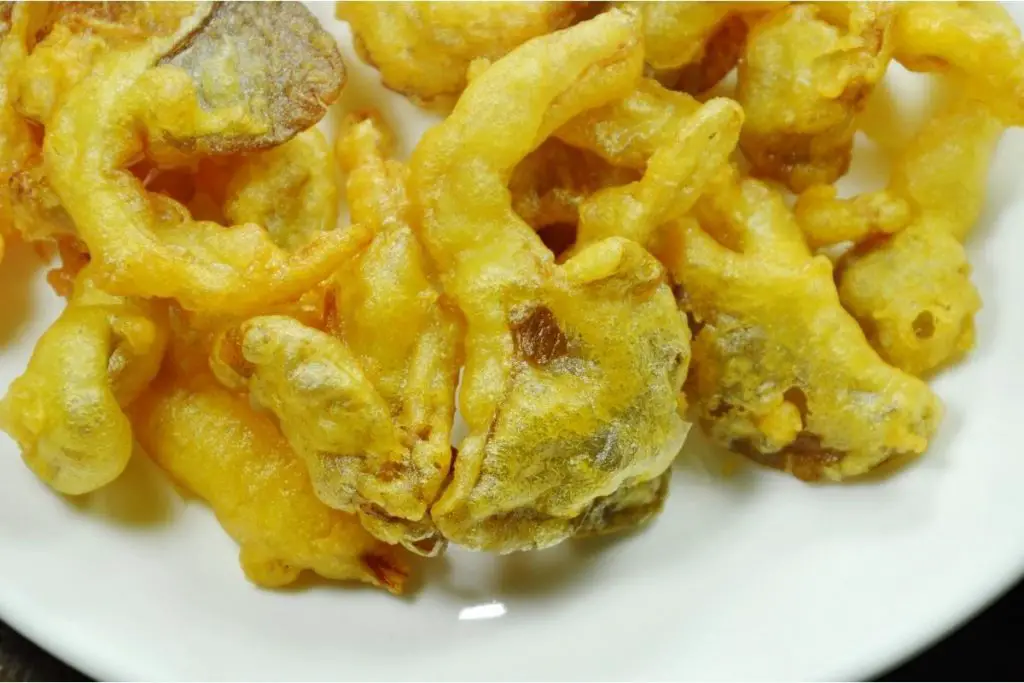
Cendawan Goreng is a deep-fried oyster mushroom that is often eaten as a snack or side dish.
The oyster mushrooms are seasoned and then dip in batter and deep fry to crispy.
- Eat As: Snack
- Where to Eat: Roadside stall
- Main Ingredients: Oyster mushroom, egg, rice flour, corn starch, turmeric, salt, chilli
- Cuisine: Malaysian
76. Satar (Spiced Fish Cake)
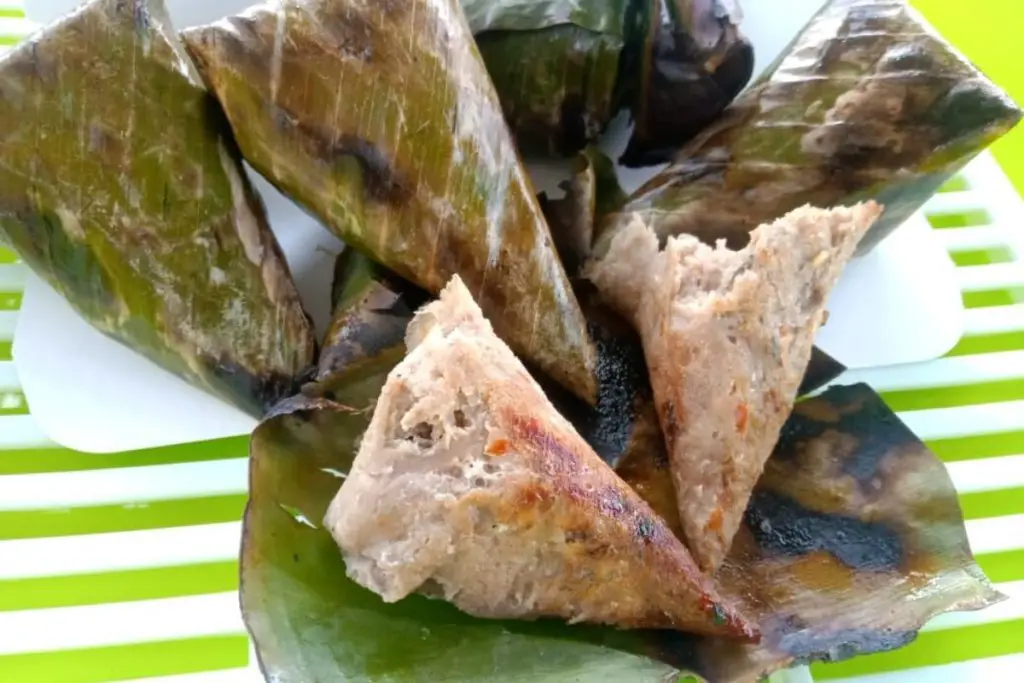
Satar is a traditional snack from the state of Terengganu, which is similar to otak-otak but is larger.
The fish cake is made by grilling the spiced fish paste in a banana leaf. The fish paste is made with sardines or mackerels, grated coconut, onions, chilli, and ginger.
- Eat As: Snack
- Where to Eat: Roadside stall, restaurant
- Main Ingredients: Fish, coconut, onion, chilli, ginger
- Cuisine: Malay
77. Tuhau (Wild Ginger)
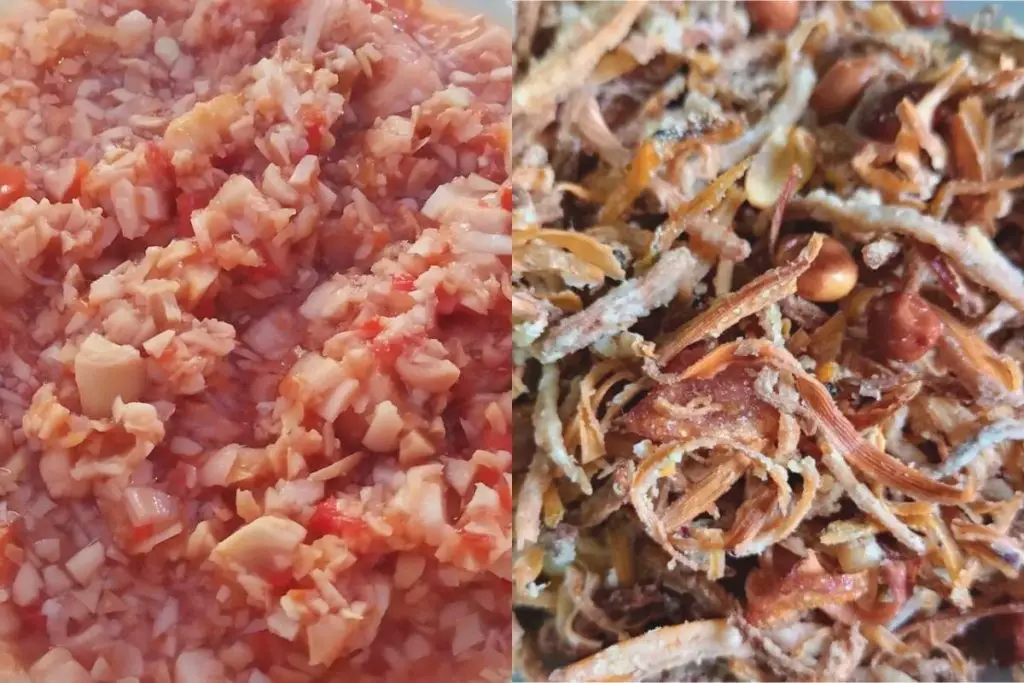
Tuhau is a type of wild ginger in Sabah and is a traditional relish that can be eaten on its own or as a condiment to other foods like fish and rice.
It is taste like lemongrass and is usually served in slices with chilli, lime, vinegar, and salt.
The fried version of Tuhau is known as Serunding Tuhau, which comes with a crispy texture.
- Eat As: Snack
- Where to Eat: Restaurant, roadside stall
- Main Ingredients: Tuhau, chilli, lime, vinegar, salt
- Cuisine: Borneo
78. Kek Lapis Sarawak (Sarawak Layer Cake)
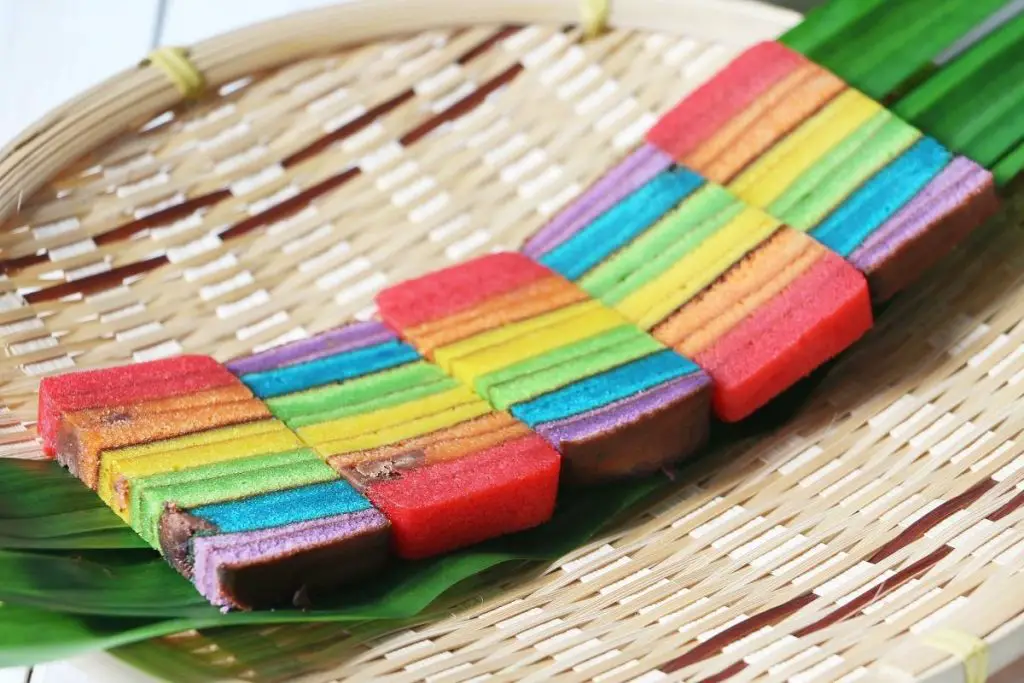
Sarawak layer cake is a popular colour layered cake in Sarawak that is often bought as a souvenir.
It is made from condensed milk, eggs, butter, jam, cake flour, and natural colourings.
The cake is delicious and colourful and can be found easily in Sarawak.
It is also a common food served on special occasions and celebrations.
- Eat As: Snack, Dessert
- Where to Eat: Restaurant, hawker centre, roadside stall
- Main Ingredients: Cake flour, condensed milk, egg, butter, jam, natural colourings
- Cuisine: Borneo
Everyday Meals: Best Malaysian Foods
79. Yong Tau Foo (Stuffed Bean Curd)
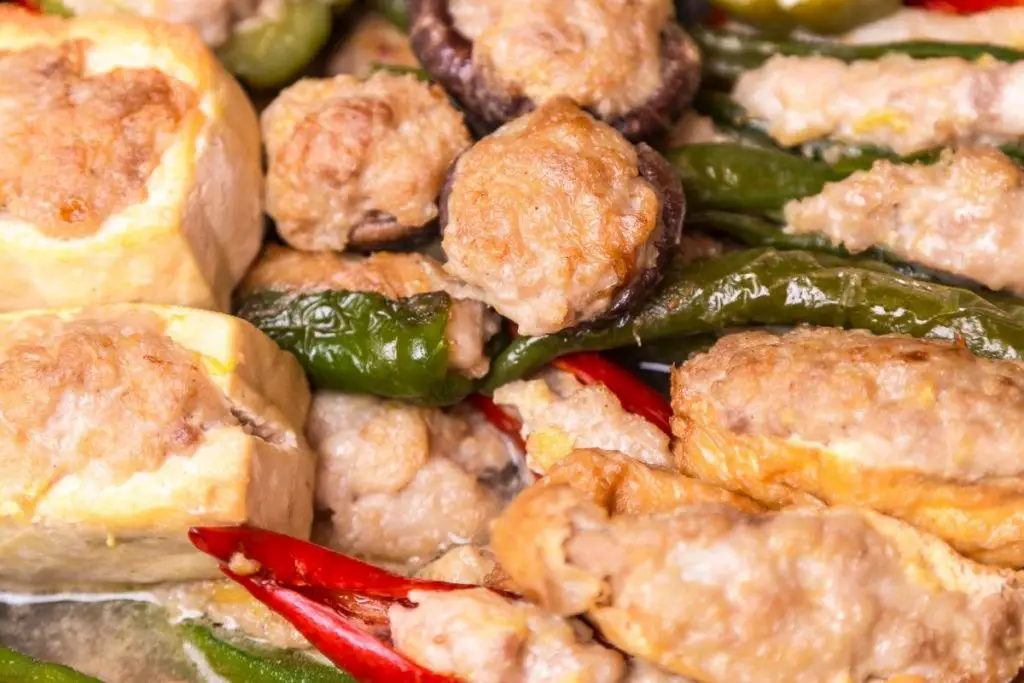
Yong Tau Foo is a famous Hakka Chinese dish in Malaysia that is served in a variety of stuffed vegetables and tofu.
Most Yong Tau Foo restaurants and stalls use a fish paste made of mackerel fish meat and surimi as filling, while some others use savoury minced pork meat as filling.
Yong tau foo is made by stuffing the meat paste (fish or pork) into chilli, okra, bitter gourd, eggplant, white tofu, and fried tofu, cooking (boil or fry), and serving in a bowl of broth accompanied by sweet and chilli dipping sauces.
It is often enjoyed with rice and other dishes like fried dumplings (highly recommended), dumplings, fish balls, vegetables, and Chee Cheong Fun (steamed rice noodle rolls).
- Eat As: Main meal
- Where to Eat: Yong Tau Foo restaurant, hawker centre, food court, roadside stall
- Main Ingredients: Meat (fish, pork), vegetables (chilli, okra, bitter gourd, eggplant), tofu
- Cuisine: Chinese
80. Mixed Rice/Nasi Campur (Home-cooking Style Dishes with Rice)
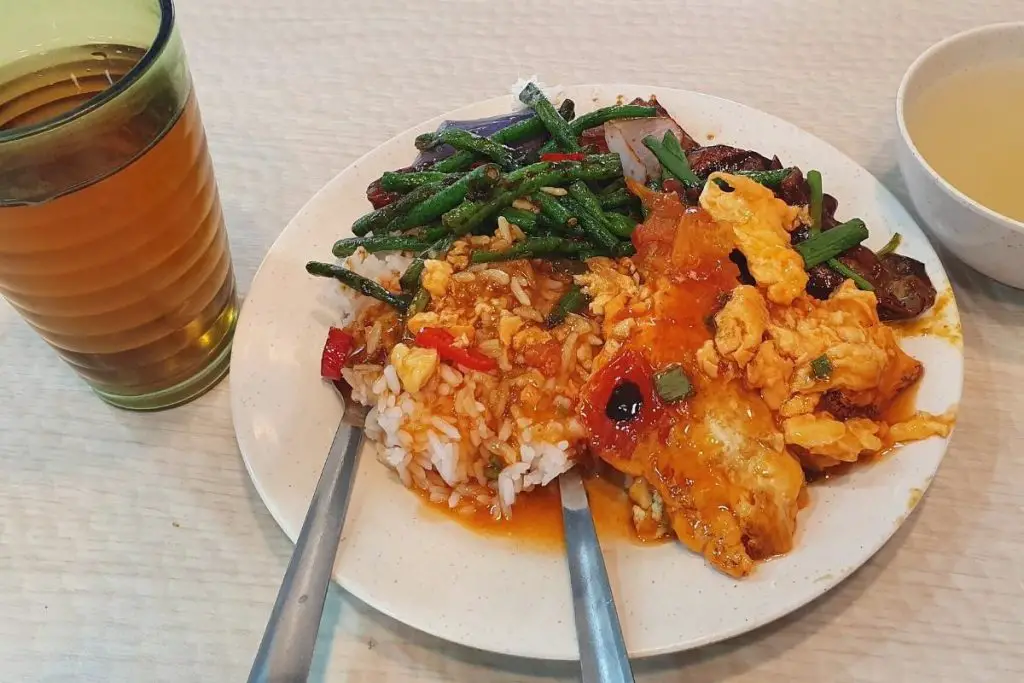
In Malaysia, you can find many mixed rice (Chinese) stalls and nasi campur (Malay) stalls. They are self-serving in which they served you the rice and you take the dishes yourself, and they will calculate the price based on the dishes and portion on your plate.
The dishes are mostly home-cooking style and consist of different styles of meat (chicken, pork, fish, and beef), seafood, vegetables, tofu, eggs, processed foods, and more.
Mixed rice and nasi campur are enjoyed by locals due to the large variety of dishes, flexibility (you can choose the dishes and portion), quickness and are cheaper compared to restaurants. It is part of the eating culture of Malaysians.
You can find mixed rice at hawker centres, covered street stalls, food courts, and Mixed Rice restaurants, and nasi campur at covered street stalls, food courts, and Nasi Campur restaurants. The stalls or restaurants are usually crowded during lunch and dinner hours.
- Eat As: Main meal
- Where to Eat: Mixed rice (hawker centre, food court, Mixed Rice restaurant, covered street stall); Nasi campur (Nasi Campur restaurant, covered street stall, food court)
- Main Ingredients: Rice, meats, seafood, vegetables, tofu, egg
- Cuisine: Chinese (mixed rice), Malay (nasi campur)
Meat Dishes in Malaysia: Best Malaysian Foods
81. Rendang (Chicken, Beef, Lamb)
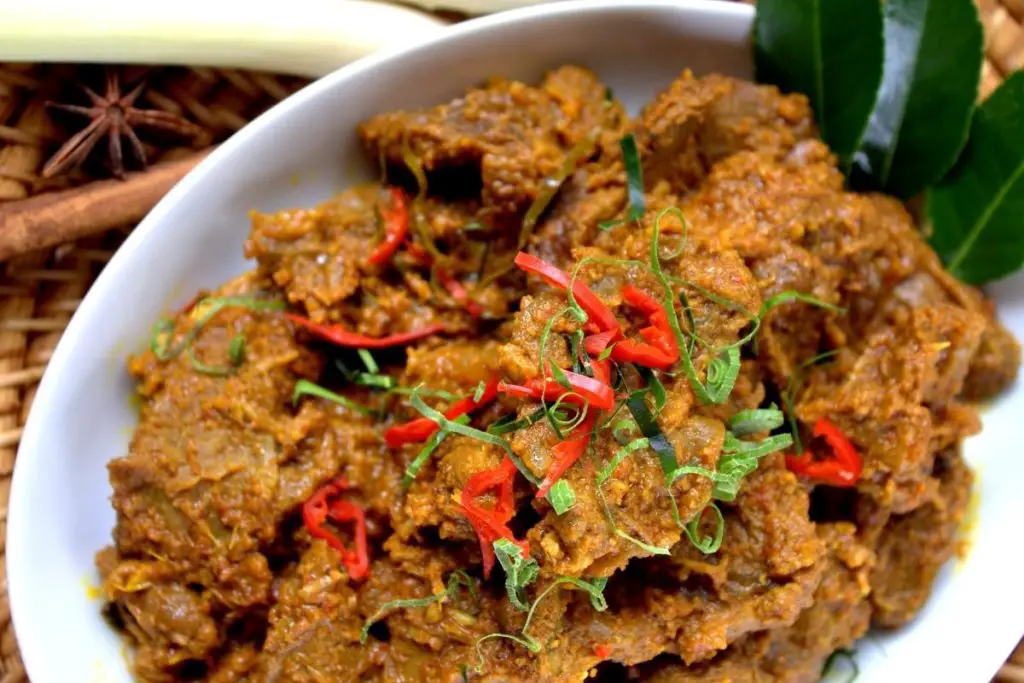
Chicken, beef or lamb rendang is a Malaysian traditional dish prepared by braising the chicken or beef in a mixture of coconut milk and spices (ginger, lemongrass, chilli, galangal, cinnamon, etc.).
Rendang is rich and creamy with sweetness and mild spiciness. The meat, usually chicken, beef or lamb, is tender and flavourful after absorbing the spices during the slow cooking process.
It is best when eating with a plate of rice.
It is also commonly paired with nasi lemak, and you can find many stalls and restaurants that sell nasi lemak with chicken rendang.
Rendang is no doubt one of the best dishes in Malaysia.
- Eat As: Main meal (as a side dish)
- Main Ingredients: chicken or beef or lamb, coconut milk, spices (ginger, lemongrass, chilli, galangal, cinnamon, etc.)
- Where to Eat: Restaurant and café that sell local Malaysian cuisine, Nyonya restaurant
- Cuisine: Southeast Asian
82. Char Siew (BBQ Pork)
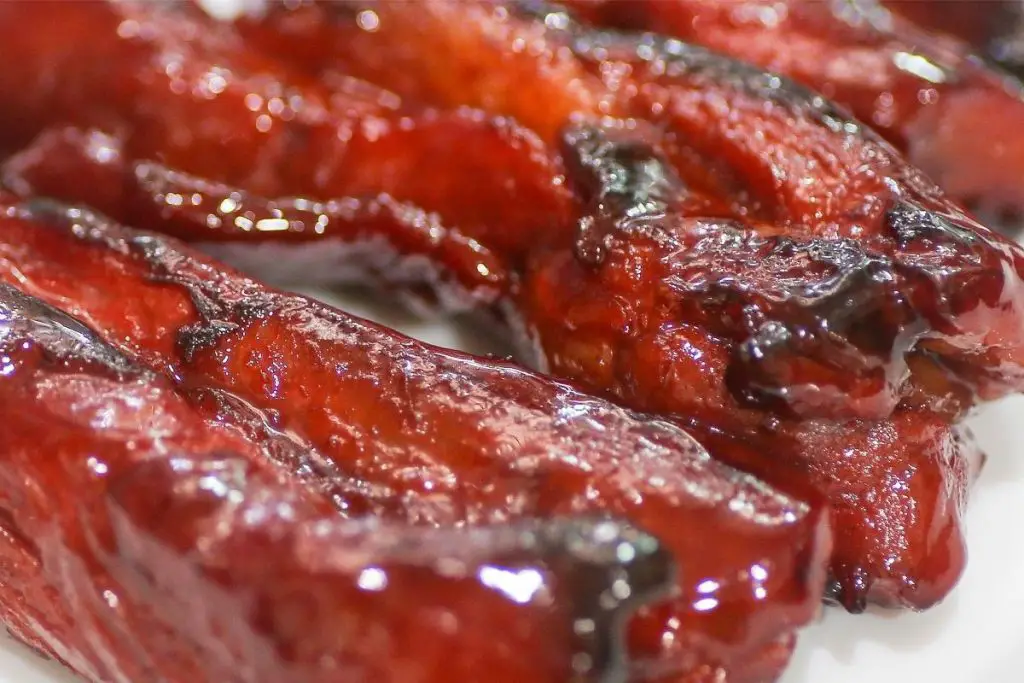
Char siew (barbecued pork) is a famous dish in Malaysia among the Chinese.
It is delicious, flavourful, sweet, and tender.
The dish is made by marinating the strips of boneless pork shoulder in a sauce consisting of honey, dark soy sauce, hoisin sauce, five spice powder, and fermented tofu, skewering it with long forks, and then slowly cooking over fire or in an oven.
It is often eaten with rice, known as char siew rice, or with other dishes like dry wonton mee, Sarawak kolo mee and chicken rice.
You can enjoy it in hawker centres, restaurants, and Chinese restaurants.
- Eat As: Main meal (as a side dish)
- Where to Eat: Hawker centre, food court, restaurant
- Main Ingredients: pork, honey, dark soy sauce, hoisin sauce, five spice powder, fermented tofu
- Cuisine: Chinese
83. Siew Yoke (Roasted Pork Belly)
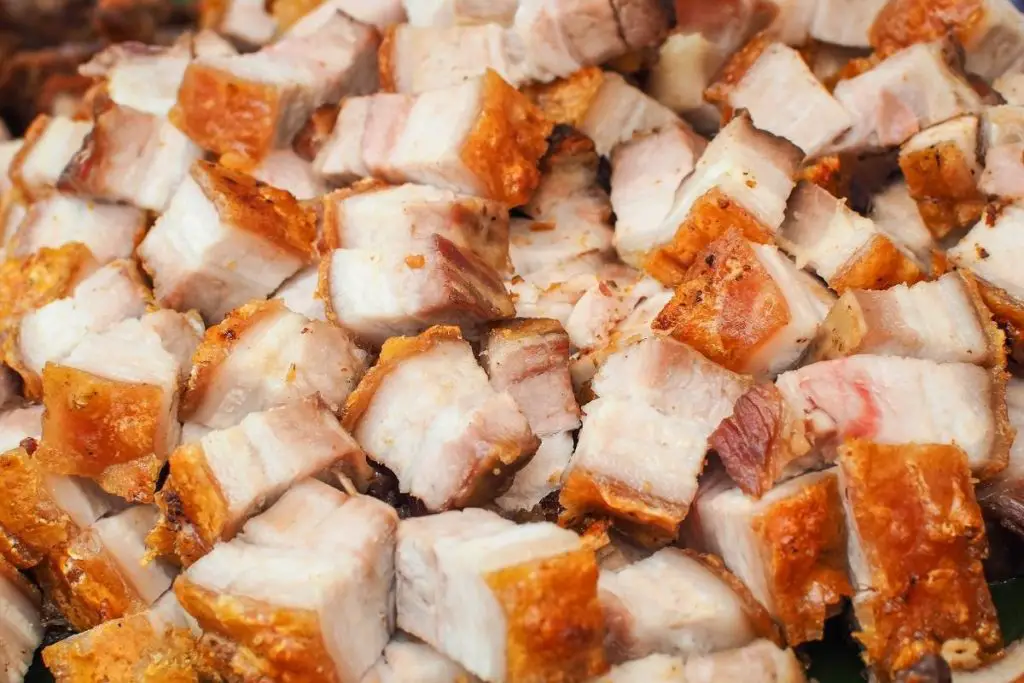
Siew yoke is roasted pork belly, a famous dish enjoyed by local Chinese due to its tender meat with crispy and crunchy skin.
It is made by slowly roasting the seasoned pork belly until the pork skin is evenly blistered, however, preparing a perfectly roasted pork belly with crispy skin is not an easy task.
It is usually eaten with rice or directly as snacks, it is also going well with beer.
It is also used as an accompaniment for many popular Chinese dishes like chicken rice, siew yoke fried rice, bitter gourd siew yoke rice, and siew yoke wonton mee.
You can find it at chicken rice stalls, Chinese restaurants, Chinese morning markets and even mobile vendors at the roadside.
- Eat As: Main meal (as a side dish), snack
- Where to Eat: Hawker centre, food court, restaurant, roadside stall
- Main Ingredients: Pork, five spice powder, salt, rice wine vinegar
- Cuisine: Chinese
84. Roasted Duck
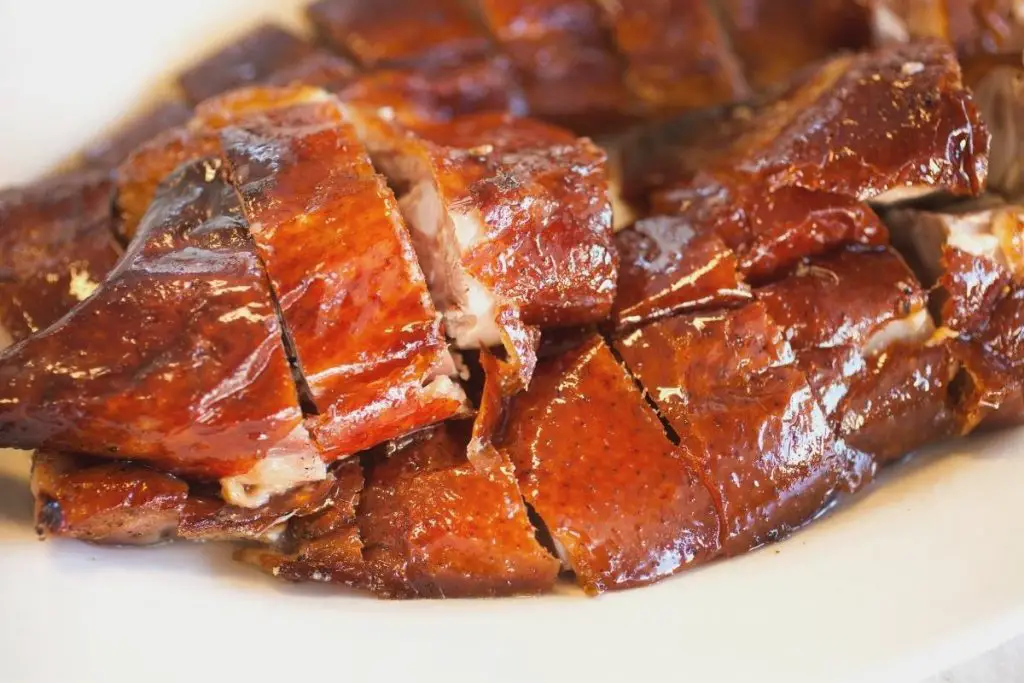
Roasted duck is another popular roasted dish in Malaysia.
The duck is well-seasoned and roasted to a crispy texture with tender and juicy meat on the inside.
If you love to eat duck, then you should try this out.
It is usually enjoyed with rice, porridge or noodles.
You can find the dish at roasted duck restaurants, Chinese restaurants, and hawker centres.
- Eat As: Main meal (as a side dish)
- Where to Eat: Hawker centre, food court, restaurant, roadside stall
- Main Ingredients: Pork, five spice powder, salt, rice wine vinegar
- Cuisine: Chinese
85. Kari Ayam (Chicken Curry)
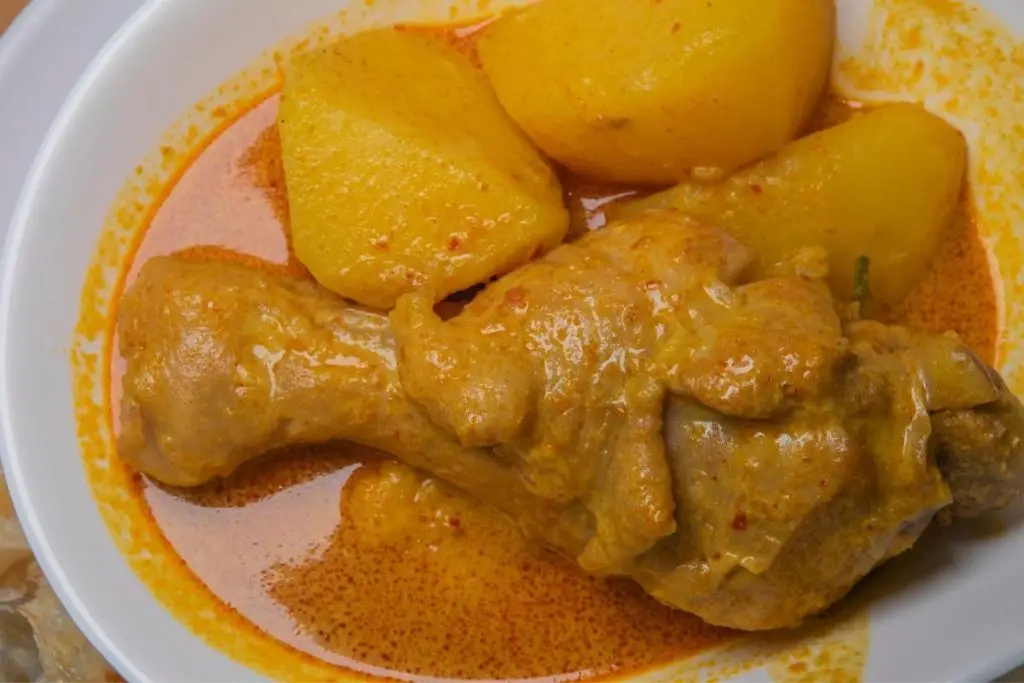
Kari Ayam is a popular dish in Malaysia that can be found in Indian, Chinese, and Malay restaurants, hawker centres and roadside stalls.
The flavourful dish is made by cooking the chicken pieces in a curry made with spices like chilli, cumin, turmeric, galangal, fennel, cinnamon, and coriander seeds and ingredients like kaffir lime leaves, lemongrass, and coconut milk.
It is usually eaten with rice or bread.
- Eat As: Main meal (as a side)
- Where to Eat: Hawker centre, restaurant, roadside stall
- Main Ingredients: Chicken, coconut milk, lemongrass, kaffir lime leaves, spices (chilli, cumin, turmeric, galangal, fennel, cinnamon)
- Cuisine: Indian
86. Ayam Pongteh (Nyonya Stewed Chicken and Potato)
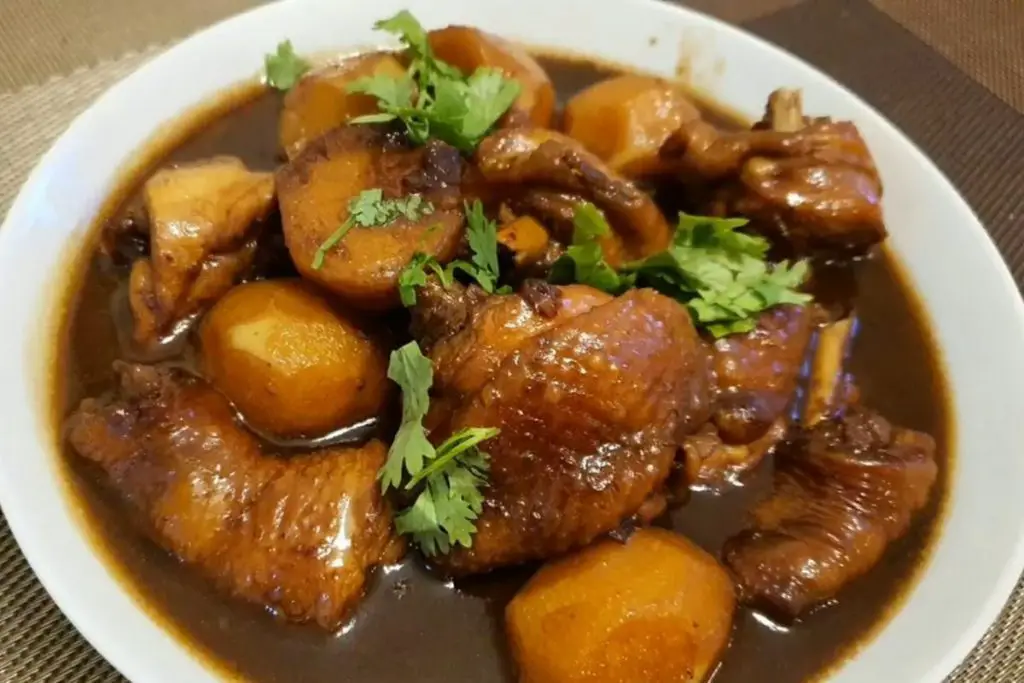
Ayam Pongteh is a famous Malacca Nyonya dish that consists of stewed tender chicken meat, potatoes and fermented soybean paste (taucu/taucheo).
It is made with chicken, potatoes, taucu (fermented soybean paste), gula Melaka (Malacca palm sugar), shallots, garlic cloves, dark soy sauce, soy sauce, tofu puffs, star anise, and cinnamon sticks.
You can enjoy the dish in Nyonya restaurants, cafés, and restaurants that serve Nyonya cuisine.
- Eat As: Main meal (as a side)
- Where to Eat: Nyonya restaurant, restaurant
- Main Ingredients: Chicken, potato, fermented soybean paste (taucu/taucheo), gula Melaka (Malacca palm sugar), shallots, garlic cloves, dark soy sauce, soy sauce, tofu puffs, star anise, cinnamon sticks
- Cuisine: Nyonya
87. Ayam Masak Merah (Chicken in Spicy Tomato Sauce)
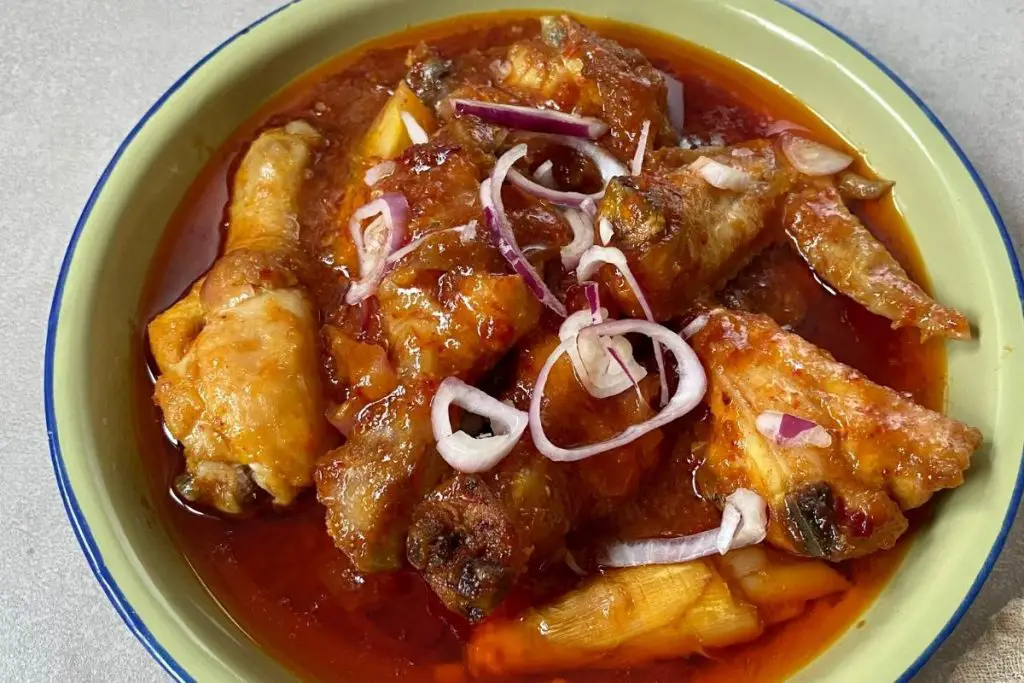
Ayam Masak Merah is a Malay-style chicken dish made by simmering the fried chicken in a spicy, rich, sweet, and creamy tomato sauce made with chilli peppers, tomatoes, garlic, onions, coconut milk, and spices like cloves, cinnamon, galangal, and cardamom.
It is also one of the festival dishes that often appeared on special occasions.
Due to its tangy taste, it is usually eaten with rice and other dishes.
You can find the dish at Malay restaurants, Indian restaurants, and roadside stalls.
- Eat As: Main meal (as a side)
- Where to Eat: Restaurant, roadside stall
- Main Ingredients: Chicken, chilli pepper, tomato, garlic, onion, coconut milk, spices (cloves, cinnamon, galangal, cardamom)
- Cuisine: Malay
88. Tandoori Chicken
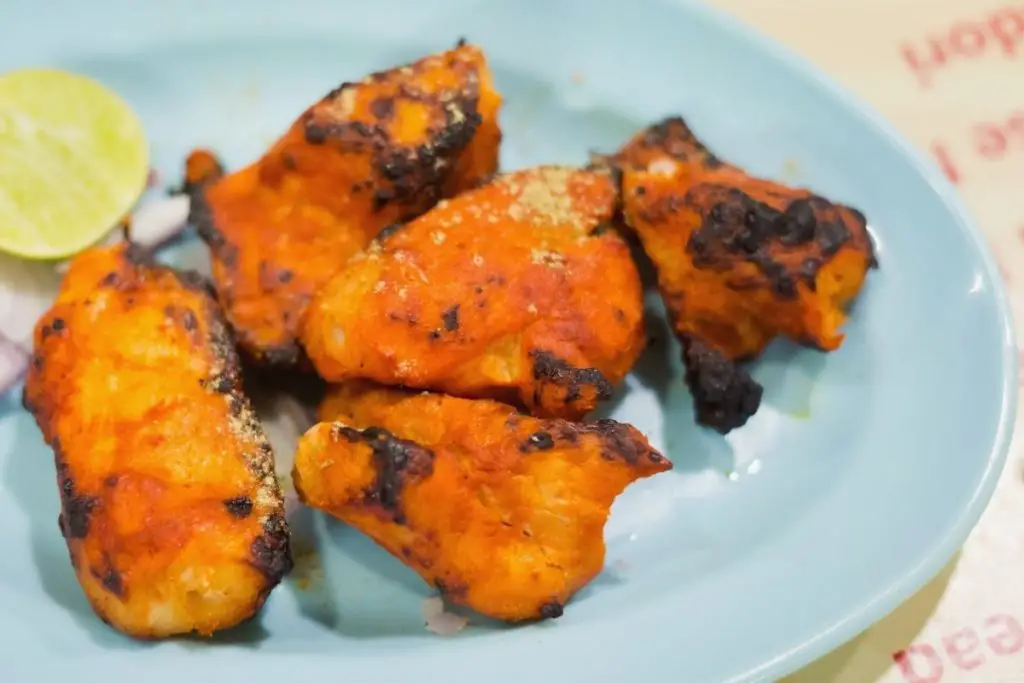
Tandoori chicken is a chicken dish made by baking the chicken marinated in yoghurt and spices inside a clay tandoor oven.
It can be found in Mamak and is often eaten with naan.
- Eat As: Main meal (as a side), snack
- Where to Eat: Mamak
- Main Ingredients: Chicken, yoghurt, lemon, salt, garlic, ginger, Masala salt, chilli, coriander, turmeric
- Cuisine: Indian
89. Gulai Ayam Kampung (Village Chicken Curry)
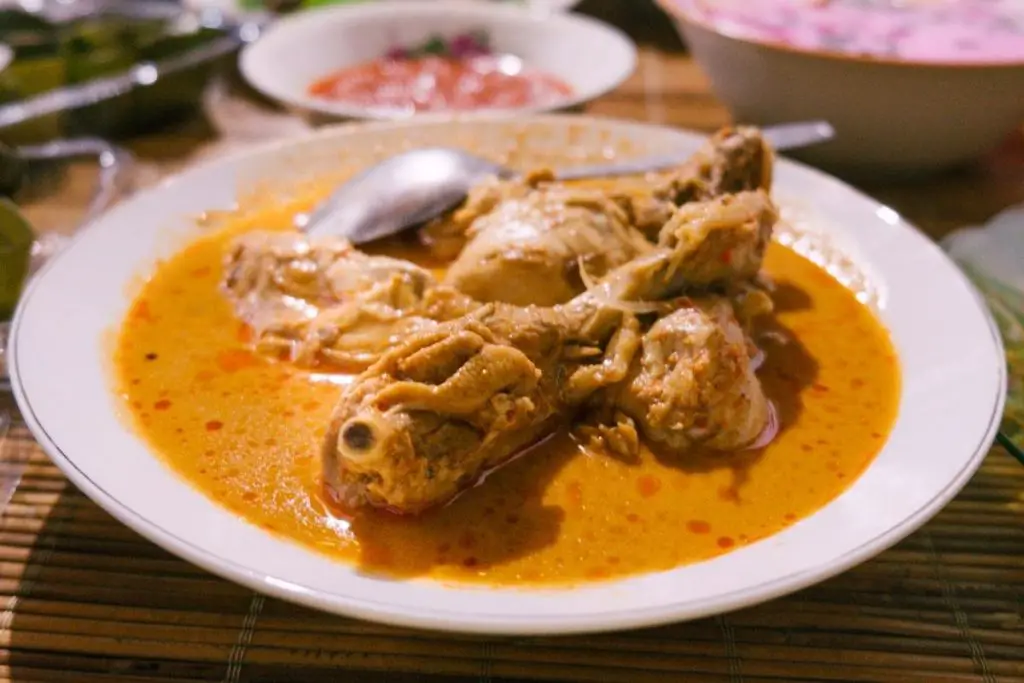
Gulai Ayam Kampung is a Malay-style chicken curry dish with great aroma and taste.
It uses ayam kampung (village chicken) which is known to be healthier than normal chicken due to the living environment and the food.
The chicken is cooked with ingredients like red onion cloves, garlic, ginger, chicken curry spices, coconut milk, tamarind, palm sugar and spices like star anise, cinnamon, cardamom and turmeric.
You can find it at Malay restaurants and roadside stalls.
- Eat As: Main meal (as a side dish)
- Where to Eat: Restaurant, roadside stall
- Main Ingredients: Chicken, red onion cloves, garlic, ginger, chicken curry spices, coconut milk, tamarind, palm sugar, spices (star anise, cinnamon, cardamom, turmeric)
- Cuisine: Malay
90. Kari Ayam Kapitan (Dry Chicken Curry)
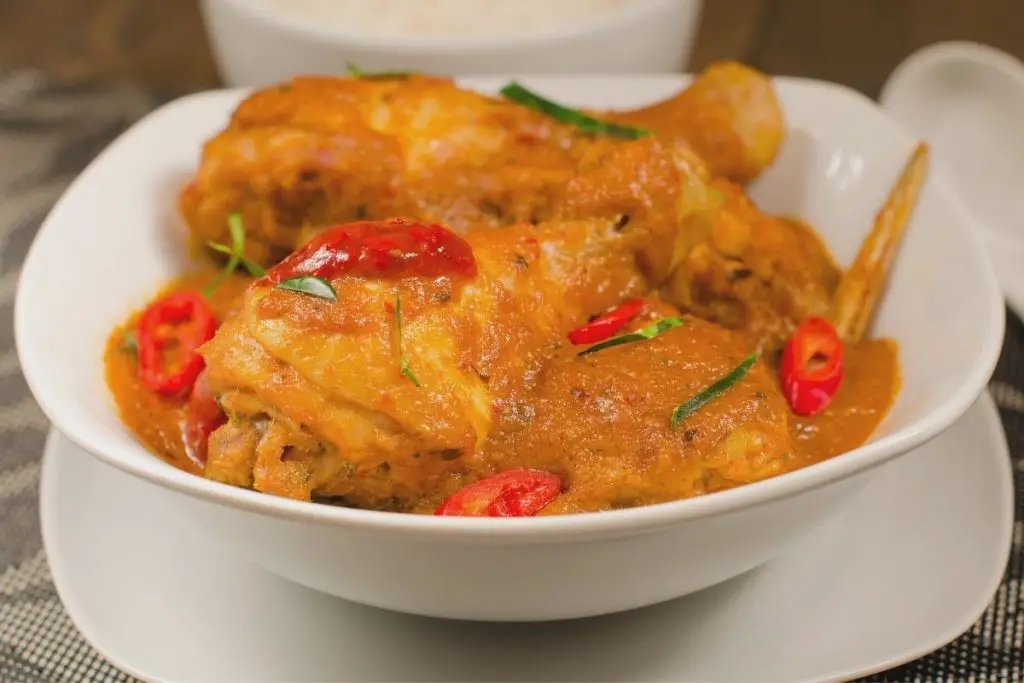
The Malaysian Chicken Curry Kapitan is a Nyonya (Peranakan) dish that has a tangy and mildly spicy flavour. It is drier, thicker and richer than typical chicken curry.
The Nyonya dish is made from chicken, tamarind juice, turmeric root, belacan (shrimp paste), candlenuts, chilli, palm sugar, herbs, and spices.
If other curries are too spicy for you, then this milder curry dish is ideal for you.
- Eat As: Main meal (as a side dish)
- Where to Eat: Nyonya restaurant, restaurant
- Main Ingredients: Chicken, tamarind juice, turmeric root, belacan (shrimp paste), candlenuts, chilli, palm sugar, shallots, garlic, onions, galangal, ginger, lemongrass, kaffir lime leaves
- Cuisine: Nyonya
91. Masak Lemak/Masak Lemak Cili Api (Yellow Malaysian Curry)
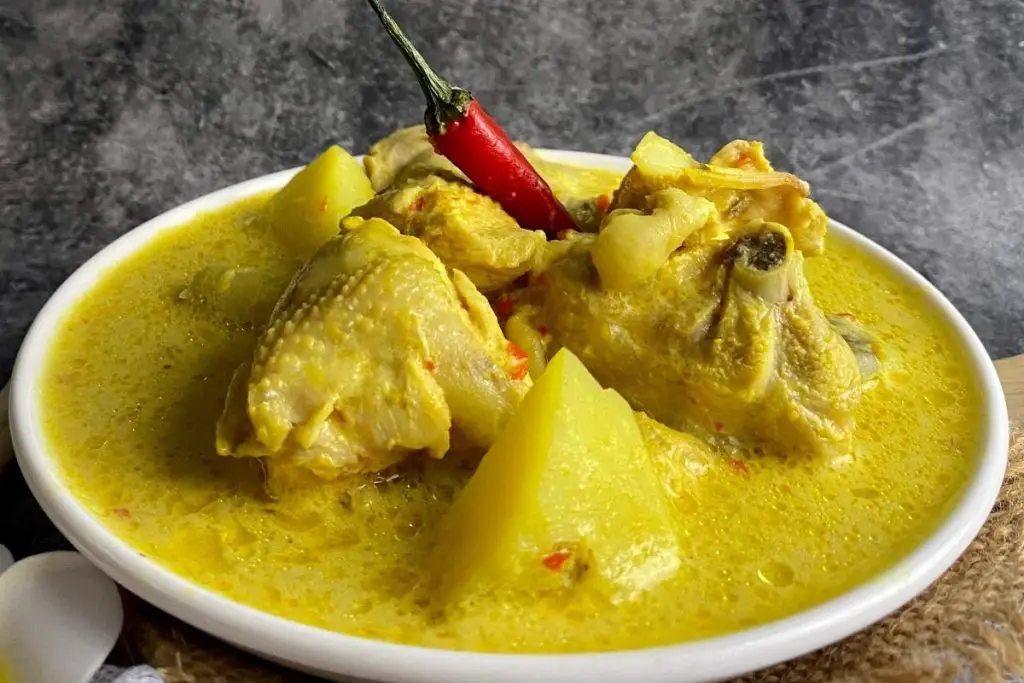
Masak Lemak also known as masak lemak cili api, is a yellow colour curry that is flavourful, creamy, and spicy.
The dish is made by cooking the meat (chicken, beef, duck, fish, or seafood) in masak lemak cili api (yellow curry) made with turmeric, santan (coconut milk), herbs, and spices.
It is usually served with rice, vegetables, and sambal.
- Eat As: Main meal (as a side dish)
- Where to Eat: Restaurant, roadside stall
- Main Ingredients: Meat (chicken, beef, duck)/seafood, turmeric, coconut milk, turmeric powder, lime, lemongrass, tamarind, kaffir lime leaves, onion, garlic, chilli
- Cuisine: Malay
92. Sinalau Bakas (Smoked Wild Boar Meat)
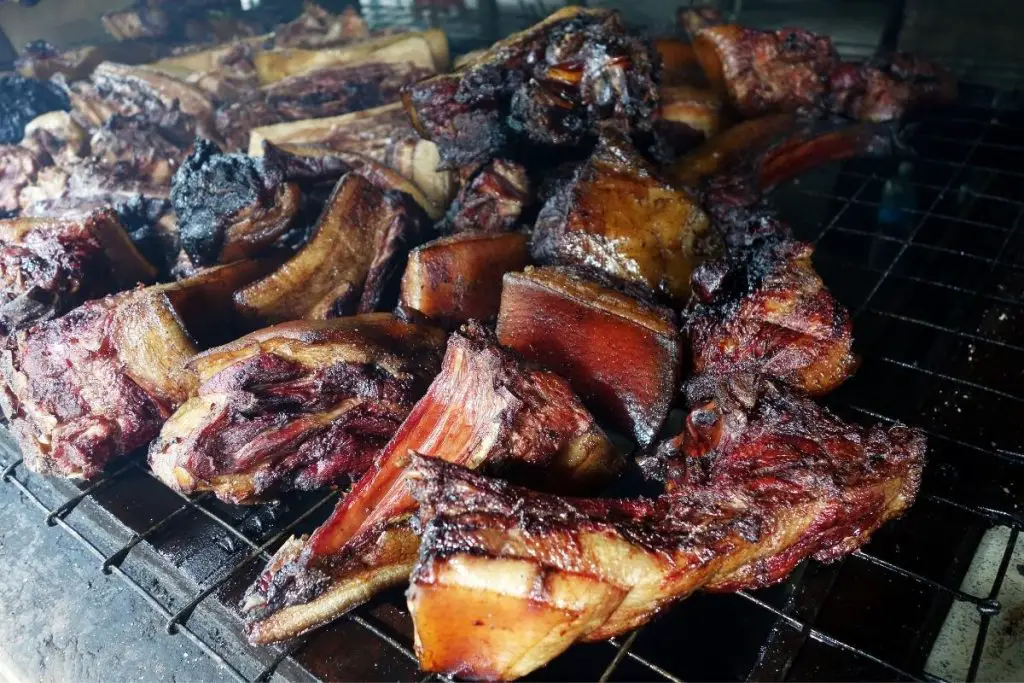
Sinalau Bakas is a smoked wild boar meat dish that is famous among the Kadazan-Dusun community in Sabah.
The dish is made by roasting the boar meat over a wood fire and is usually served with limes.
It is also a snack to go with beer.
- Eat As: Main meal, snack
- Where to Eat: Restaurant, roadside stall
- Main Ingredients: Wild boar meat, lime, salt
- Cuisine: Borneo
93. Ayam Pansuh/Manok Pansoh (Chicken Cooked in Bamboo)
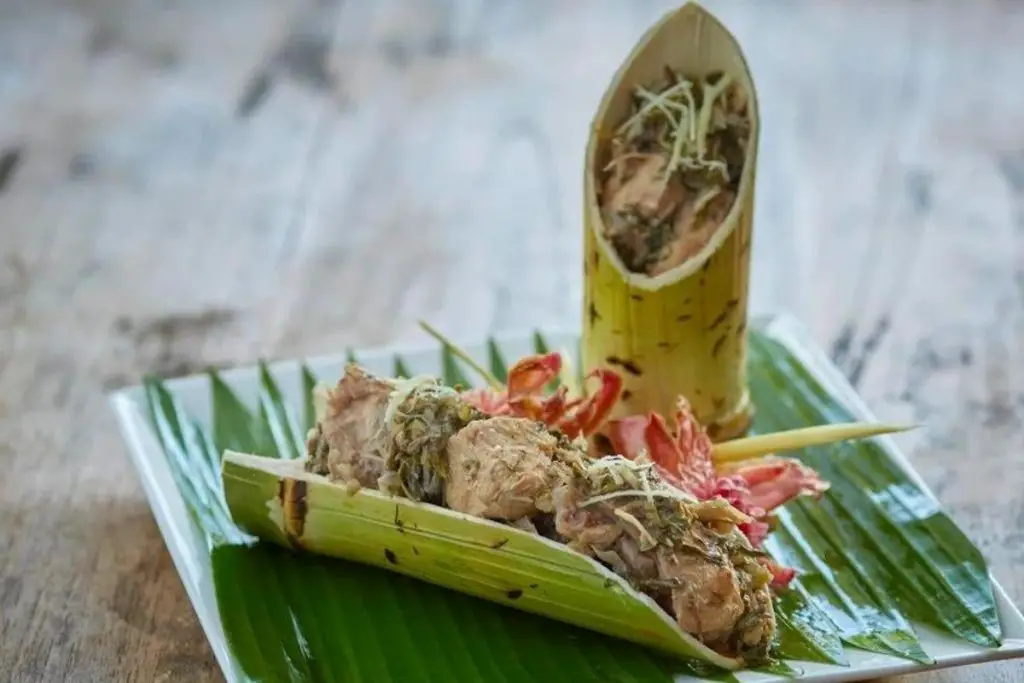
Ayam pansuh or manok pansoh is a famous Sarawak dish from Iban and Bidayuh community.
The dish is made by cooking the chicken meat in a bamboo stalk filled with ingredients like garlic, red onion, ginger, lemongrass, galangal, red chillies and bungkang/salam leaves, seasonings and water and covered with tapioca leaves from the cassava.
The chicken is tender and juicy, and the gravy is aromatic and delicious!
It is also one of the festival dishes served on Gawai Dayak, a festival to celebrate the end of harvesting.
You can find the dish at stalls and restaurants in Sarawak and Peninsular restaurants that serve Sarawak dishes.
- Eat As: Main meal (as a side dish)
- Where to Eat: Restaurant, hawker centre, roadside stall
- Main Ingredients: Chicken, garlic, red onion, ginger, lemongrass, galangal, red chilli, bungkang/salam leaves
- Cuisine: Borneo
94. Manok Kacangma (Chicken with Herbs)
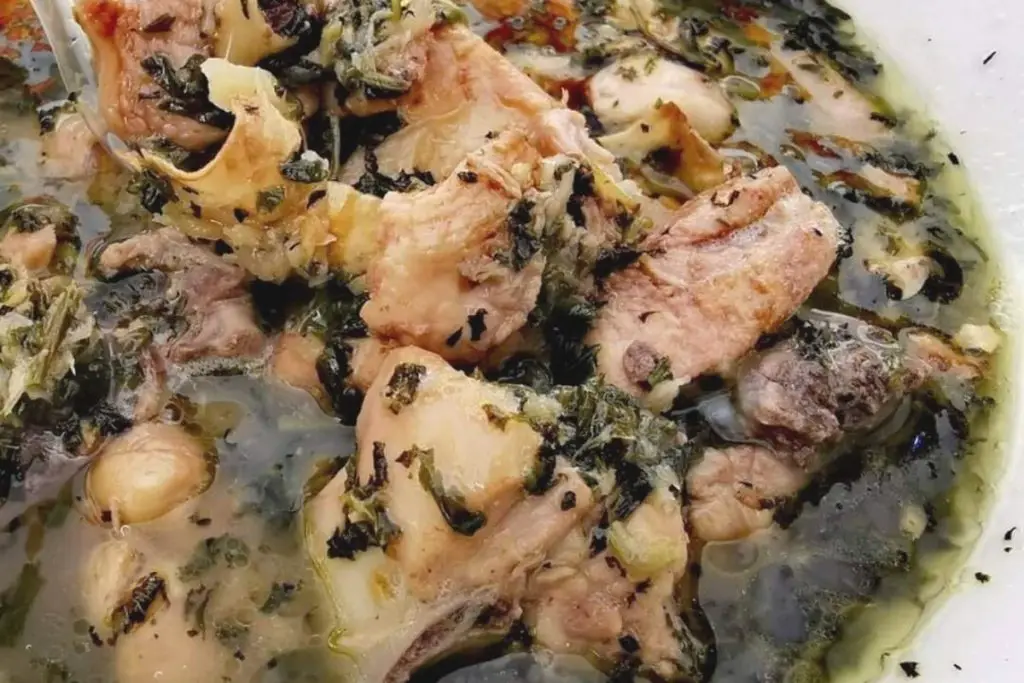
Manok Kacangma is a popular Sarawak dish that is traditionally served to women during their confinement periods but can be eaten by all people as well.
The dish is influenced by Chinese cuisine and consists of chicken pieces served in a broth made from ginger, kacangma (a local remedial herb known as motherwort), and Chinese wine.
You can find the dish at stalls and restaurants in Sarawak and Peninsular restaurants that serve Sarawak dishes.
- Eat As: Main meal (as a side dish)
- Where to Eat: Restaurant, hawker centre, roadside stall
- Main Ingredients: Chicken, ginger, kacangma, Chinese wine
- Cuisine: Borneo
Malaysia Seafood Dishes: Best Malaysian Foods
95. Ikan Bakar (Grilled Fish)
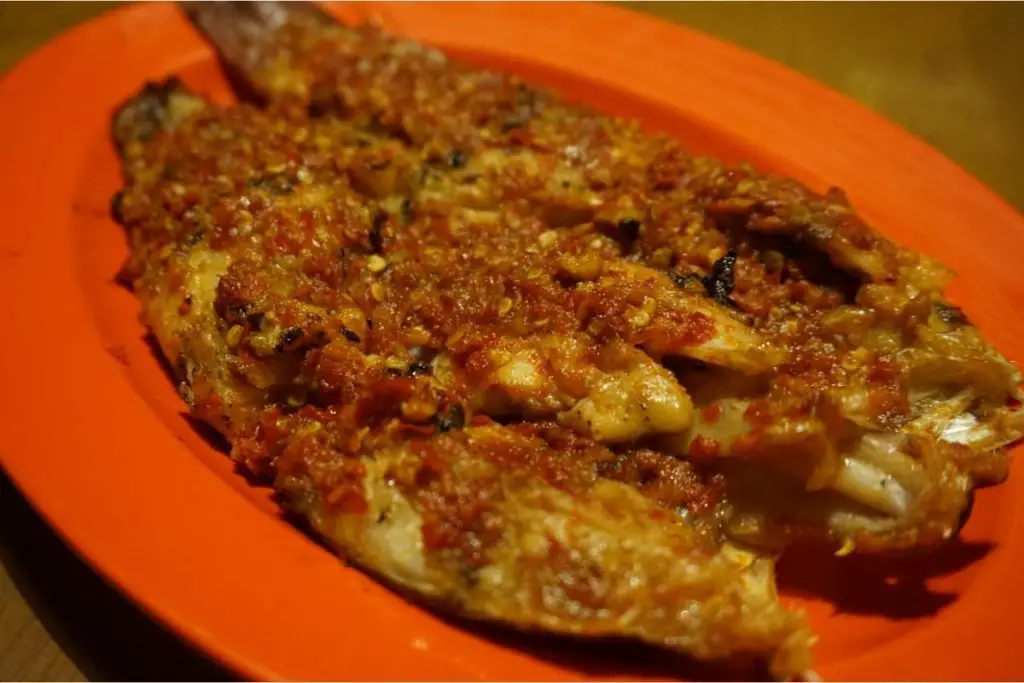
Ikan Bakar is a famous Malay dish from Malaysia.
The fish, usually mackerel, stingray, red snapper, and Barramundi (siakap) is marinated with delicious sambal and spices and is put on a banana leaf and grilled over fire.
It is often eaten with white rice and other dishes like vegetables, grilled squid and grilled prawns.
- Eat As: Main meal (as a side)
- Where to Eat: Restaurant, roadside stall
- Main Ingredients: Fish, sambal, chilli
- Cuisine: Malay
96. Kari Kepala Ikan (Fish Head Curry)
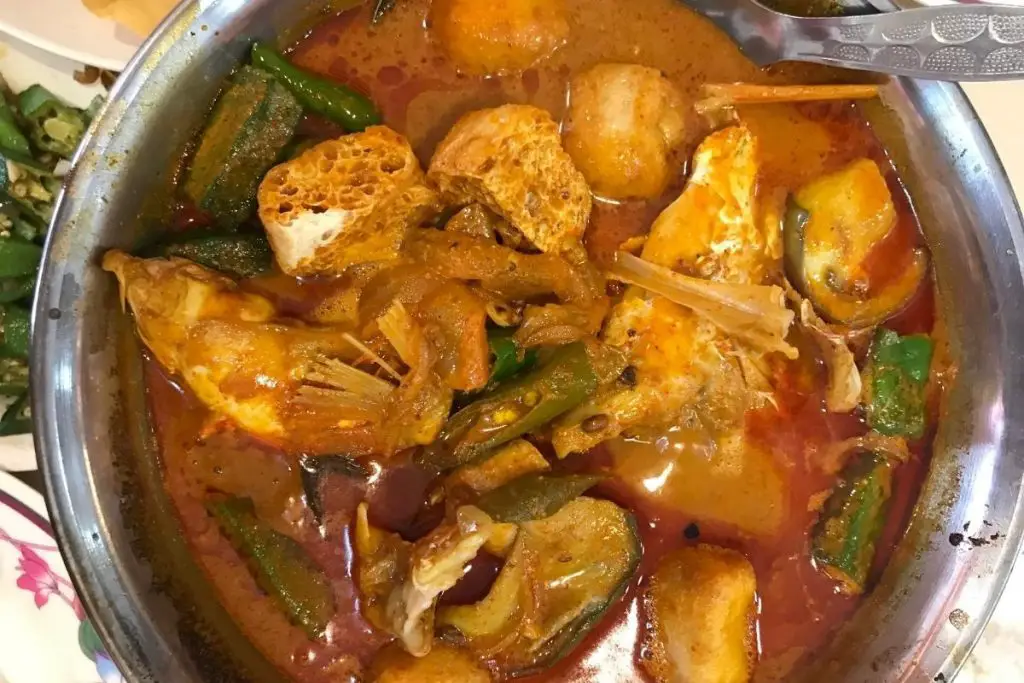
Fish head curry is a popular dish that combines curry and fish head of red snapper.
It is made with a head of red snapper, tofu puffs, vegetables like eggplant, long bean, okra, and cabbages and spices stewed in a pot of curry.
The fish head curry is often eaten with rice.
You can enjoy the dish in Chinese, Indian and Malay restaurants.
- Eat As: Main meal (as a side)
- Where to Eat: Restaurant
- Main Ingredients: Fish head, tofu puffs, vegetables (eggplant, long bean, okra, cabbages), curry leaves, lemongrass, tomato, chilli, fish curry powder, belacan (shrimp paste), salt, sugar, coriander leaves
- Cuisine: Indian/Chinese
97. Asam Pedas (Spicy Tamarind Fish)
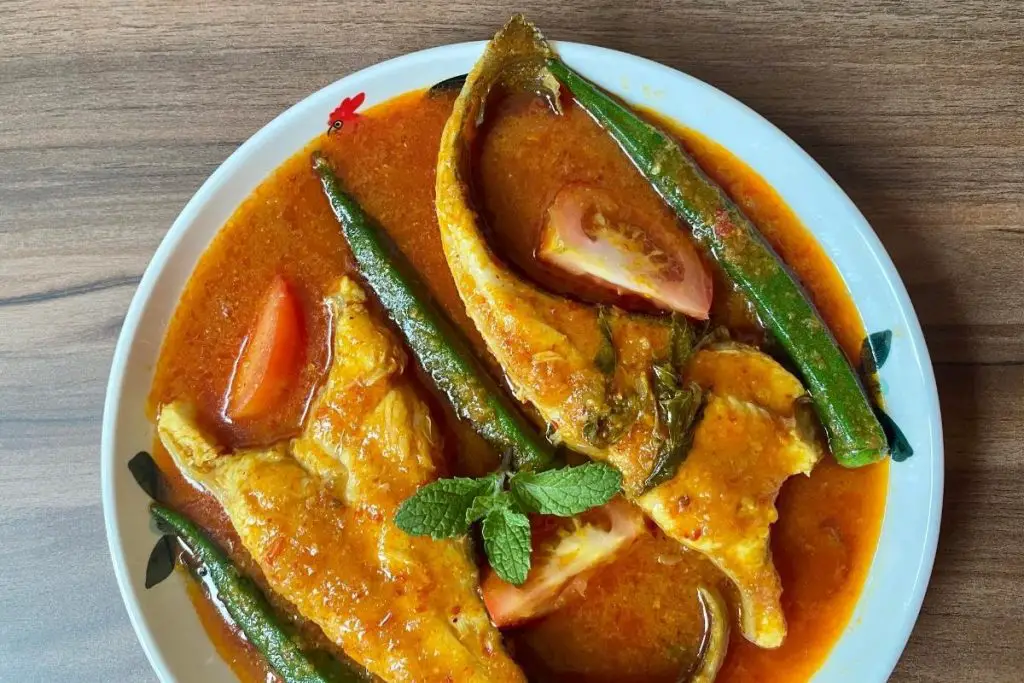
Asam pedas is a popular Malaysian dish that will stimulate your appetite.
The fish usually is mackerel or stingray and is stewed in a spicy and sour tamarind sauce.
The tamarind sauce is made of tamarind, shrimp paste, ginger, chillies, garlic, herbs, and more, which features a spicy and tangy flavour.
Due to its strong taste, it is best to eat it with white rice.
- Eat As: Main meal (as a side)
- Where to Eat: Restaurant
- Main Ingredients: Fish, tamarind, shrimp paste, ginger, chillies, garlic, galangal, turmeric, lemongrass, okra, tomato
- Cuisine: Southeast Asian
98. Sambal Udang (Prawns in Chili Paste)
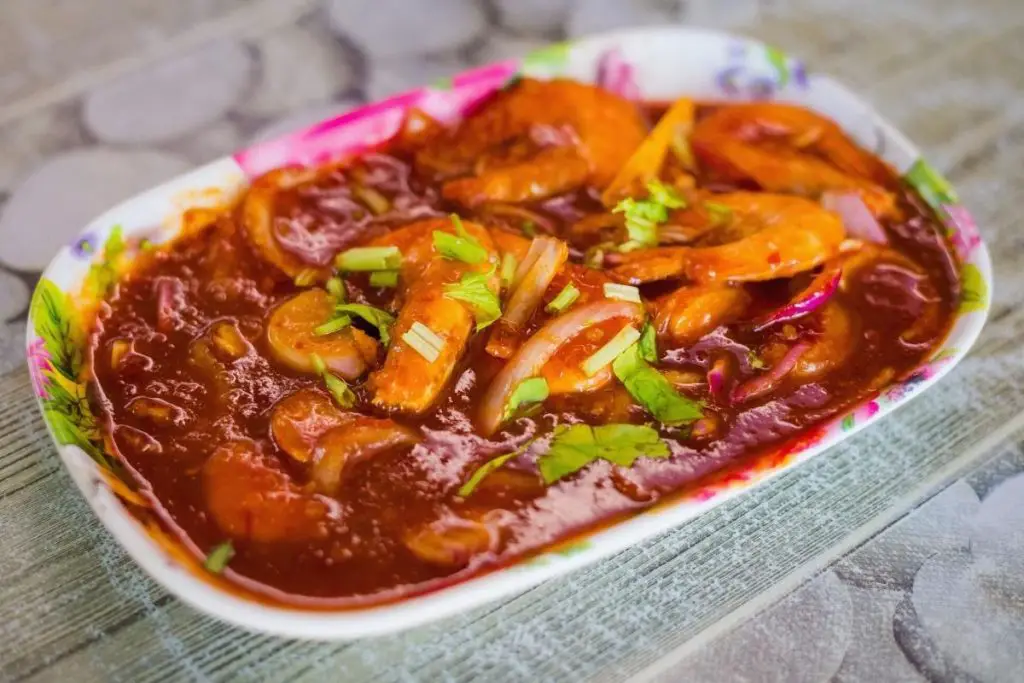
Sambal Udang is a dish in Peranakan cuisine that consists of whole prawns or shrimps, sambal, belacan (shrimp paste), tamarind, and chilli.
It has a spicy and tangy taste and is best to eat with white rice.
- Eat As: Main meal (as a side dish)
- Where to Eat: Restaurant, roadside stall
- Main Ingredients: Prawn, sambal paste, belacan (shrimp paste), kaffir lime leaves, tamarind, chilli
- Cuisine: Nyonya
99. Pinasakan/Pinasakan Sada (Sabah Stewed Fish)
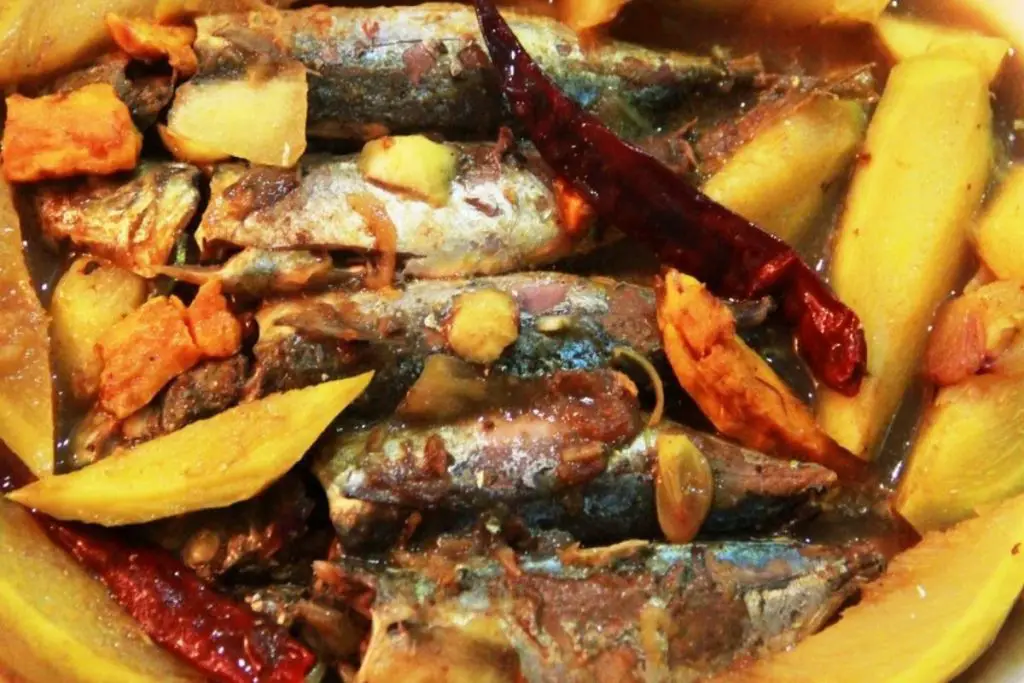
Pinasakan is a famous traditional fish dish from Kadazan-Dusun community in Sabah.
The ikan basung/ikan sardin (sardine) is sautéed with turmeric, takob akob fruit and Bambangan seed.
It is usually eaten with rice.
- Eat As: Main meal (as a side dish)
- Where to Eat: Restaurant
- Main Ingredients: Fish, turmeric, takob akob fruit, Bambangan seed
- Cuisine: Borneo
100. Umai (Sarawak Raw Fish Dish)
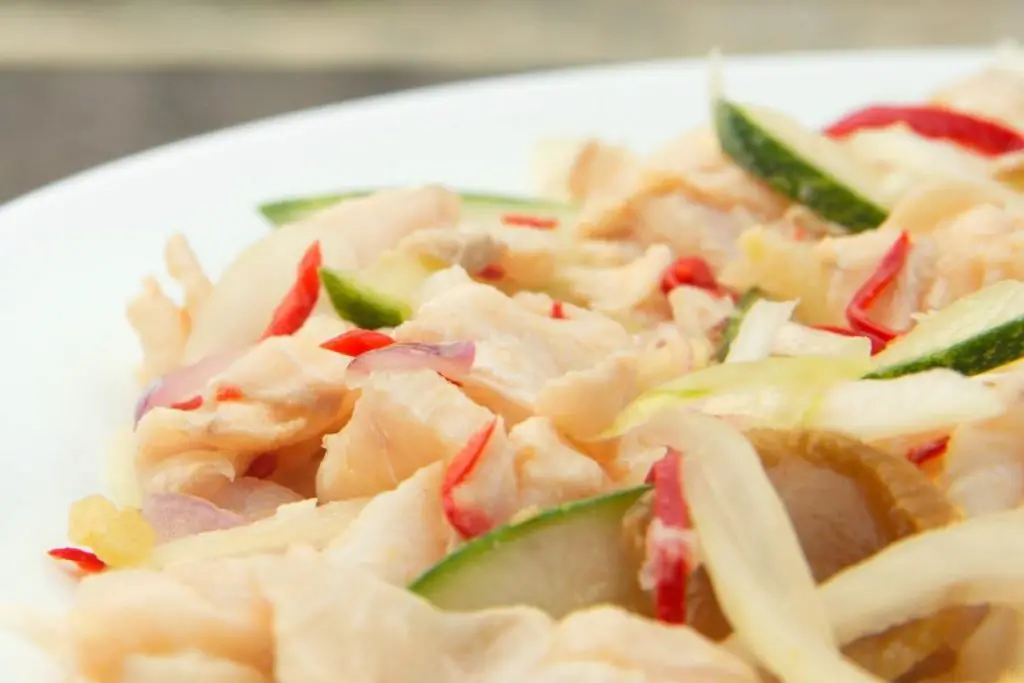
Umai is a famous Sarawak dish from Melanau and is one of the main foods for fishermen.
It is prepared using thin slices of raw fish marinated with calamansi lime or asam paya/asam kelubi (a sour fruit), chilli, onion, and a pinch of salt.
It is often served with a bowl of roasted sago pearls made with sago starch and coconut milk.
- Eat As: Main meal
- Where to Eat: Restaurant, hawker centre, roadside stall
- Main Ingredients: Fish, calamansi lime, chilli, onion, salt
- Cuisine: Borneo
Desserts in Malaysia: Best Malaysian Foods
101. Cendol (Iced Desserts with Green Rice Flour Jelly)
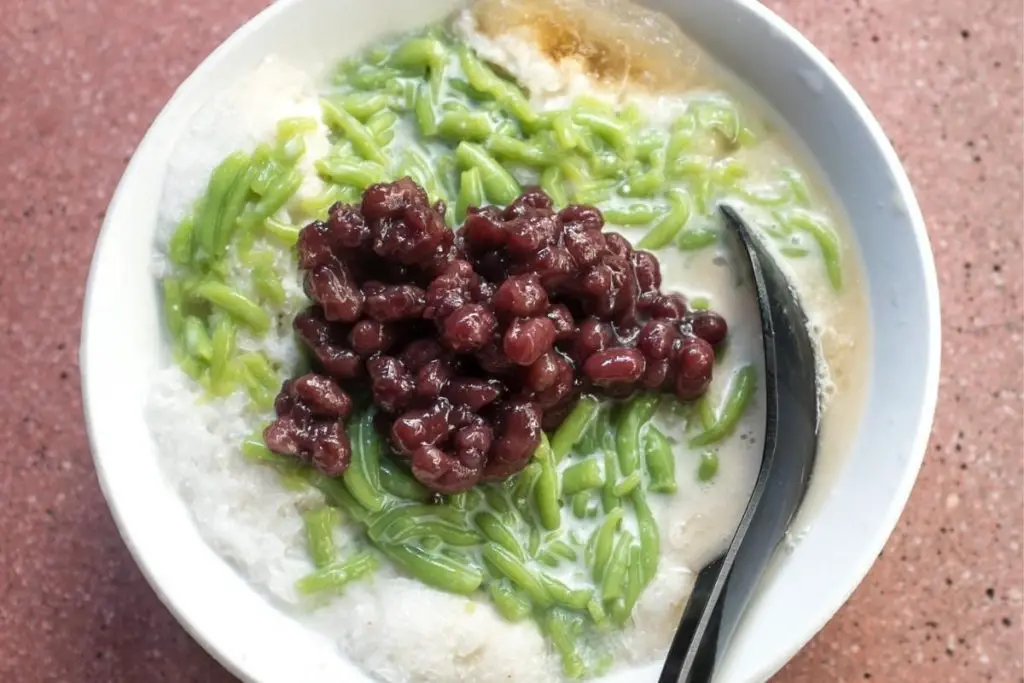
Cendol is one of the best desserts in Malaysia that features a bowl of crushed ice served with coconut milk, green rice flour jelly and palm sugar syrup.
The iced sweet dessert is the perfect treat for the hot weather in Malaysia and is famous in Penang, KL and Selangor.
You can also find cendol that comes with other ingredients like sweet corn, canned longan, vanilla ice cream, grass jelly, and cashew nuts.
It is sometimes served with durian pulps too and is known as cendol durian.
- Eat As: Dessert
- Where to Eat: Roadside stall and food truck, restaurant
- Main Ingredients: Ice, coconut milk, green rice flour jelly, palm sugar syrup
- Cuisine: Southeast Asian
102. Ais Kacang (Shaved Ice with Beans)
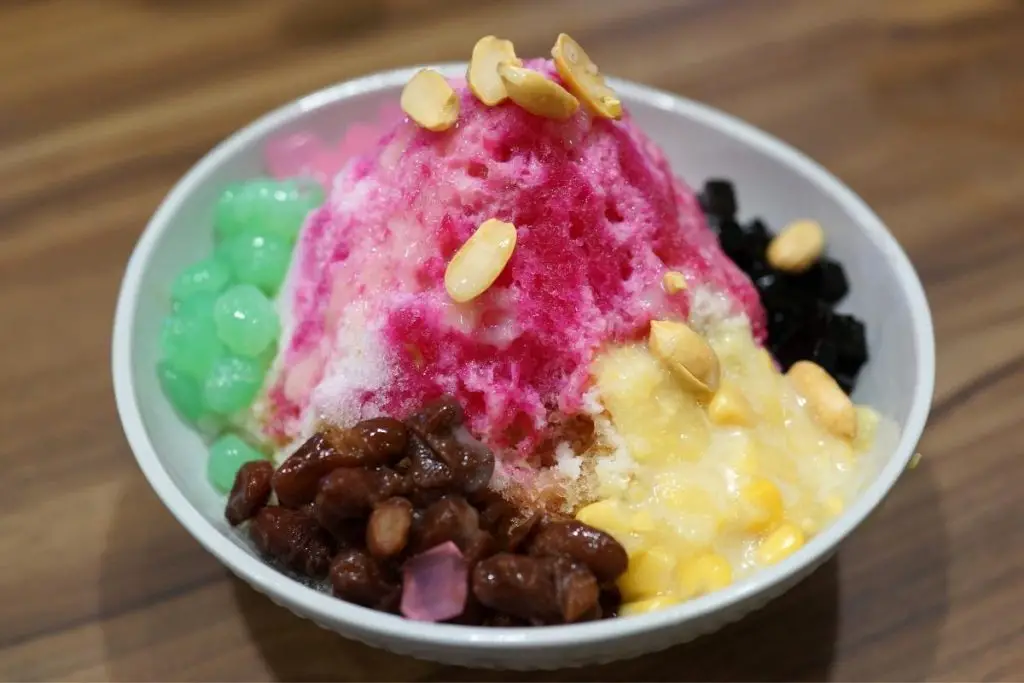
Ais kacang (also known as ABC) is one of the best desserts to eat in Malaysia.
It is made by drenching the bright colour syrups, red beans, grass jelly, cream corn, gula Melaka (Malacca sugar), palm seeds, and condensed milk on the shaved ice mountain served in a bowl.
It’s cold, sweet and delicious, perfect to eat in a tropical country like Malaysia.
- Eat As: Dessert
- Where to Eat: Roadside stall, restaurant
- Main Ingredients: Ice, syrups, red beans, grass jelly, cream corn, gula Melaka (Malacca sugar), palm seeds, condensed milk
- Cuisine: Malay
103. Tau Fu Fa/Douhua (Tofu Pudding)
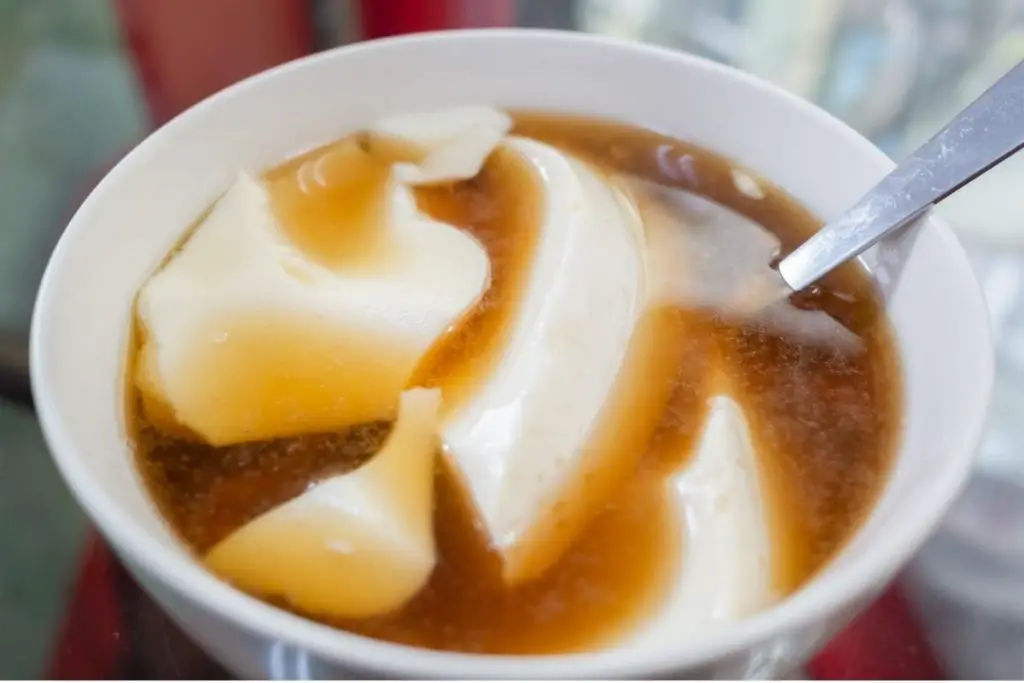
Tau Fu Fa or Douhua is a popular Chinese sweet dessert in Malaysia that is enjoyed by locals.
It is made from soybean and has a silky smooth and soft texture, which is nutritious and delicious. It is best to eat warm.
It comes with two to three choices of sugar syrup (brown sugar, white sugar and ginger), the recommended one is brown sugar syrup.
You can find it at Tau Fu Fa food trucks, night markets, roadside stalls, and restaurants.
Many Tau Fu Fa stalls also sell soy bean milk, and some are homemade, so you may try it out too!
- Eat As: Dessert
- Where to Eat: Tau Fu Fa food truck, night market, roadside stall, restaurants
- Main Ingredients: Soybean/soy milk, sugar, coagulant (gypsum/GLD/Nigari/gelatin), corn starch, water, syrup (brown sugar/ginger)
- Cuisine: Chinese
104. Tong Sui (Chinese Soup Dessert)
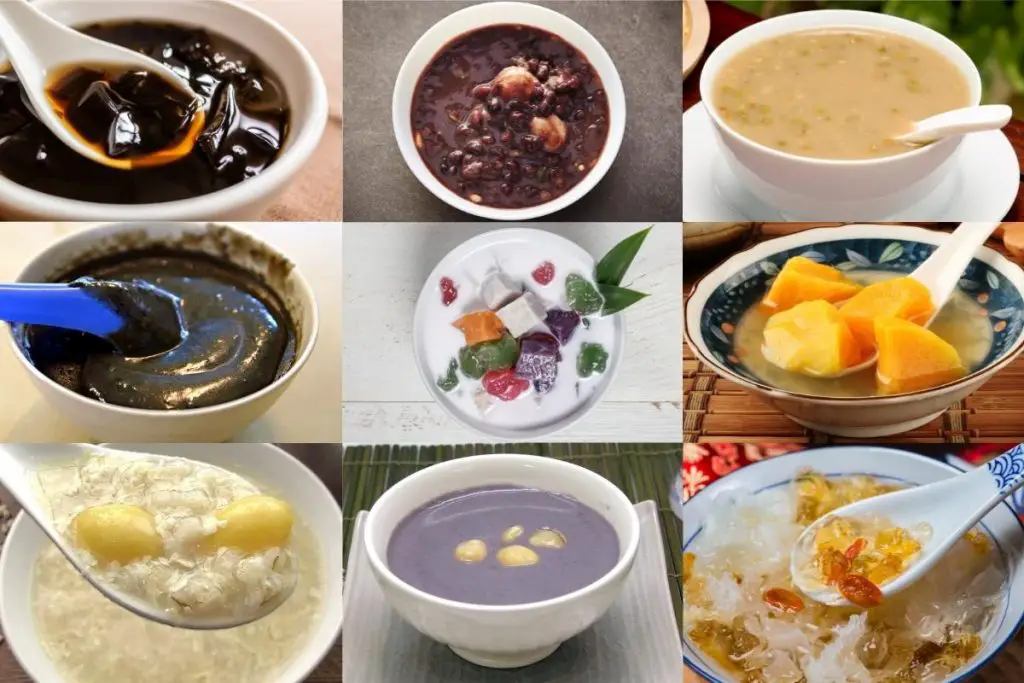
Tong Sui are Chinese sweet soup desserts that come in many varieties and are served warm or cold.
These soup desserts are usually contained milk/coconut milk, fruits, root vegetables, seeds, nuts, tofu, eggs, and beans.
Some of the popular Tong Sui are:
- Fu Chuk Yi Mai (beancurd skin barley ginkgo)
- Bubur Cha Cha (sweet potatoes taro coconut milk)
- Gui Ling Gao (herbal jelly dessert)
- Hak Zi Ma Wu (black sesame soup)
- Taro Soup with Ginkgo
- Sweet Almond Soup
- Water Chestnut Soup with Egg
- Black Glutinous Rice Soup/pulut hitam
- Fah Sang Wu (peanut soup)
- Red Bean Soup
- Sai Mai Lo (honeydew sago)
- Peach Gum With Lychee
- Snow Fungus Dessert Soup
- Lotus Seed Sweet Soup
You can enjoy these desserts at dessert restaurants, roadside stalls, and Chinese night markets.
- Eat As: Dessert
- Where to Eat: Restaurant, roadside stall, food trucks, night market
- Main Ingredients: Milk/coconut milk, fruits, root vegetables, seeds, nuts, tofu, egg, beans
- Cuisine: Chinese
Malaysian Breakfast Foods: Best Malaysian Foods
105. Dim Sum
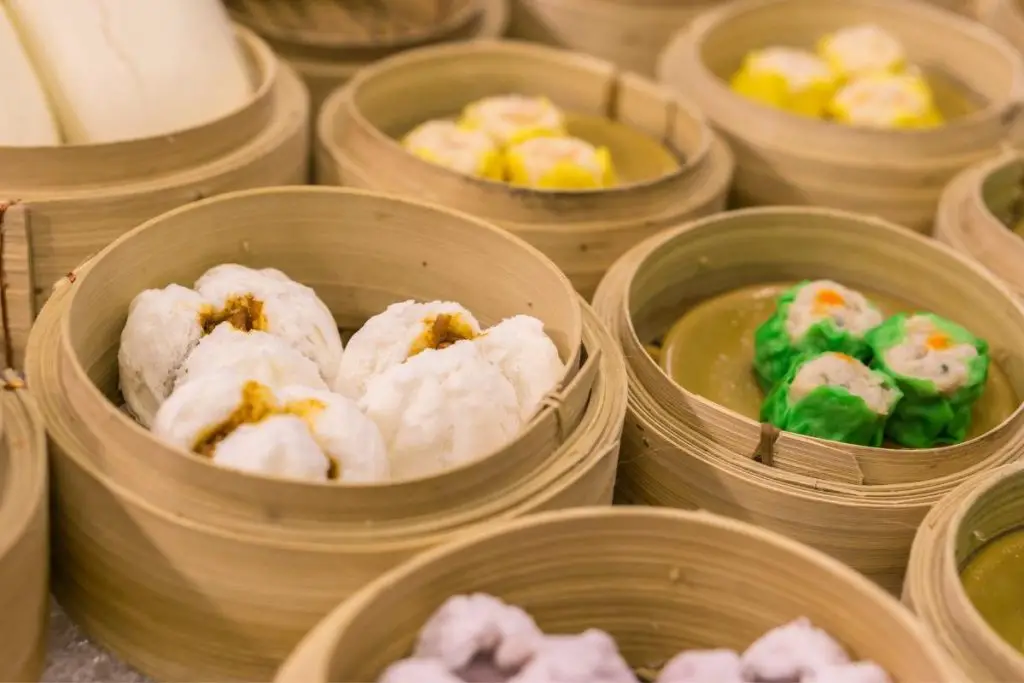
Dim Sum consists of a large variety of small Chinese dishes and is famous among the Chinese in Malaysia.
Dim Sum dishes are mostly made with pork (chicken if it is halal dim sum), mackerel fish meat, surimi, and prawn, and are served steamed or fried.
Some of the delicious and popular Dim Sums are Siu Mai (pork/chicken and prawn dumpling), Har Gao (prawn dumpling), fried prawn roll with salad sauce, char siew bao, creamy custard bun, braised chicken feet, Shanghai Xiao Long Bao (Chinese soup dumplings), fried yam balls, and many more!
It is often enjoyed as breakfast or brunch so most of the Dim Sum restaurants are only open until 2 or 3 pm, but there are also Dim Sum restaurants that open until night.
You can enjoy Dim Sum at Dim Sum restaurants and stalls. There are also Halal Dim Sum restaurants for Muslims.
In Kuching, Sarawak, there is a popular Dim Sum dish called Sio Bee, which is similar to Siu Mai but made with 100% pork instead.
- Eat As: Main meal, snack
- Where to Eat: Dim Sum restaurant, hawker centre, food court, roadside stall
- Main Ingredients: Pork, shrimp, fish
- Cuisine: Chinese
106. Roti Bakar/Kaya Toast (Coconut Jam Toast)
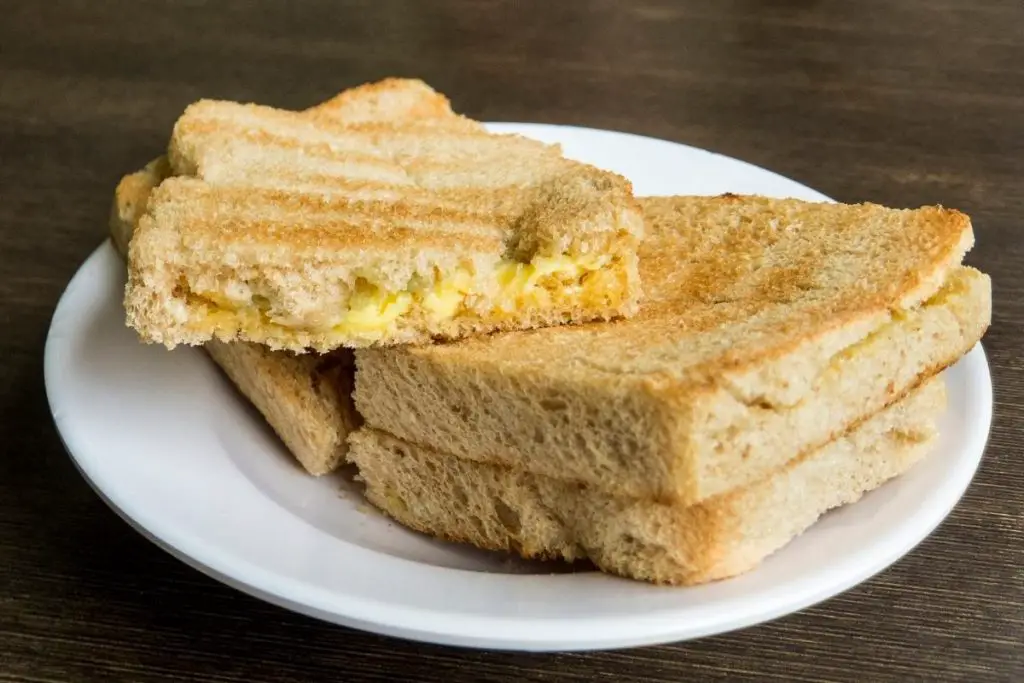
Roti Bakar or kaya toast is one of the popular breakfasts in Malaysia.
It is made by spreading the kaya and butter on two slices of toast, simple and delicious.
Kaya is a sweet and aromatic coconut jam and is best to eat with toast or bread.
Kaya toast is often served alongside soft-boiled eggs and hot coffee.
To best enjoy the soft-boiled eggs, put some soy sauce and pepper on them and stir evenly to make the eggs more flavourful.
You can also dip the crunchy kaya toast into the seasoned soft-boiled eggs for extra deliciousness.
You can find roti bakar or kaya toast in hawker centres, cafés and restaurants.
- Eat As: Snack, main meal
- Where to Eat: Hawker centres, café, and restaurant
- Main Ingredients: Bread, kaya (coconut jam), butter
- Cuisine: Southeast Asian
107. Chai Tow Kway (Fried Radish Cake)
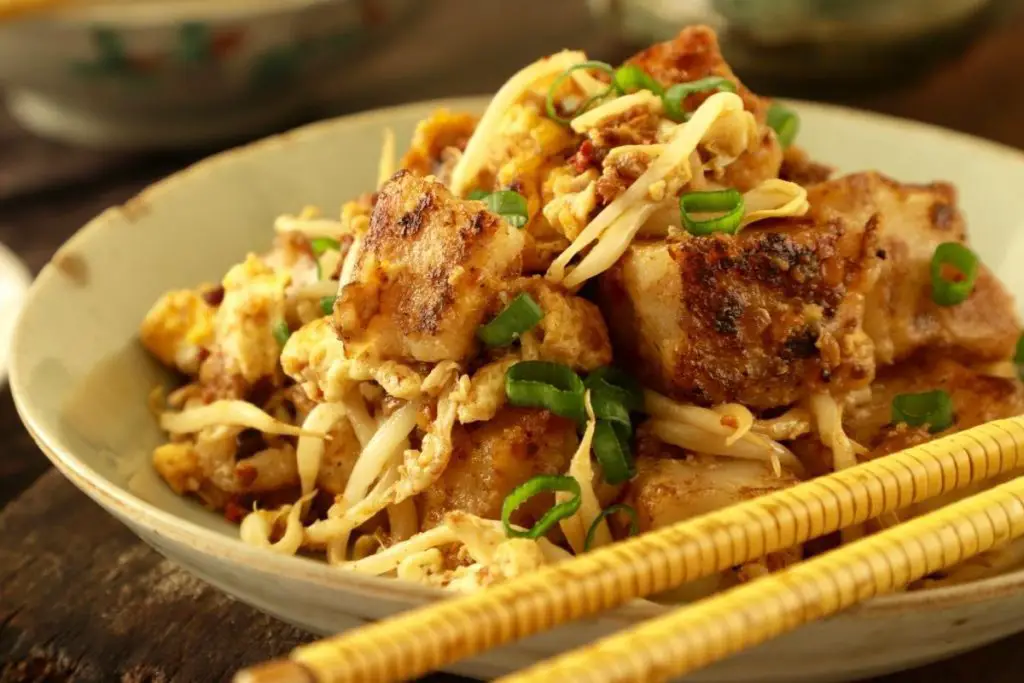
Chai tow kway is a popular dish and dim sum in Malaysia.
It is made by stir-frying the cubes of radish cake, eggs, garlic, spring onion, soy sauce, fish sauce, and dark soy sauce.
It comes in two versions, white and black, the black one is with dark soy sauce and the white one is without.
You can find this food in hawker centres, Dim Sum restaurants, and Chinese night markets.
- Eat As: Main meal, snack
- Where to Eat: Hawker centre, Dim Sum restaurant, Chinese night market
- Main Ingredients: Radish, rice flour, salt, eggs. garlic, fish sauce, spring onion, soy sauce, dark soy sauce
- Cuisine: Chinese
Festival Foods in Malaysia: Best Malaysian Foods
108. Hokkien Bak Chang/ Zongzi (Chinese Glutinous Rice Meat Dumpling)
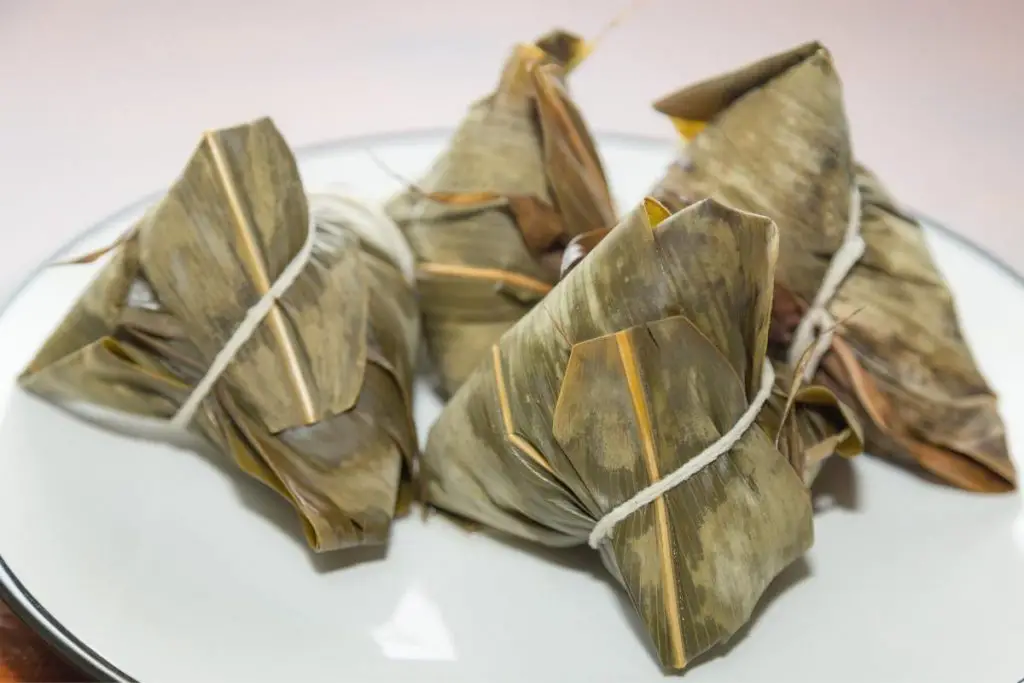
Bak Chang is a Chinese glutinous rice meat dumpling that is usually eaten during Dragon Boat Festival, but you can also find it on normal days.
It consists of glutinous rice, pork belly, salted egg yolks, shiitake mushroom, black-eyed pea, dried shrimps, spices, and dark soy sauce wrapped in large banana leaves.
You can find it in some hawker centres and Chinese morning markets.
- Eat As: Main meal, snack
- Where to Eat: Hawker centre, Chinese morning market
- Main Ingredients: Glutinous rice, pork, salted egg yolks, shiitake mushroom, black-eyed pea, dried shrimps, spices, dark soy sauce
- Cuisine: Chinese
109. Ketupat (Rice Cake)
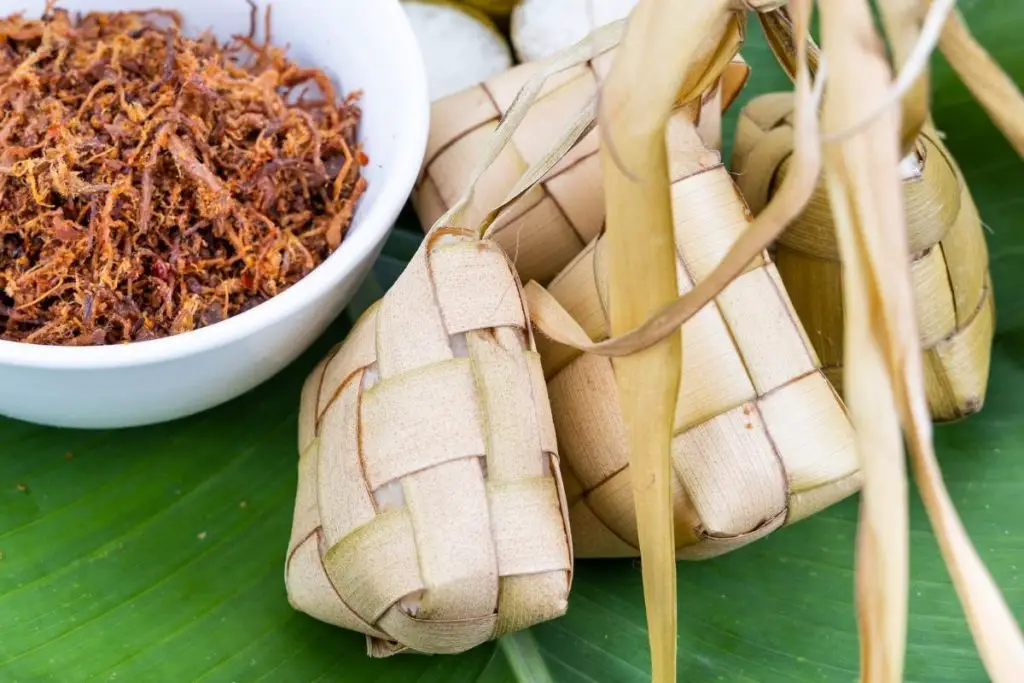
Ketupat is one of the favourite festival foods of Malays. It is rice cooked inside a pouch made of woven palm leaves. Some Ketupats also use coconut leaves or palas leaves.
It comes with different versions, such as Ketupat nasi, Ketupat bawang, Ketupat palas, Ketupat pulut, Ketupat borneo, and Ketupat sotong, but the common one is Ketupat nasi.
Some Ketupats like Ketupat palas and Ketupat pulut uses glutinous rice instead of rice.
It is usually enjoyed with rendang or curry meat (beef or chicken) in addition to serunding (meat floss), a side dish to accompany rice. Some people also enjoyed Ketupat with condensed milk.
- Eat As: Main meal, side dish
- Where to Eat: Hawker centre, roadside stall, night market
- Main Ingredients: Glutinous rice/rice
- Cuisine: Southeast Asian
110. Jiu Hu Char (Stir-fried Yam Bean/Jicama with Shredded Cuttlefish)
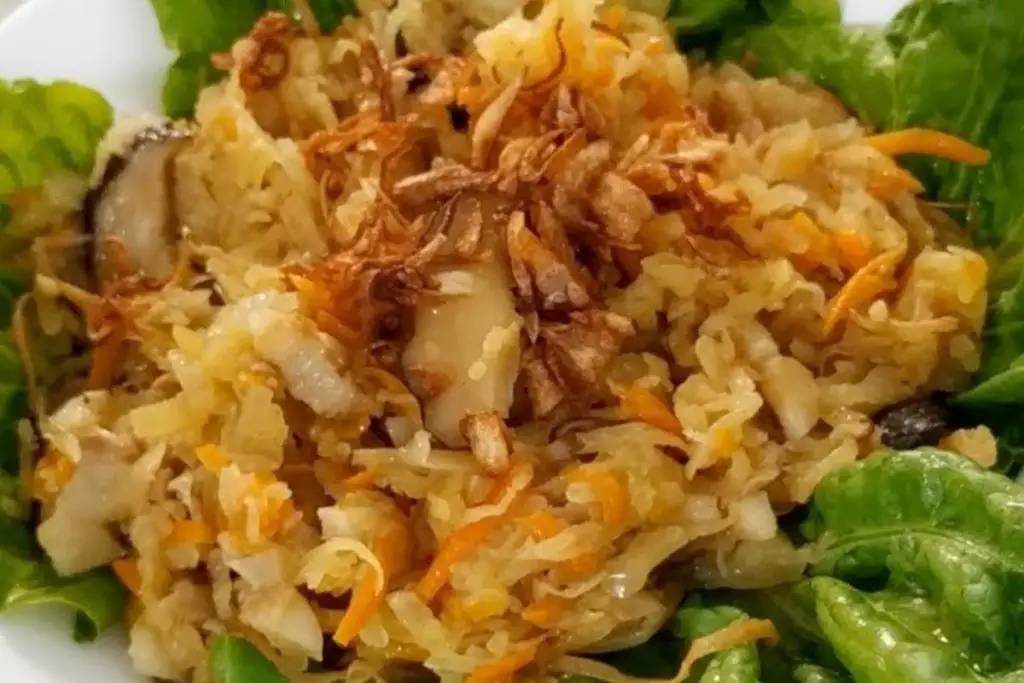
Jiu hu char, a Nyonya salad, is one of the common festival dishes for Chinese festivals like Chinese New Year and Qingming.
It is made of shredded stir-fried carrots, yam bean/jicama, cuttlefish, mushrooms, cabbage, onions, and pork.
- Eat As: Main meal (as a side dish), snack
- Where to Eat: Restaurant
- Main Ingredients: Jicama/yam bean, carrot, cuttlefish, mushroom, cabbage, onion, pork
- Cuisine: Nyonya
111. Hinava/Hinava Ginapan (Sabah Raw Fish Salad)
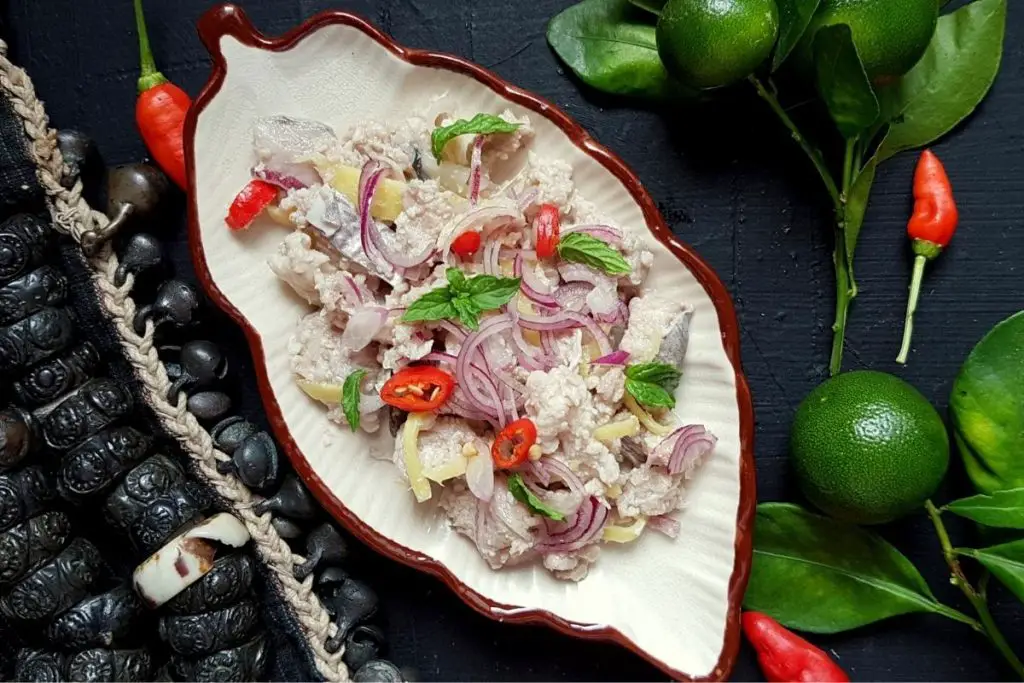
Hinava is the most popular traditional Kadazan-Dusun dish from Sabah which consists of raw fish with lime juice.
The dish (Hinava tongii) is made by marinating fresh fish fillets (usually mackerel fillets) with lime juice, red chillies, grated bambangan fruit seeds, shallots, ginger and salt.
It is also a festival dish for festivals and special occasions like Tadau Kaamatan and weddings.
- Eat As: Main meal
- Where to Eat: Restaurant, hawker centre, roadside stall
- Main Ingredients: Fish, lime juice, red chilli, bambangan fruit seeds, shallot, ginger, salt
- Cuisine: Borneo
Best Beverages to Drink in Malaysia
1. Teh Tarik (Malaysia Milk Tea)
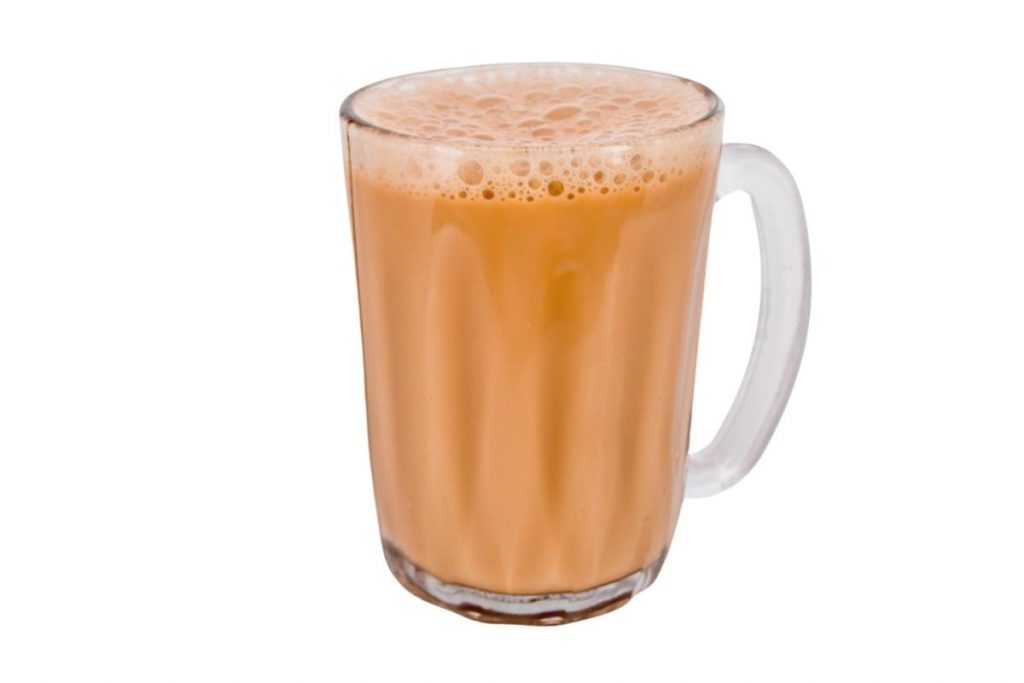
Teh Tarik is a Malaysian milk tea and is one of the most popular beverages in Malaysia.
Teh in Malay word means “tea” and Tarik means “pulled”, as the drink is made by pouring the milk tea between 2 vessels at a distance repeatedly to aerate the drink and improve its flavour.
The milk tea is made with black tea and condensed milk.
You can find Teh Tarik in Mamak, restaurants and hawker centres.
2. Milo (Chocolate-flavoured Malt Drink)
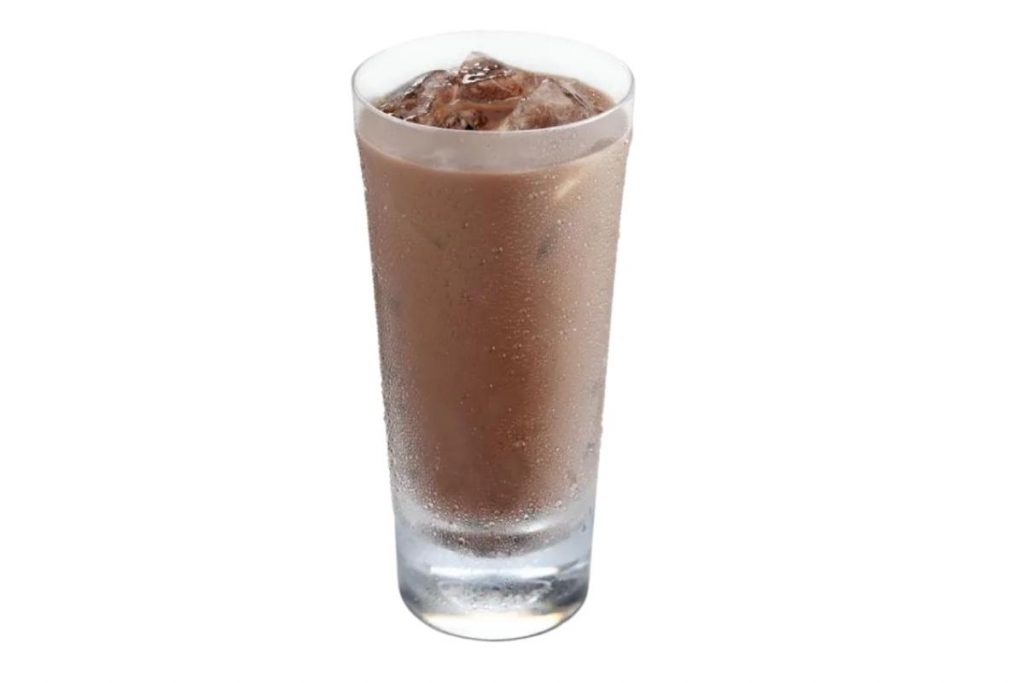
Milo is a popular drink in Malaysia that is enjoyed by locals, especially kids, teenagers and young adults.
You can find the drink at hawker centres, food courts, restaurants, and roadside drink stalls.
The Milo powder pack is also available in groceries marts, supermarkets and hypermarkets.
3. Ipoh White Coffee
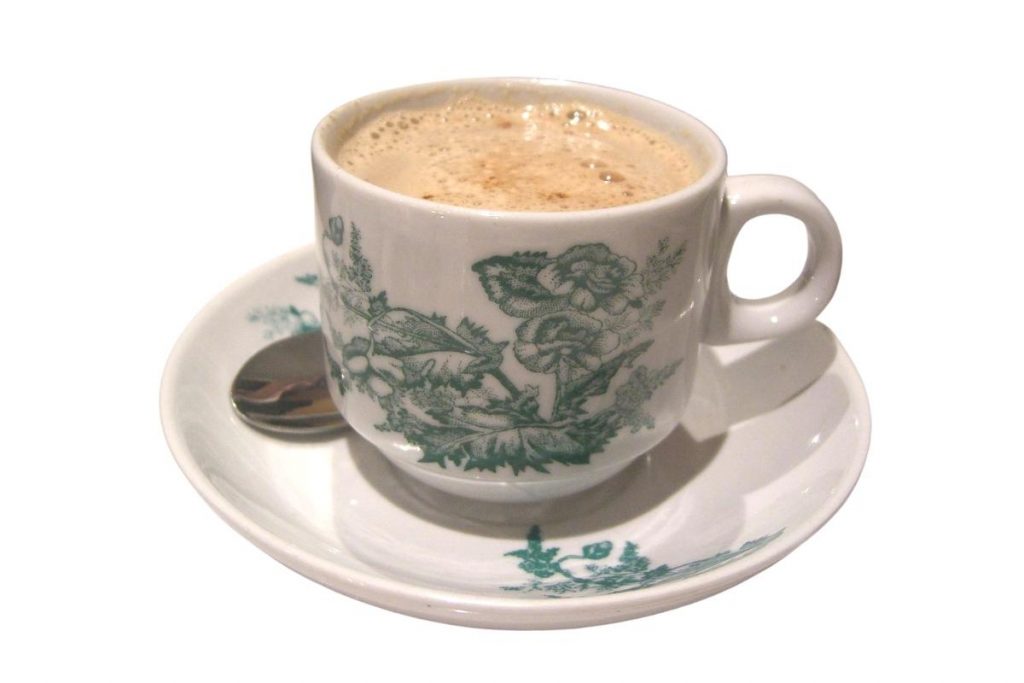
Ipoh white coffee is a famous coffee drink from Ipoh, Perak, Malaysia. It is also known as the best coffee in Ipoh.
The aromatic coffee is made from coffee beans roasted with palm oil margarine and served with condensed milk.
You can find Ipoh white coffee at restaurants, hawker centres, cafés, and Old Town White Coffee restaurants across Malaysia.
4. Air Kelapa (Coconut Water)
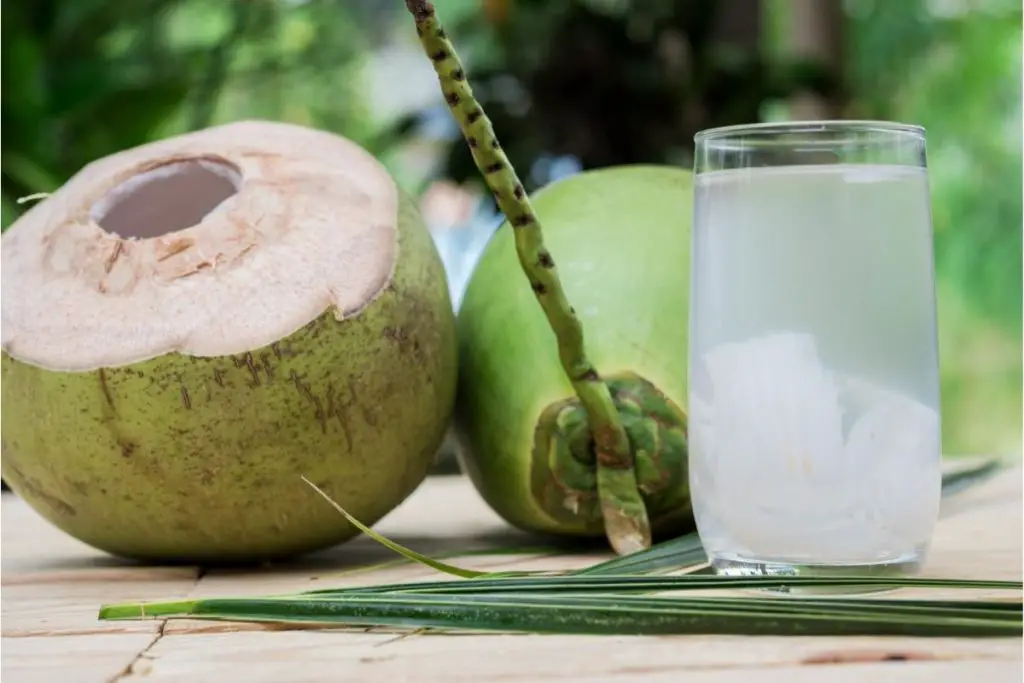
Air Kelapa is a popular drink in Malaysia that can be found at roadside stalls, hawker centres, food courts, and restaurants.
It is a perfect drink for hot weather in Malaysia.
Coconut water not only quenches thirst but is also nutritious and good for the body.
5. Ambra/Ambarella Juice with Sour Plum (Kedondong Asam Boi)
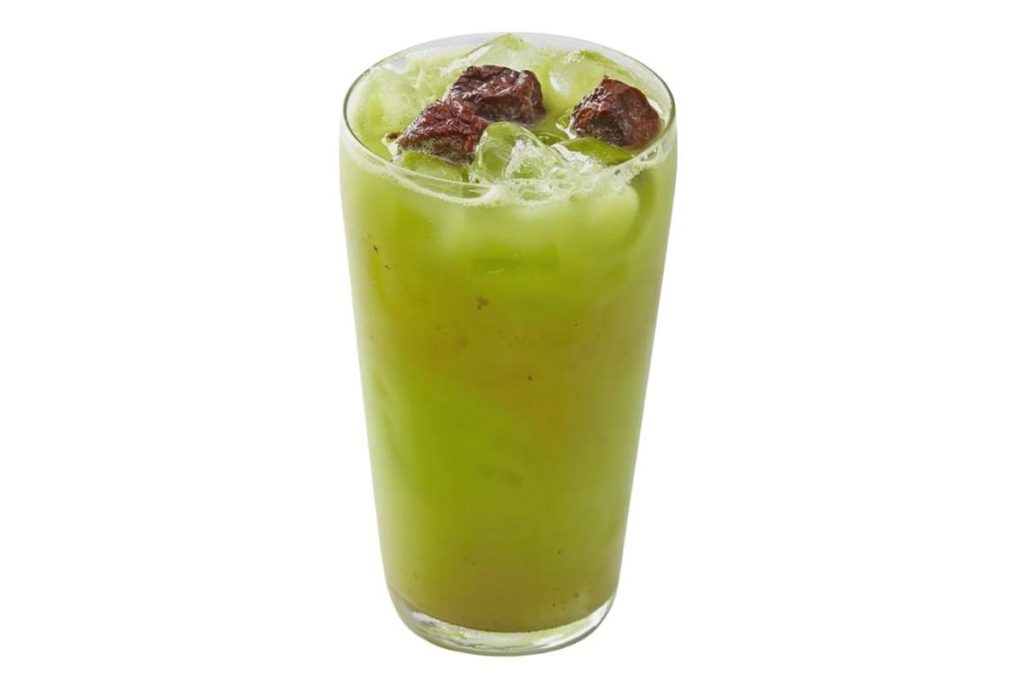
The ambarella juice with sour plum is made by extracting the juice from ambarella fruits (buah kedondong) and mix with sour plum and ice cubes.
It is refreshing and delicious!
There are also other versions that use limau (lime) juice or green apple juice instead of kedondong.
You can find the drink in hawker centres, food courts and restaurants.
6. Air Tebu (Sugar Cane Juice)
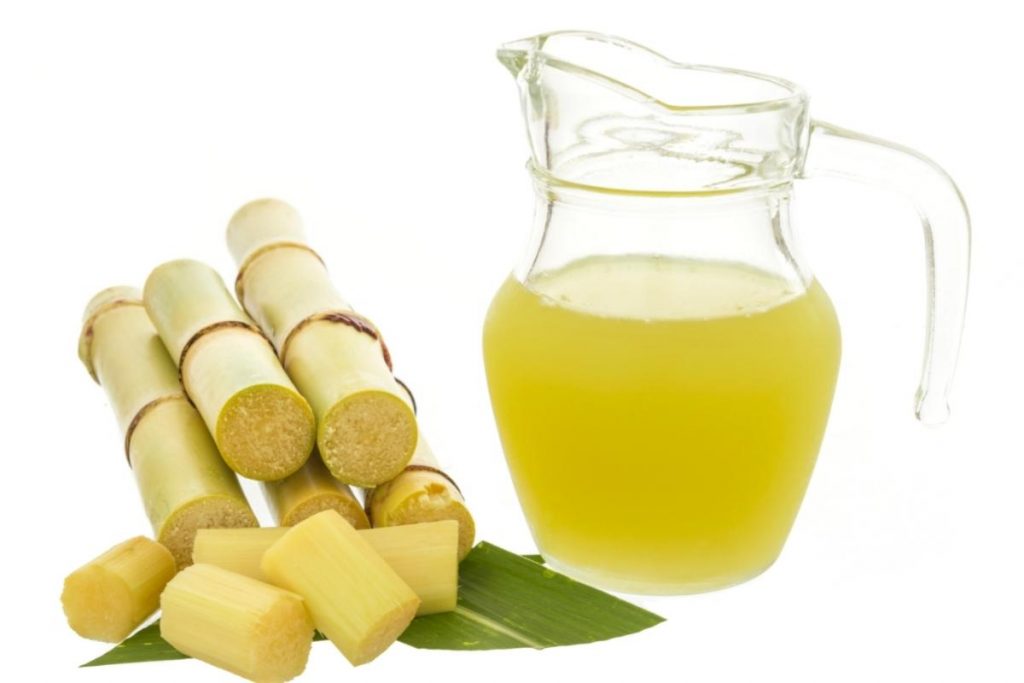
The sugar cane water is extracted by squishing the sugar cane stalks in a grinder. It is healthy, natural and tasty.
The drink is usually served in a plastic bag, bottle or cup.
You can find it on roadside stalls, restaurants and night markets.
7. Teh ‘O’ Ais Limau (Iced Tea with Lime)
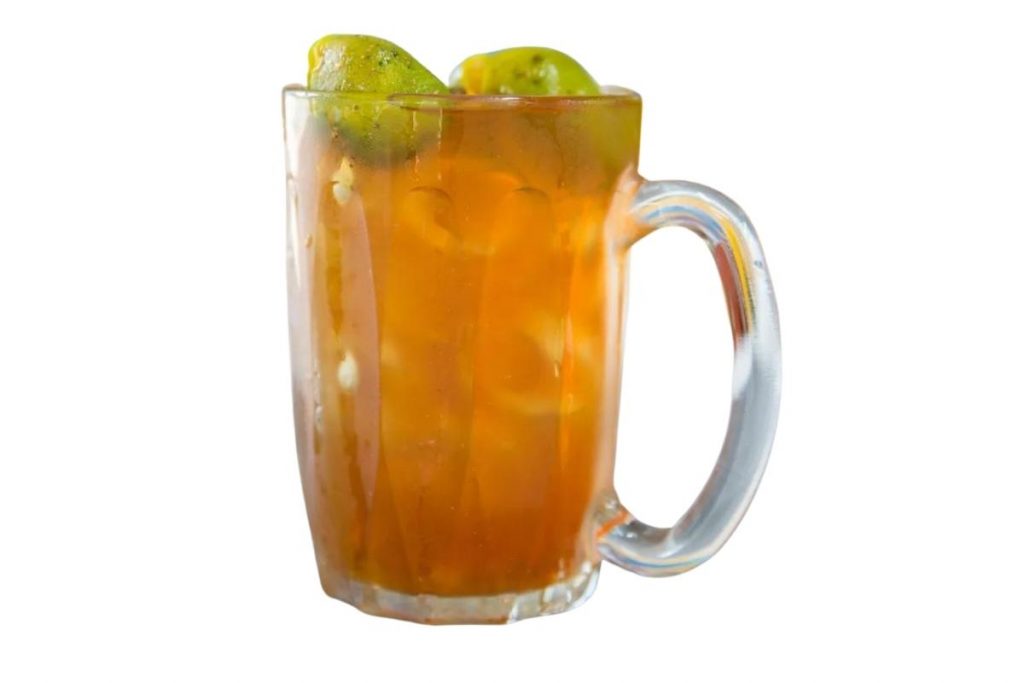
Teh ‘O’ Ais Limau is a popular drink in Malaysia that is commonly served in Mamak, roadside stalls and restaurants.
It is a drink mix of BOH Tea (a famous tea brand in Malaysia) and lime juice.
Best Tropical Fruits to Eat in Malaysia: Best Malaysian Food
Malaysia is a country with a tropical climate and a lot of rainfall throughout the year, a perfect environment for tropical fruits.
If you are looking for fruits in Malaysia, here are some of the uncommon tropical fruits to try when you are in Malaysia:
1. Durian (King of the Fruits in Malaysia)
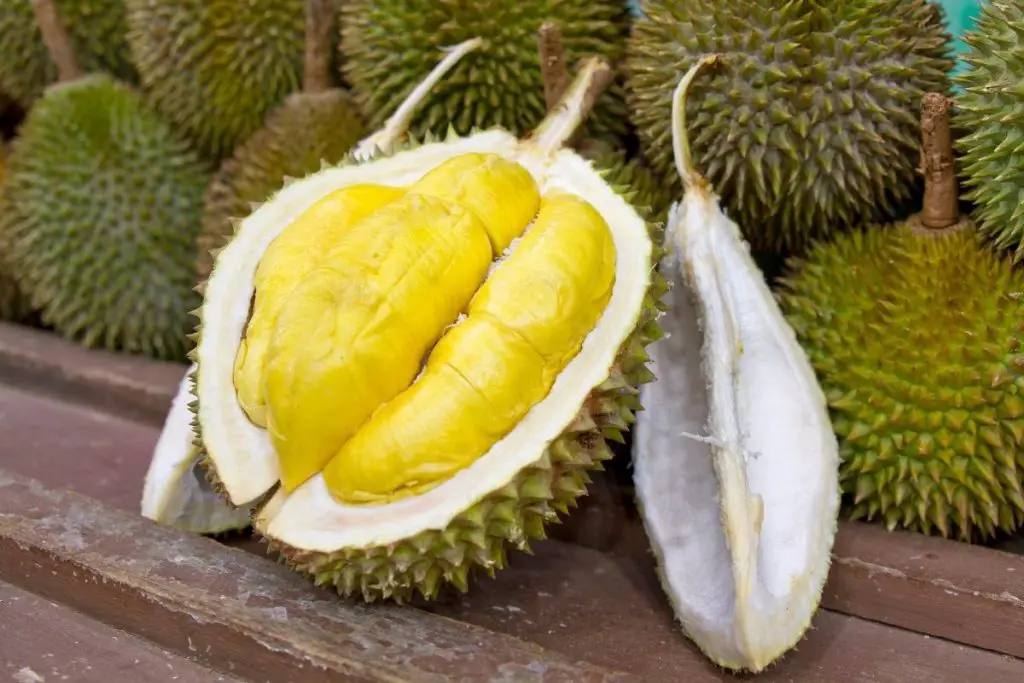
Durian is known as the king of fruits in Malaysia due to its distinct smell, taste, pulps, and tough thorny shell.
None other fruits can make people queue up to buy or gather to eat like durian does, despite it being the most expensive local fruit.
While not everyone can accept its strong and distinct smell and taste, it is definitely one of the best foods to try in Malaysia.
The durian pulps have a creamy texture, and depending on the breed, they can be sweet, bitter, or sweet but with a bitter aftertaste.
Once you finish eating, you may wash your hand with water and rub your fingers along the grooves in the durian husk to reduce the durian smell on your fingers.
Some of the best varieties of durian are Musang King/D197, D24, Tekka/D160, IOI/D168/D101, Red Prawn, XO, and Black Thorns/D200 (rare and expensive).
The durian season is between June and August to October, and the peak season differs depending on weather and states.
- Taste: Bittersweet, sweet, or bitter depending on the type of durian
- Flesh: Creamy and custardy, yellow or light-yellow colour, strong fragrance
- Rind: Green colour, thorny and hard
- Season: June to August, August to October
2. Mangosteen
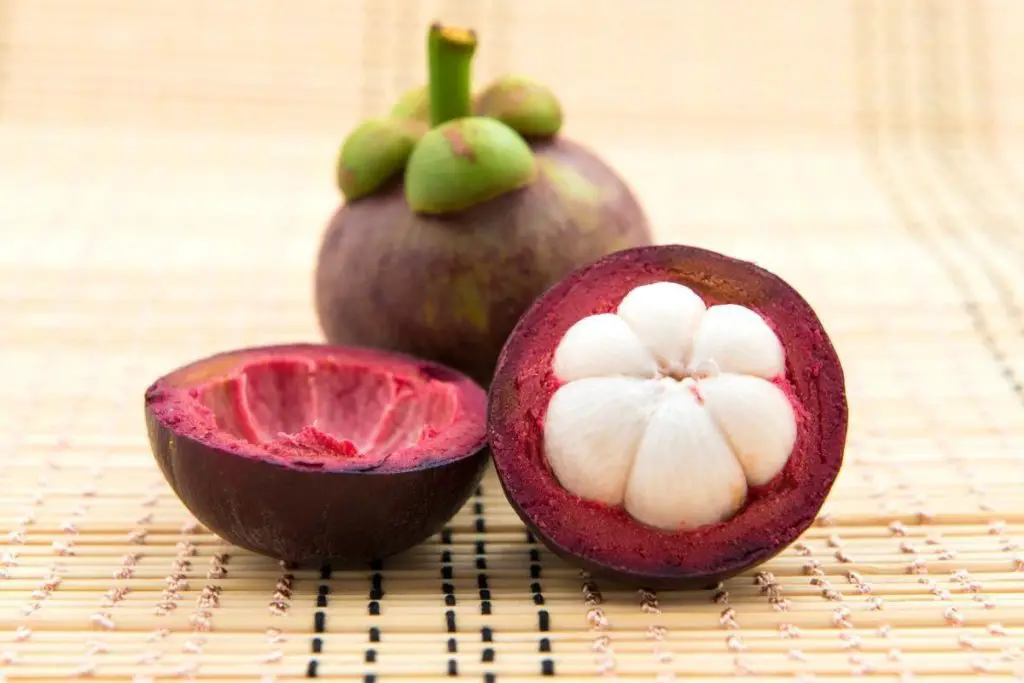
Also known as the queen of the fruits as it goes well with durian, the king of fruits.
It has a purple colour thick rind and sweet white flesh. The seed is edible but could be bitter, most people don’t eat it.
- Taste: Very sweet
- Flesh: Segmented white colour, soft, juicy, with a bitter edible seed
- Rind: Purple colour, thick, Inedible
- Season: June to August
3. Rambutan
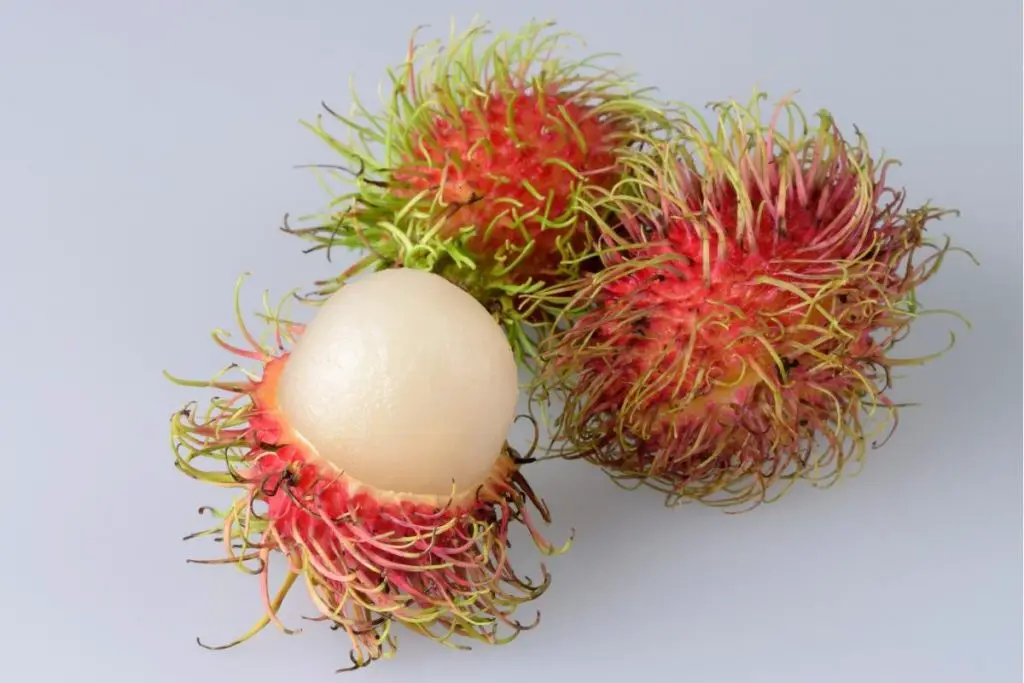
Rambutan has a round red colour hairy outer skin and white flesh with a seed. “Rambut” in Malay means “hair”.
To eat, just squeeze the fruit with your thumb and the white colour flesh will pop out.
- Taste: Sweet
- Flesh: White colour flesh with seed
- Rind: Red colour, hairy, inedible
- Season: June to August or May to December
4. Papaya
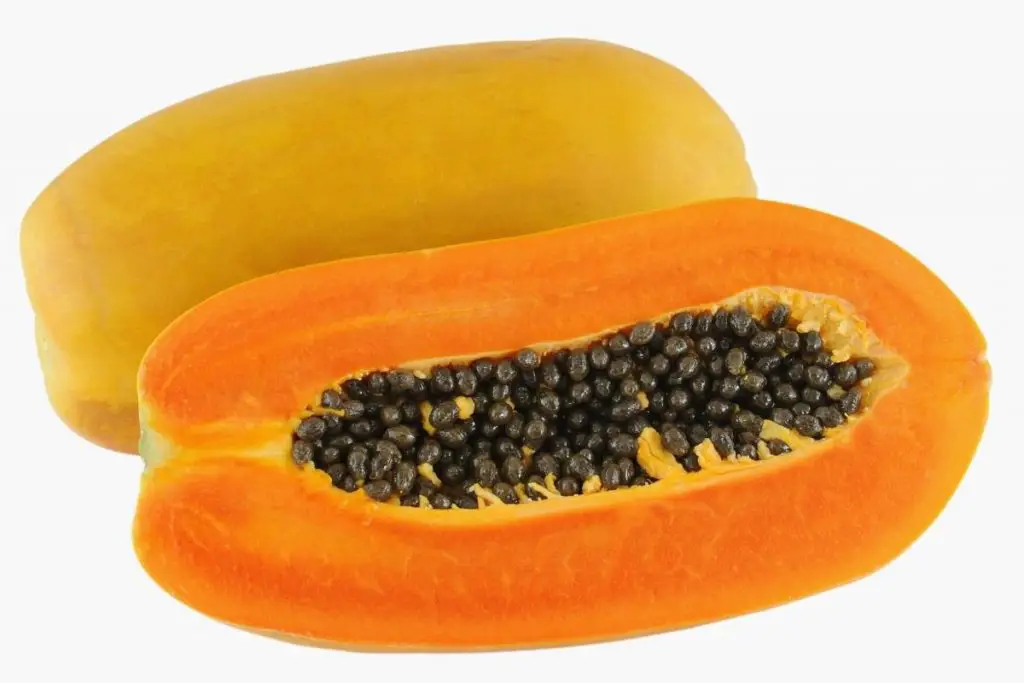
Papaya is a succulent fruit that contains a large amount of small and black-colour seeds.
- Taste: Sweet
- Flesh: Orange colour, soft and juicy
- Rind/Skin: Oval shape, green or yellow colour, inedible
- Season: All year round
5. Longan (Mata Kucing)
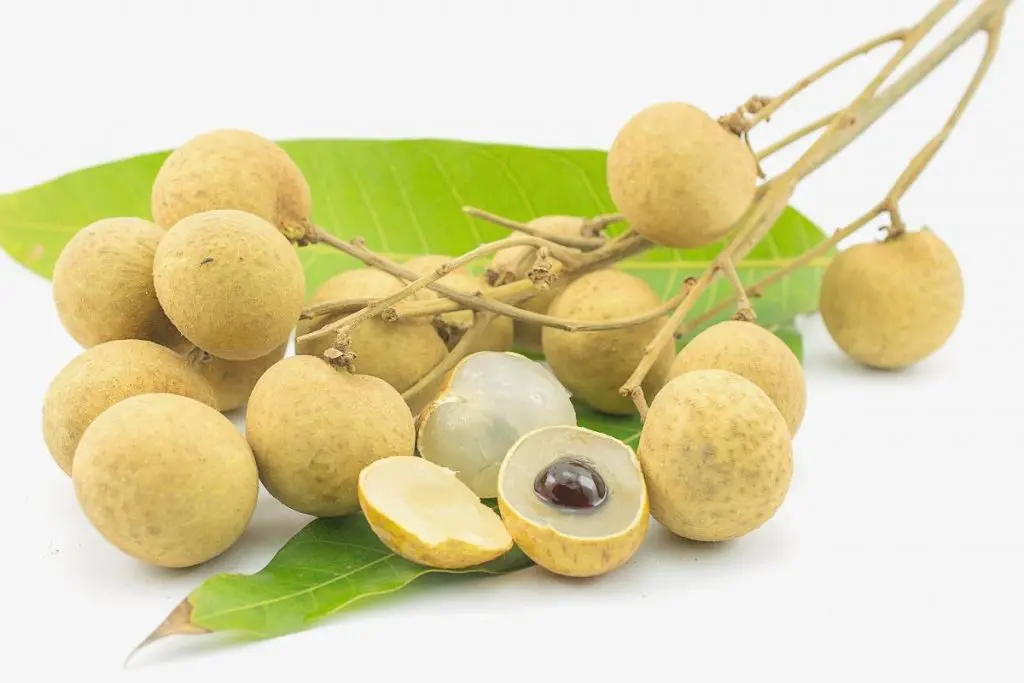
Longan is also known as Mata Kucing (eyes of the cat) due to the black colour round seed that looks like the eye of the cat.
- Taste: Sweet
- Flesh: White colour, round shape, juicy
- Skin: Brown colour, thin, inedible
- Season: July to August
6. Nangka (Jackfruit)
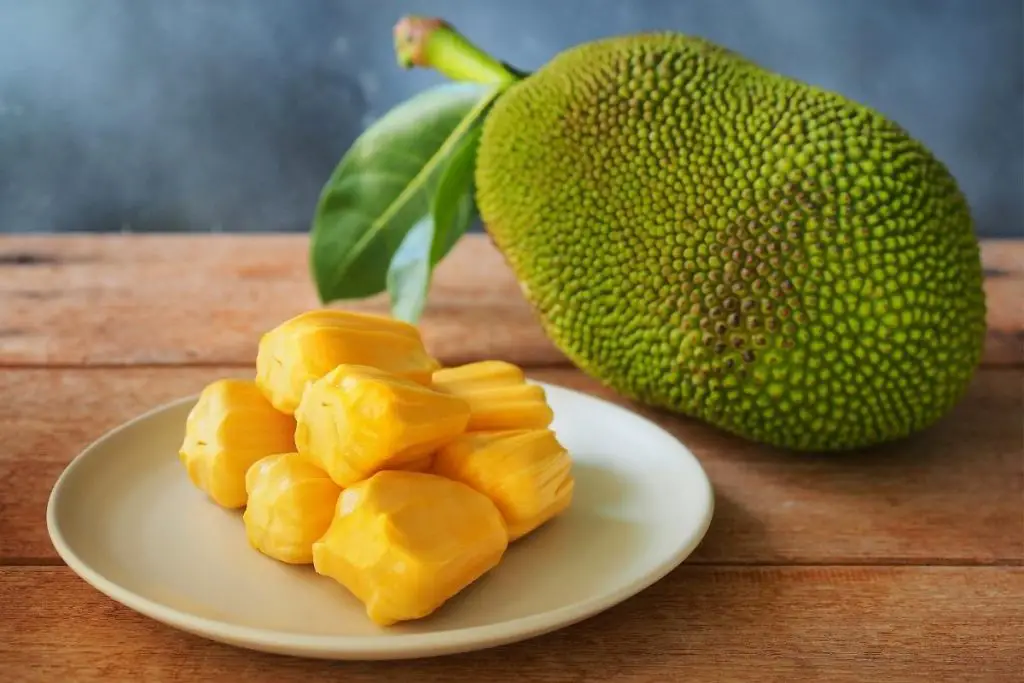
- Taste: Sweet
- Flesh: Golden or yellow colour, solid, juicy, fragrance, with seed (edible when boiled)
- Rind: Large, green-yellow, hard and thick, inedible
- Season: All year round
7. Langsat
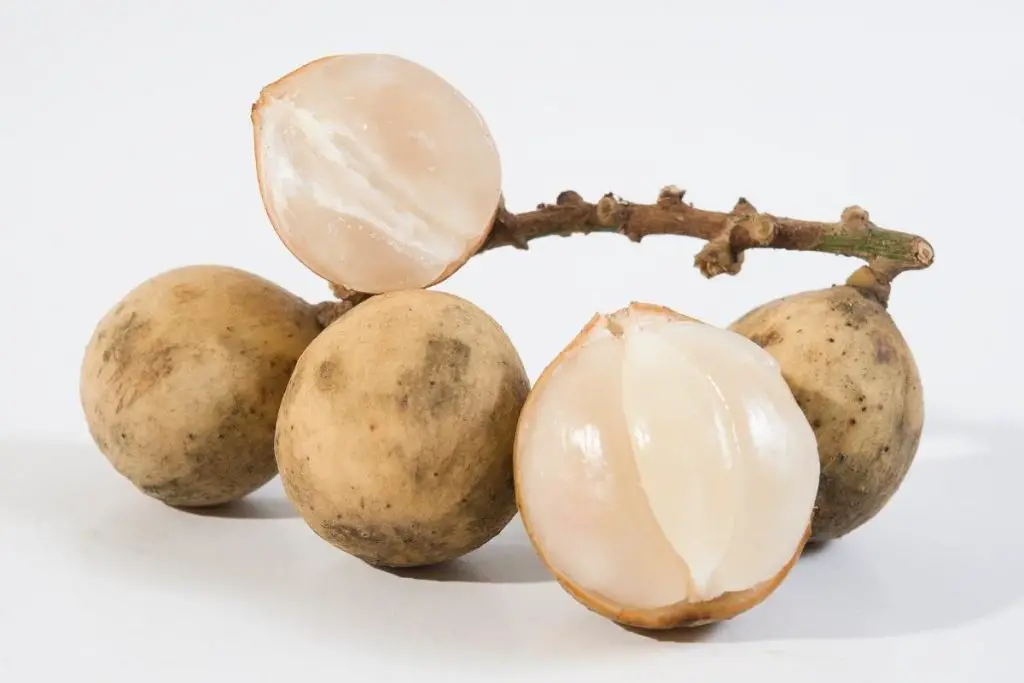
Langsat is a seasonal fruit in Malaysia with a sweet and sour taste. To eat, just pinch the skin with your thumb until the white flesh pops up and then remove the skin.
- Taste: Sweet and sour
- Flesh: Near translucent white flesh with a seed
- Skin: Brown colour, inedible
- Season: June to August
8. Pomelo
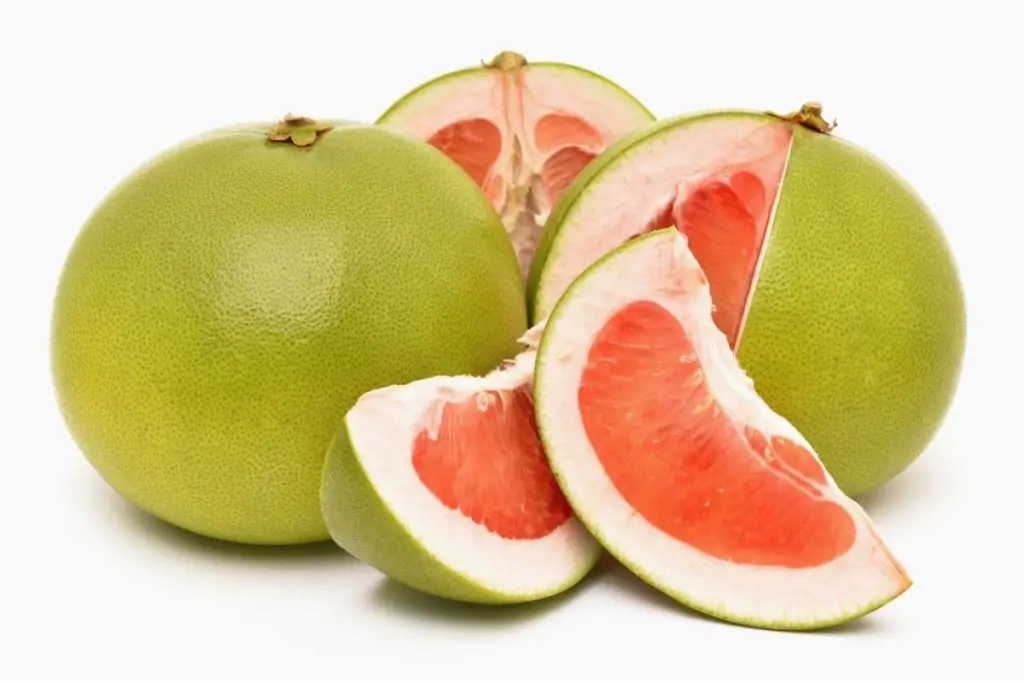
- Taste: Sweet and mild
- Flesh: Light-orange or red, juicy
- Rind: Green-yellow colour, thick, inedible
- Season: All year round
9. Starfruit
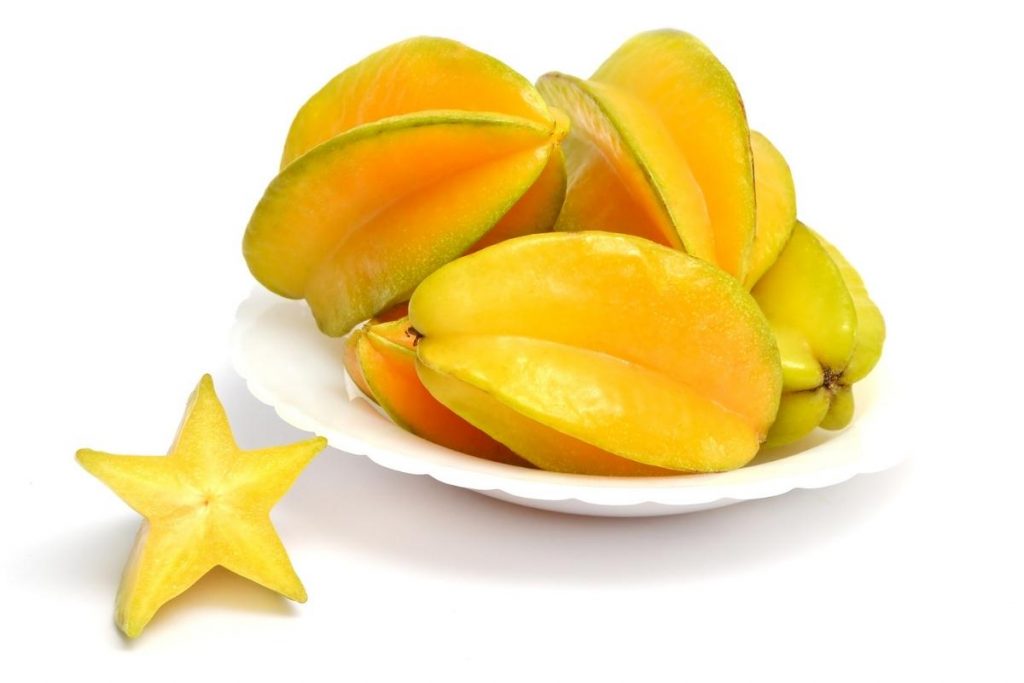
Starfruit is a juicy fruit in Malaysia with a star-shaped exterior. It is often eaten with sour plum and salt for an extra flavour.
- Taste: Sweet or a little bit sour
- Flesh: Light green, juicy, crisp
- Skin: Light green or yellow, waxy, edible
- Season: April to June, October to December
10. Jambu Air (Water Apple/Rose Apple/Bell Fruit)
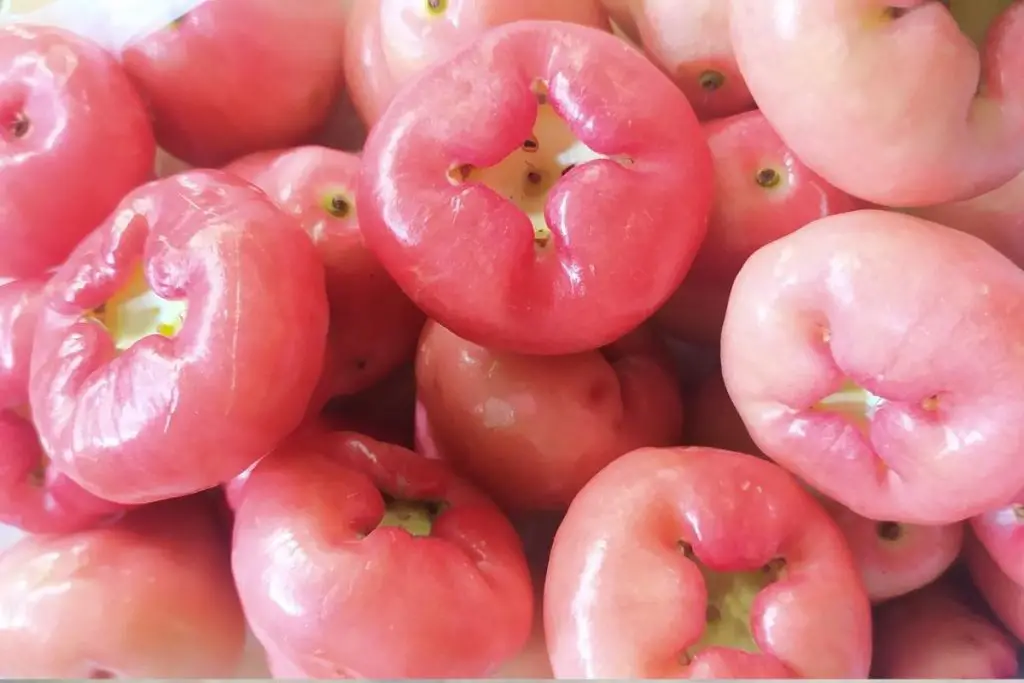
- Taste: Sweet
- Flesh: White, juicy, crunchy
- Skin: Pink colour, waxy, thin, edible
- Season: May to September and November to March
11. Ciku (Sapodilla Fruit)
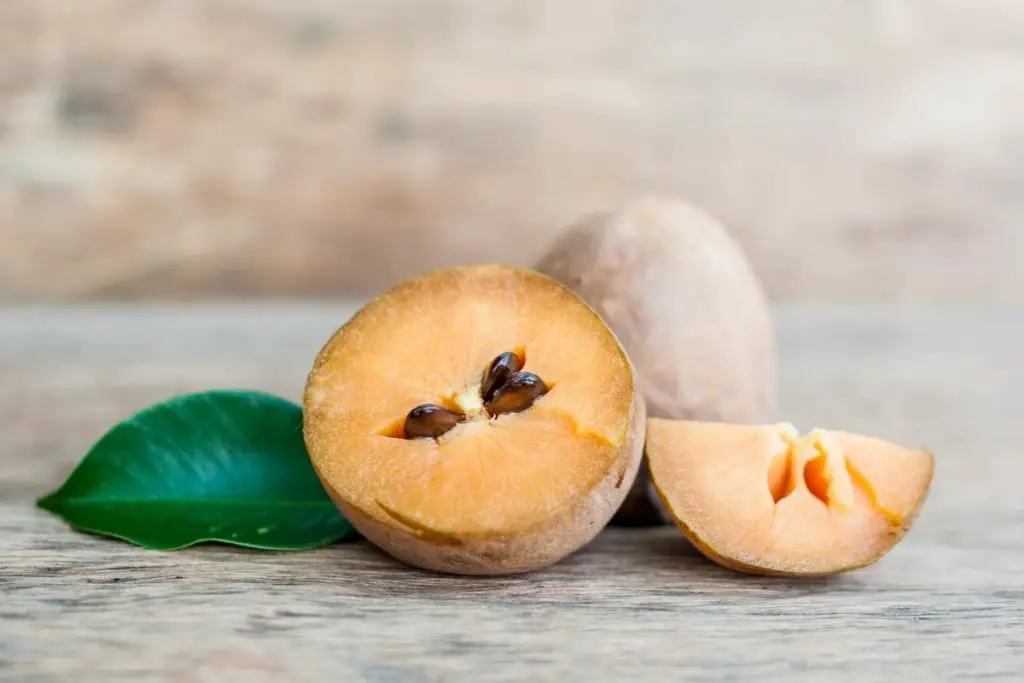
- Taste: Very sweet, honey-like
- Flesh: Brown-orange, juicy, soft and pulpy, with black colour seed
- Skin: Brown colour, thin, inedible
- Season: March and November
12. Cempedak
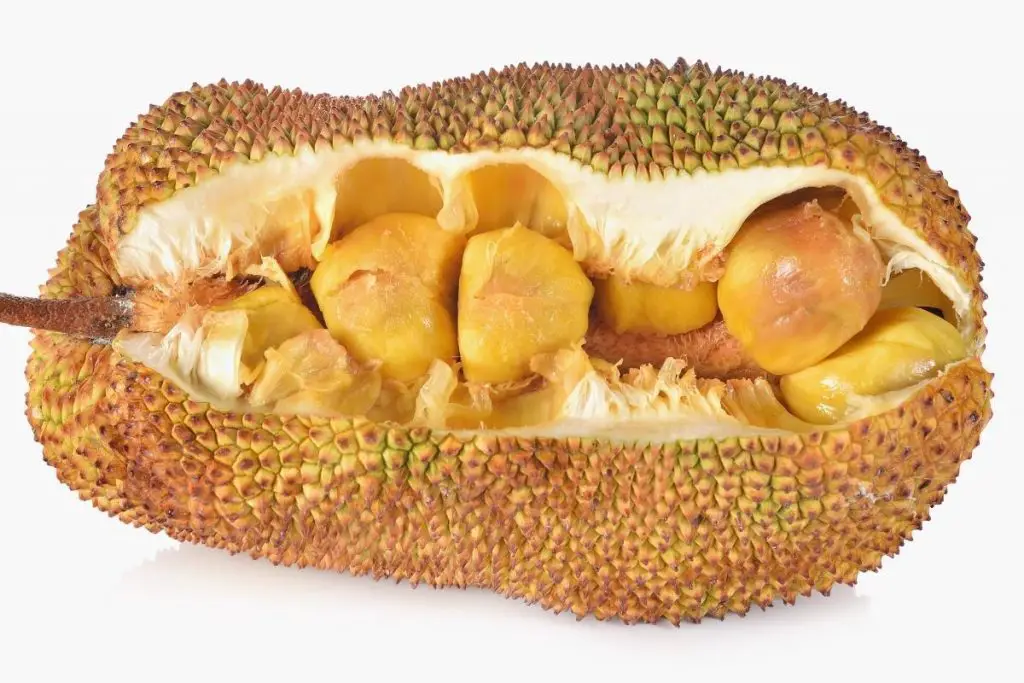
Cempedak is similar to Nangka (jackfruit) but smaller, usually fried and eaten as a snack.
- Taste: Sweet
- Flesh: Golden yellow, waxy, strong fragrance
- Rind: Green, thick, inedible
- Season: May to July, November and February
13. Salak (Snake Fruit)
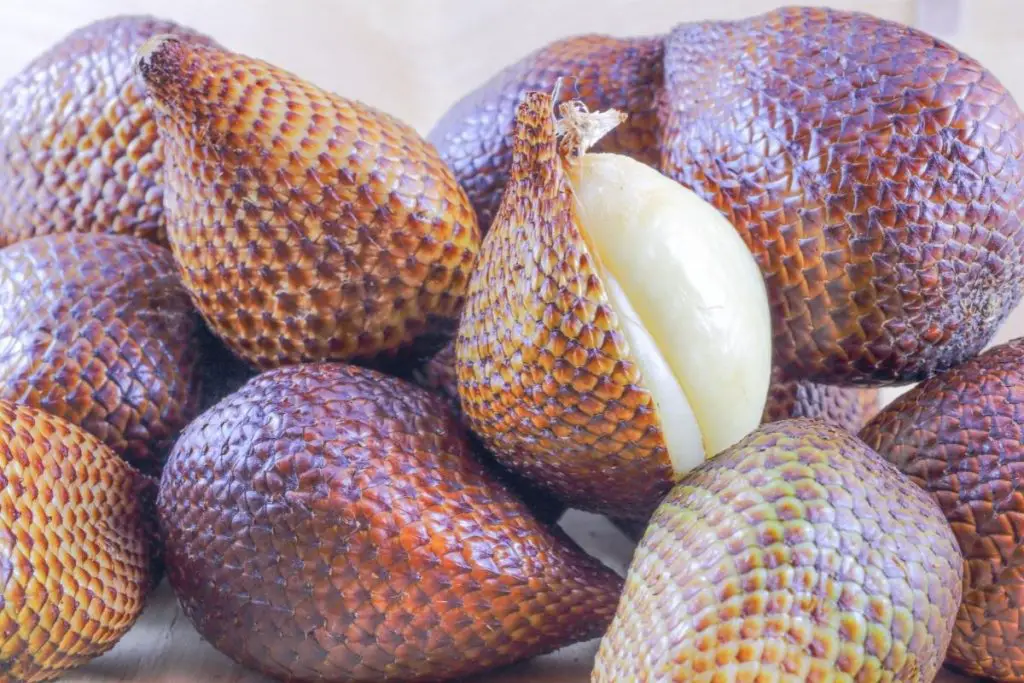
- Taste: Sweet, acidic
- Flesh: Crunchy, firm, and dry, with an edible seed
- Skin: Fig-shaped, snakelike-skin, thin, inedible
- Season: All year round
14. Bambangan (Sabah Sour Mango)
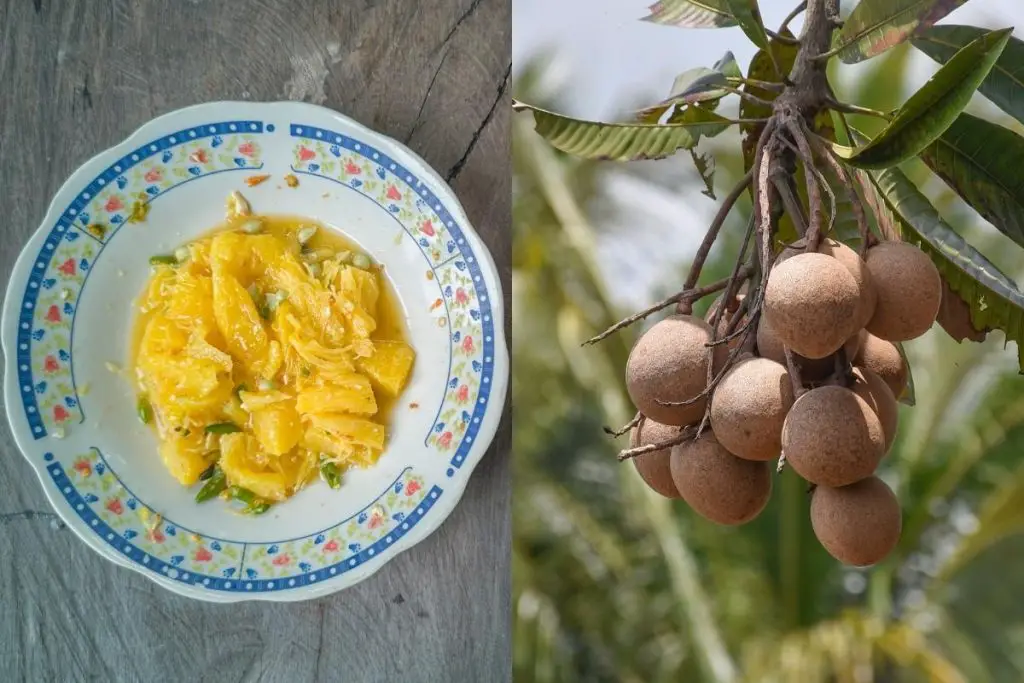
A popular fruit in the state of Sabah can be eaten raw or pickled to serve as a condiment to rice.
- Taste: Sour and sweet
- Flesh: Bright yellow colour with edible seeds, aromatic
- Skin: Thick, brown colour
- Season: July to August or August to October
A Quick Introduction to Malaysian Food
Staple Malaysian Foods
Nasi = Rice, the main staple food in Malaysia
Mee, Kuey Teow, Bihun = Noodles, the second staple food in Malaysia
The main meats used in Malaysian dishes are chicken, pork, beef, mutton, fish, and seafood like prawns and squid.
Malaysian Eating Culture
In Malaysia, only Malays (not all but the majority) and some Indian Muslims eat rice dishes using their hands, Chinese eat with spoon and chopsticks or fork, and Indians eat with spoon and fork.
Halal Food in Malaysia
Halal food = Pork-free and lard-free, including the processes and practices of handling the food.
All food served in Malay restaurants and stalls, Mamak, and restaurants with Halal symbols are halal food.
Chinese and non-Muslim Indians in Malaysia eat pork and non-halal food.
Common Food Places in Malaysia
Kopitiam, Kedai Kopi = Hawker centres, run by Chinese vendors
Medan Selera = Food courts, run by Chinese or Malay vendors
Pasar Malam = Night market, there are Chinese night markets and Malay night markets
Pasar Pagi = Morning market, there are Chinese morning markets and Malay morning markets
Mamak = Halal restaurant run by Indian Muslims, and most are operating 24 hours or until late at night.
History of Malaysian Cuisines
Malaysia’s cuisine is a fusion of Malay, Chinese, Indian, and indigenous flavours that have developed over centuries of trade and cultural exchanges. Here is a brief history of Malaysian food:
Pre-colonial Era
Before the arrival of Europeans, the indigenous people of Malaysia relied on hunting, fishing, and farming for their food.
They used ingredients such as coconut, pandan leaves, ginger, and tamarind in their cooking. The Malays were also known to trade with neighboring countries like India and China, which influenced their cuisine.
Colonial Era
In the 16th century, Portuguese traders arrived in Malaysia and introduced new ingredients such as chilies, tomatoes, and potatoes. The Dutch and British later colonized Malaysia and brought in more spices like nutmeg, cloves, and cinnamon.
Post-independence Era
After Malaysia gained independence from British rule in 1957, the country’s cuisine continued to evolve. The government launched a program to promote Malay cuisine, which became the dominant cuisine of Malaysia. However, Chinese and Indian cuisine also remained popular.
Today, Malaysian cuisine is a blend of different cultures and flavors. Some popular dishes include:
- Nasi lemak: A fragrant rice dish cooked in coconut milk and served with anchovies, peanuts, cucumber, and a spicy sambal sauce.
- Char kway teow: Stir-fried rice noodles with prawns, cockles, Chinese sausage, and bean sprouts.
- Roti canai: A flatbread served with a side of curry.
- Laksa: A spicy noodle soup made with fish or chicken broth and topped with prawns, tofu puffs, and bean sprouts.
- Satay: Skewered and grilled meat served with a peanut sauce.
In short, Malaysian cuisine is a unique blend of different cultures and flavors that has developed over centuries. It continues to evolve and adapt, reflecting the diverse influences that have shaped its history.
Best Malaysian Foods to Try [Top Priority]!
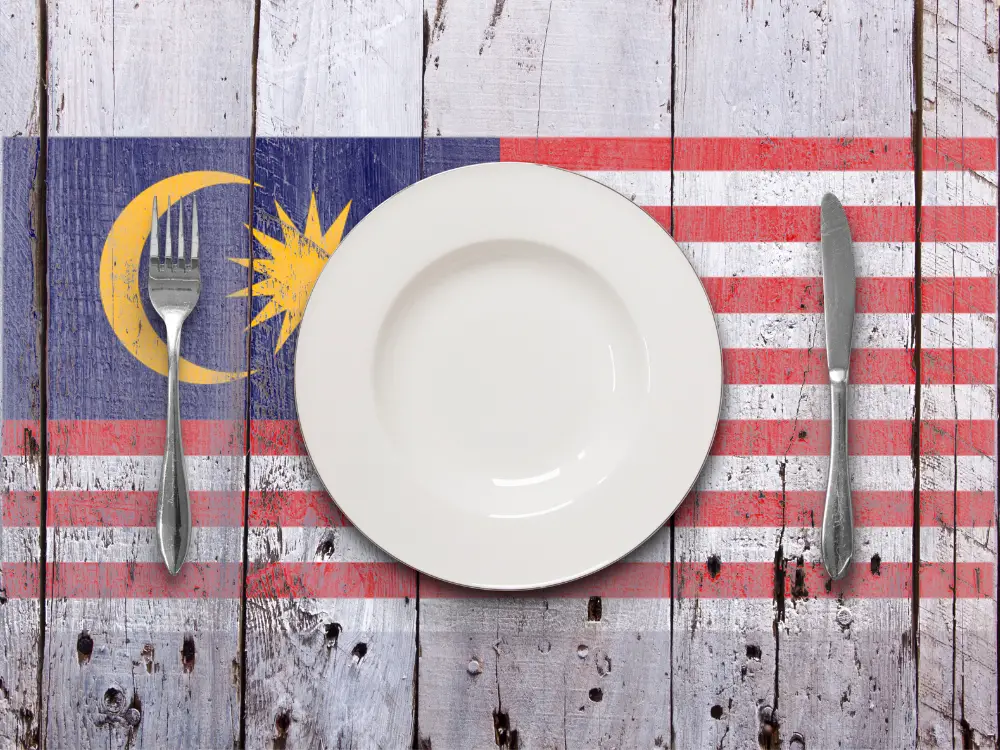
If you only stay a few days in Malaysia, it’s not possible for you to try all the best food in Malaysia. If that’s the case, prioritize this list of Malaysia’s top recommended foods.
Recommended Main Meals (Breakfast, Lunch and Dinner):
- Nasi Lemak + Karipap: Roadside stall or hawker centre or restaurant (breakfast or lunch or dinner)
- Char Kuey Teow + Iced Ambra Juice with Sour Plum (drink): Hawker centre (breakfast or lunch)
- Roti Canai + Naan + Tandoori Chicken + Teh Tarik: Mamak (dinner)
- Nasi Kandar + Teh O Ice Limau (drink): Mamak (lunch)
- Wanton Mee: Hawker centre (breakfast or lunch or dinner)
- Hokkien Mee + Fried Rice (for 2 pax or if you can eat a lot): Hokkien mee restaurant (dinner)
- Curry Laksa/Curry Mee: Hawker centre (lunch)
- Rendang (Chicken, Beef, Lamb) + Ayam Pongteh + Kuih: Nyonya Restaurant (lunch or dinner)
- Bak Kut Teh + Chinese tea: Bak Kut Teh restaurant (dinner)
- Yong Tau Foo: Yong Tau Foo restaurant (lunch)
- Hainanese Chicken Rice: Hawker centre or The Chicken Rice Shop restaurant (lunch or dinner)
- Banana Leaf Rice: Banana Leaf restaurant (lunch)
- Nasi Kerabu: Restaurant or roadside stall (lunch or dinner)
- Nasi Goreng Kampung: Restaurant (lunch or dinner)
- Mee Goreng Mamak: Mamak (lunch or dinner)
- Chicken Rice + Char Siew + Siew Yoke + Roasted Duck: Hawker centre or food court or restaurant (lunch or dinner)
- Sup Kambing: Restaurant or Mamak or roadside stall (dinner)
- Kolo mee/Kolok Mee: Hawker centre or restaurants (breakfast or lunch or dinner)
- Penang Hokkien Mee/Prawn Mee: Hawker centre or food court (breakfast or lunch)
- Pan Mee: Hawker centre or food court or Pan Mee restaurant (breakfast or lunch)
- Chee Cheong Fun: Hawker centre or roadside stall (breakfast or lunch)
- Asam Laksa/Assam Laksa/Penang Laksa: Hawker centre (lunch)
- Dim Sum + Chai Tow Kway: Dim Sum restaurant (Breakfast)
- Roti Bakar/Kaya Toast + Ipoh White Coffee: Hawker centre or restaurant (Breakfast)
- Ikan Bakar: Restaurant or food court (Dinner)
Recommended Afternoon Tea, Snack and Supper:
- Ramly Burger: Roadside stall (supper or late-night snack)
- Cendol: Roadside stall (afternoon tea)
- Rojak Mamak/Rojak Pasembur: Mamak or roadside food truck (afternoon tea)
- Satay: Hawker centre or food court (dinner snack)
- Youtiao/Yu Char Kway/Cakoi: Roadside stall (breakfast snack or afternoon tea)
- Keropok Lekor: Roadside stall or Malay night market (afternoon tea or dinner snack)
- Pisang Goreng: Roadside stall (afternoon tea)
- Otak-otak: Restaurant or food court or roadside stall (afternoon tea or dinner snack)
- Apam Balik: Roadside stall or Chinese or Malay night market (afternoon tea or dinner snack)
- Ais Kacang: Roadside stall (afternoon tea)
Note: This list is just for your reference, feel free to adjust it depending on your eating preference and the places you stay and visit.
Where to Find the Best Foods in Malaysia?
Wondering where to find the best foods to eat in Malaysia?
No worries, this section will show you the places that you can go to fill your stomach.
The hygiene level of Malaysian street foods is acceptable and most foods are prepared upon order, so it is safe, don’t worry if you will get diarrhoea after eating.
Hawker Centres (Kedai Kopi/Kopitiam)
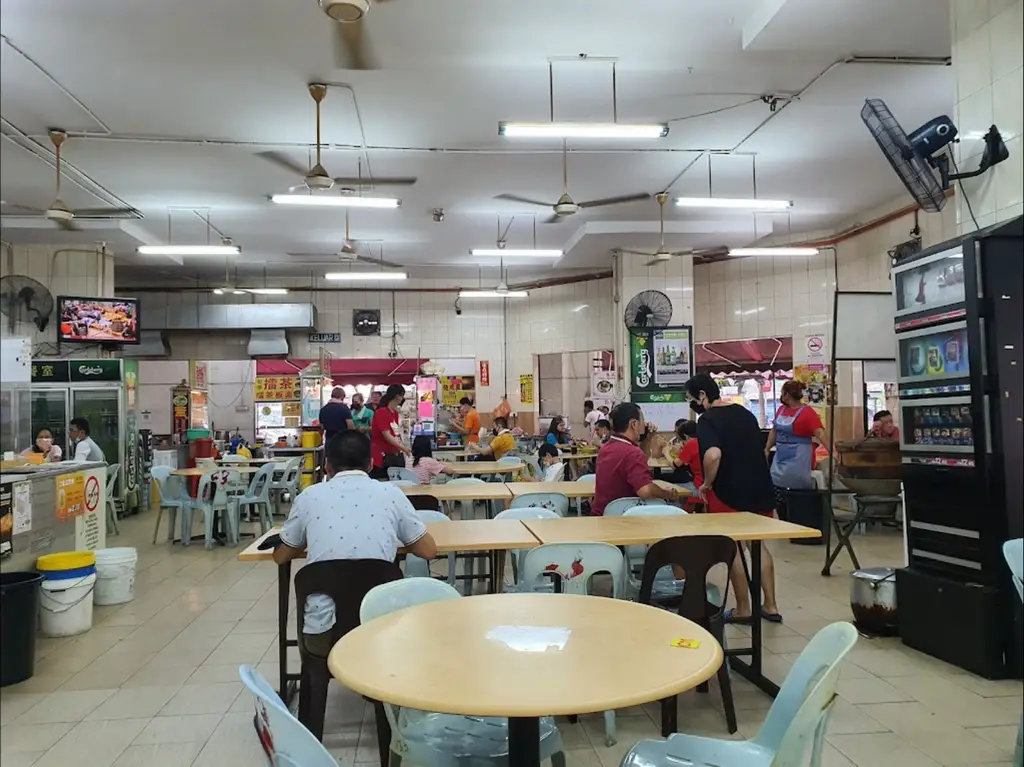
Hawker centres are places with many individual stalls that sell different types of food. It is one of the best places to eat in Malaysia to try out the some of the best Malaysian cuisines.
Most hawker centres are run by Chinese, and some serve alcohol.
Most hawker centres are without air conditioning.
Most stalls in hawker centres open during breakfast and lunchtime, and many stalls will close after 2 to 3 pm, leaving only a few stalls open until night.
So, it is better to have your dinner at a food court instead, where most stalls are open during the evening time.
The food price in hawker centres is cheaper than in restaurants and cafés. You pay for the food when it is served to you.
Food Courts (Medan Selera)
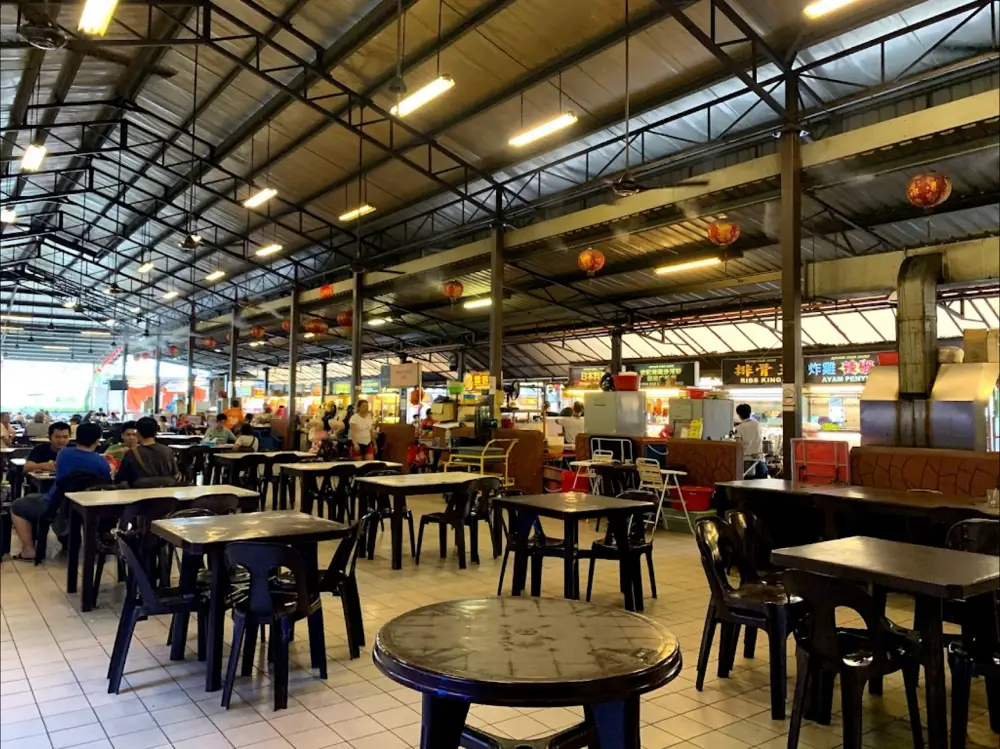
Food courts are similar to hawker centres but on a large scale with more stalls.
Food courts in a mall or shopping centres operate from morning until night.
Outside of malls or shopping centres, some food courts only open during the evening time, whereas some operate from morning until night.
You can find stalls of different cuisines in a food court.
Roadside Stalls/Food Trucks
Roadside stalls are common in Malaysia and sell some of the best food in Malaysia at a cheaper price.
Some roadside stalls and food trucks also provide tables and chairs to enjoy the food.
The operating hours of roadside stalls and food trucks vary depending on the food they sell.
For instance, most roadside stalls that sell nasi lemak usually operate in the morning, whereas roadside stalls that sell fried snacks like karipap, keropok lekor, and pisang goreng usually open their stalls afternoon or evening.
Restaurants and Cafés
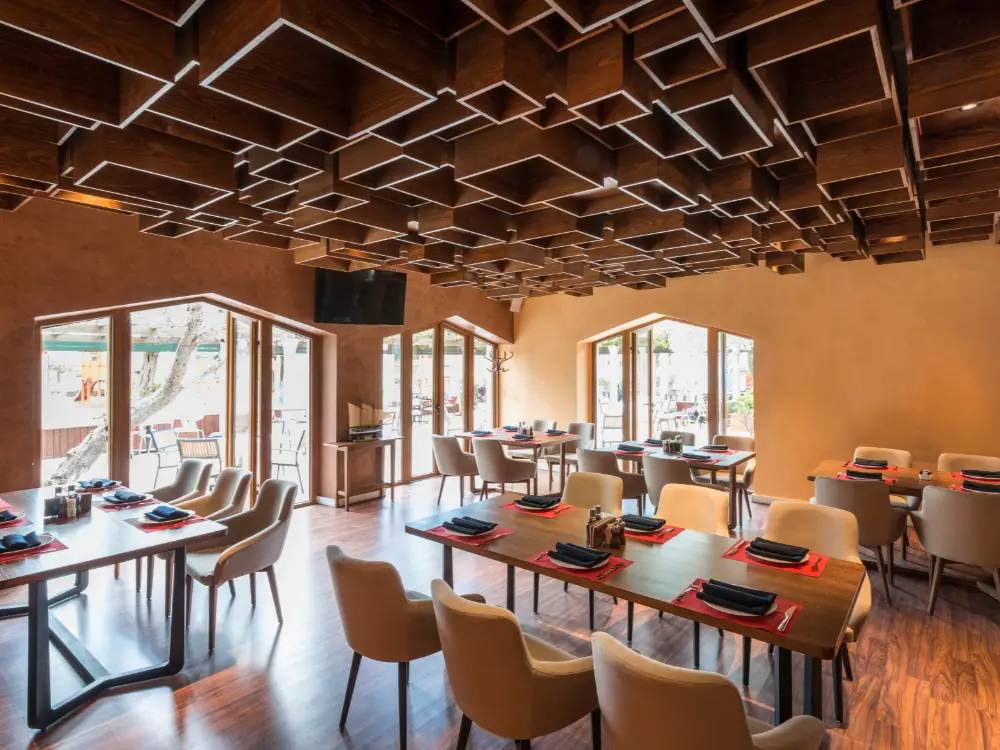
Most restaurants and cafés operate from morning until night, but some only operate in the evening like KL Hokkien Mee restaurants, whereas some operate from morning until afternoon like Dim Sum restaurants.
There are many Chinese seafood restaurants in Malaysia where you can eat all kinds of Chinese-cooking style dishes like meats (chicken and pork), vegetables, tofu, eggs, seafood (fish, prawn, crab and squid), fried rice, KL Hokkien mee, and fried mee hoon.
Most cafés are air-conditioned and have a better ambience to enjoy your meal, but they are also more expensive and many of the best Malaysian foods couldn’t be found.
You can find western foods and coffee in most cafés in Malaysia.
Night Markets (Pasar Malam)
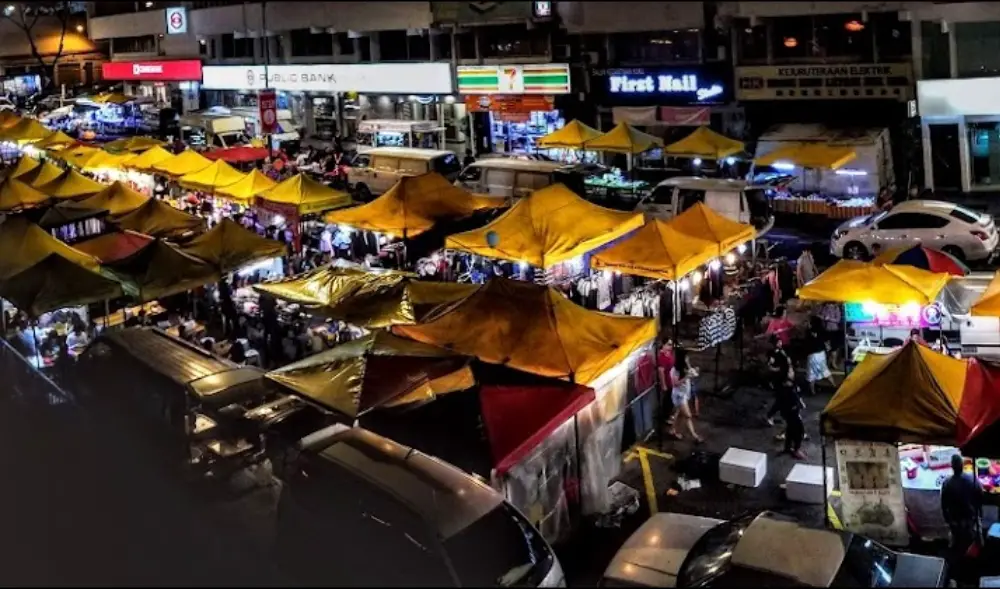
Night markets (Pasar Malam) are common in Malaysia and are usually crowded.
There are Chinese and Malay night markets.
Each night market has its opening hours, usually once every week (weekday or weekend), starting from the evening (4 to 5.30 pm) until late at night (10 pm to 1 am).
You can find many things in Malaysia night markets, including foods, drinks, clothes, gadgets, etc.
Some of the famous Pasar Malam in Malaysia are:
- Jalan Alor Food Street/night market (Bukit Bintang, KL) – One of the most famous food streets in Malaysia, located at the heart of Kuala Lumpur.
- Pasar Malam Taman Connaught (Cheras, KL) – One of the largest night markets with over a hundred stalls and a wide range of Malaysian street foods.
- Pasar Malam Sri Petaling (Sri Petaling, KL) – One of the best night markets in Malaysia.
- Pasar Malam Jalan Tuanku Abdul Rahman (City Centre, KL) – A night market with a wide range of textiles
Where and What to Eat The Best Malaysian Food
Breakfast (Sarapan Pagi)
One of the best places to take your breakfast in Malaysia is hawker centres or Kedai Kopi or Kopitiam, in which you can enjoy dishes and drinks like wonton mee, lor mee, chee cheong fun and char kuey teow, roti bakar (kaya toast), coffee, tea, and many more.
Dim Sum is another popular breakfast choice in Malaysia, imagine starting your day with plates of delicious dim sum, that must be a great day!
You can also go Mamak for roti canai (with dhal curry) and teh tarik, one of the staple breakfast combos for locals.
Also, don’t forget one of the best breakfasts in Malaysia, the nasi lemak! You can buy it from a roadside stall or enjoy it in a restaurant or covered street stall. One of my favourite foods.
Lunch (Makan Tengah Hari)
There are many delicious foods you can have for your lunch, such as chicken rice, Hainanese chicken rice, asam laksa, Har mee (prawn mee)/Penang laksa, pan mee/chilli pan mee, curry laksa, nasi lemak, mixed rice, and more. You can enjoy these foods in a hawker centre or covered street stall.
You can also go for flavourful nasi kandar in a Nasi Kandar restaurant or Mamak, banana leaf rice in a Banana Leaf restaurant, or nasi campur, asam pedas and nasi goreng kampung in a Malay restaurant and covered street stall.
Yong Tau Foo is another great choice for lunch, and you can have it in a Yong Tau Foo restaurant or hawker centre.
Dinner (Makan Malam)
The popular dinner choices in Malaysia are bak kut teh, KL Hokkien mee, fried rice, claypot chicken rice, nasi lemak, ikan bakar, mee goreng, mee goreng Mamak, kari kepapa ikan (fish head curry), and more which you can have it in the respective restaurant.
You can also order some snacks to eat along with your main meal, such as the delicious satay, lor bak and murtabak, or sweet treats like apam balik (Malaysian pancake).
Afternoon Tea (Minum Petang)
If you feel like having something in between lunch and dinner, you can try out our famous afternoon snacks and desserts which you can find at the roadside stalls and food trucks!
You can try out the popular afternoon snacks like Youtiao/cakoi, keropak lekor, pisang goreng (banana fritters), karipap (curry puffs), apam balik, cucur udang (scallion prawn fritter), rojak and rojak Pasembur and local favourite desserts like ais kacang (ABC), cendol, tong sui (Chinese soup desserts) and bubur cha cha.
You can also find a café to enjoy your usual coffee or tea or Hainanese coffee with some desserts or afternoon snacks.
Supper (Snek Lewat Malam)
The two best places to find supper are Mamak and roadside stalls or food trucks.
In Mamak, you can enjoy supper like roti canai with dhal curry, naan, tandoori chicken, maggie goreng, and teh tarik.
Next, we have one of the Malaysian all-time favourite suppers, the Ramly burger! You can find Ramly burger stalls across the roadside in Malaysia, they are everywhere.
You can also find food trucks like Lok-lok and roti john to fill your stomach late at night.
Main Cuisines in Malaysia: Best Malaysian Food
As a country known as food heaven, there are many cuisines available in Malaysia, and the six main cuisines are Malay cuisine, Chinese cuisine, Indian cuisine, Nyonya cuisine, Borneo cuisine, and Southeast Asian cuisine.
Malay Cuisine

Malay dishes are influenced by Indonesia and China, where you can find many rice and noodle dishes.
Malay foods tend to be spicy or sweet or both as the widely used ingredients are sambal, santan (coconut milk), belacan (shrimp paste), onions, lemon grass, chilli, soy sauce, sugar, spices like galangal, and herbs like kaffir lime leaves.
Some of the most famous Malay dishes are nasi lemak, satay and rendang meat.
One of the signature Malay foods is kuih, which includes a range of colourful sweet pastries or desserts or snacks, some kuih are savoury. They are usually made with coconut, palm sugar, salt, and flour.
In Malaysia, you can find a lot of Malay roadside stalls that sell popular snacks and desserts in Malaysia are karipap (curry puff), keropok lekor (fried fish sausage), pisang goreng (banana fritter), spring rolls, cakoi, ais kacang, and cendol.
Also, most Ramly burger stalls are run by Malay vendors.
All Malay foods are Halal, pork-free and lard-free.
Chinese Cuisine
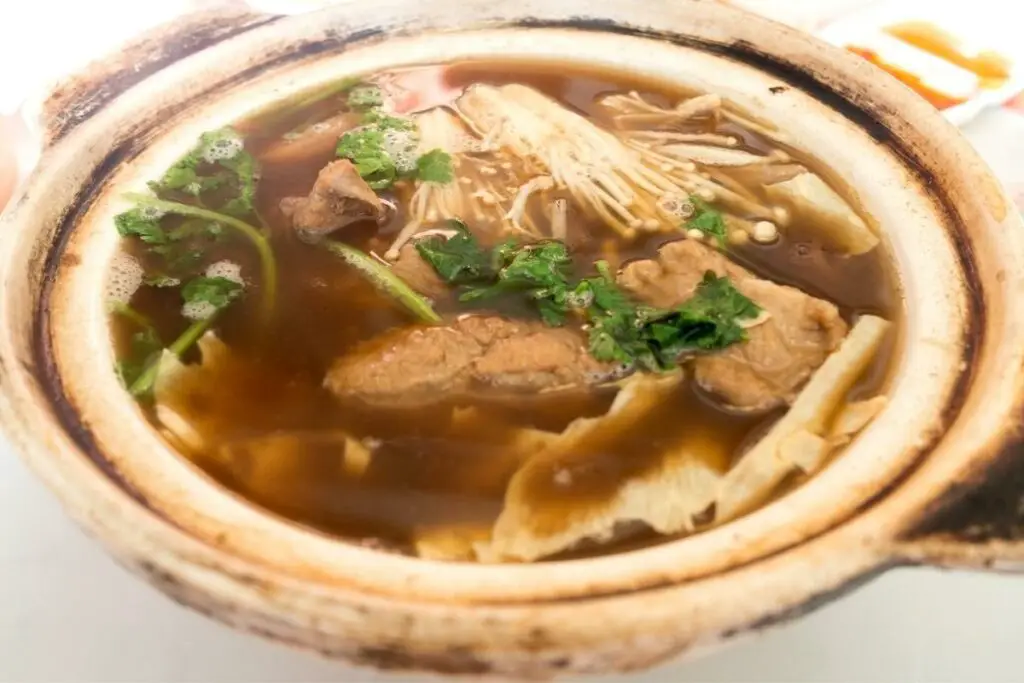
Chinese dishes in Malaysia are heavily influenced by Southern China, mainly Fujian, Canton (Guangzhou) and Hainan Island as most Malaysian Chinese are descendants of Southern Chinese immigrants who migrated to Malaysia between the 19th to 20th centuries.
We have famous Hokkien and Teochew foods like KL Hokkien mee, Penang Hokkien mee, bak kut teh, yong tau foo, char kuey teow, Har Mee (prawn noodles) and bak zhang, famous Cantonese foods like Dim Sum, chicken rice, char siew rice, wonton mee, and chee cheong fun, and famous Hainanese foods like Hainanese chicken rice and Hainanese coffee.
Rice, noodles and porridge are the staple food for Malaysian Chinese.
Chinese dishes often use pork, chicken and shrimp, and pair with rice and noodles. They are also less spicy than Malay and Indian cuisines.
The best places to enjoy Chinese foods in Malaysia are hawker centres, food courts and Chinese restaurants.
Indian Cuisine

Indian dishes in Malaysia are mostly inspired by South Indians as most Malaysian Indians are descendants of South Indian immigrants.
In Malaysia, some of the most famous Indian dishes are roti canai (with dhal curry), nasi kandar, mee goreng Mamak, maggie goreng, meat (chicken, mutton, beef or fish) curry, roti tissue, naan, chicken tandoori, murtabak, nasi biryani, and banana leaf rice.
Indian dishes often use chicken, mutton and beef, and tend to be rich in flavour and aromatic as they use a lot of spices and herbs.
The best places to enjoy Indian foods are Mamak (run by Indian Muslims), Nasi Kandar restaurants, and Indian restaurants.
Mamak is Halal and usually operates from morning until late night or even midnight.
Nyonya Cusine (Peranakan Food)

Nyonya food is a mixed cultural cuisine influenced mainly by Chinese and Malay, and some by Indonesia.
During the 15th to 16th century, Chinese merchants came to Melaka (Malacca), which was a Portuguese and Dutch trading route, and married Malay women, which created the Baba-Nyonya (Peranakans) community with Chinese men referred to as Baba, and Malay women referred to as Nyonya.
Nyonya cuisine often uses pork (as influenced by Chinese) and Malay spices (as influenced by Malay) in preparing the dishes.
Nyonya foods usually taste sweet, spicy, sour, and salty.
Some of the popular Nyonya foods are laksa (spicy sour noodle soup), kari ayam kapitan (dry chicken curry), ayam pongteh (Nyonya stewed chicken and potato)/babi pongteh (Nyonya stewed pork and potato), bubur cha cha, jiu hu char, and Nyonya Cendol.
Nyonya kuih is another popular food from Nyonya, some of the popular ones are Ang Koo Kueh, Kuih Kochi, Kuih Seri Muka, and Kuih Lapis.
You can find Nyonya dishes at Nyonya restaurants, restaurants that sell Nyonya dishes, and Nyonya Colors.
Borneo Cuisine (Sabah and Sarawak Dishes)

Sabah and Sarawak are states of Malaysia in the northern part of the island of Borneo, better known as East Malaysia.
They have their unique dishes that revolve around Chinese and Malay dishes, as well as indigenous dishes from Kadazan-Dusun, Bajau and Murut in Sabah; indigenous dishes from Dayak, Iban, Bidayuh, Kenyah, Kayan, Kedayan, Lunbawang, Punan, Bisayah, Kelabit, Berawan, Kejaman, Ukit, Sekapan, Melanau and Penan in Sarawak.
Sabah’s popular foods include hinava (raw fish pickled in lime juice), tuhau, bambangan, sinalau bakas (smoked wild boar meat), tuaran mee, sang nyuk mian (sliced pork noodles), ngiu chap/beef noodle soup, and pinasakan.
Sarawak has kolo mee, Sarawak Laksa, kueh chap, umai, ayam pansuh/manok pansoh, manok kacangma, tomato koay teow, kampua mee, mee sapi, Sarawak layer cake, belacan bihun, and juicy pork satay.
It is not easy to find Sabah and Sarawak dishes in Peninsula (West Malaysia), but there are some speciality restaurants that serve Sabah or Sarawak dishes specifically.
Southeast Asian Cuisine

Part of some Malaysian foods is influenced by Southeast Asian cuisines, especially Indonesian cuisine.
These foods have been localized by using different ingredients and recipes to better suit the taste of locals.
Some of the famous Southeast Asian cuisines in Malaysia are rendang, cendol, karipap, satay, pisang goreng, otak-otak, sup kambing, roti bakar, asam pedas, Murtabak, rojak, ketupat, and rempeyek.
Beverages and Alcohol Drinks in Malaysia
Beverages in Malaysia
There are all kinds of drinks in Malaysia, including:
- Coffee (Kopi)
- Teh Tarik
- Teh ‘O’ Ais Limau (iced tea with lime)
- Chinese tea
- Herbal tea
- Milo (chocolate malt drink)
- Soya milk
- Fruit juices
- Soft drinks (Coke, 100plus, Pepsi, etc.)
- Sugar cane
- Syrup (Malay sugar drink)
- Coconut drink
- Ambra juice with sour plum
- Sour plum lime juice (limau asam boi)
- and many more.
Teh tarik is usually served very sweet, so if that is not what you want, ask for “teh tarik kurang manis”, which means less sweet.
There are many types of kopi (coffee) in hawker centres, here are some of the common ones to know:
- Kopi = Coffee with condensed milk and sugar.
- Kopi “Peng” or Kopi Ice = Coffee condensed milk, sugar and ice.
- Kopi “Gau/Kaw” = Strong brewed coffee with condensed milk and sugar, “Gau/Kaw” mean rich or strong.
- Kopi “O” = Coffee with sugar only, also known as black coffee
- Kopi “O Kosong” = Coffee without sugar and milk, “kosong” means “empty” in Malay.
- Kopi “O Kosong Gau/Kaw” = Strong brewed coffee without milk and sugar.
- Kopi “C” = Coffee with evaporated milk and sugar
- Kopi “C Kosong” = Coffee with evaporated milk only
- Kopi “C Kosong Gau/Kaw” = Strong brewed coffee with evaporated milk only.
Alcohol in Malaysia
Alcohol is a non-halal drink, usually served in the bar and some restaurants, hawker centres and food courts in big cities.
You can also find alcohol in groceries mart, supermarkets, hypermarkets, and malls.
The popular alcohol brands in Malaysia are Tiger, Carlsberg, Anchor, Heineken, and Guinness.
Also, it is hard to find alcohol in Malay areas and states like Kelantan and Terengganu.
Price of Foods in Malaysia
Depending on the place you have your food, here are the estimated price ranges for 1 person:
- Roadside stalls – RM3 to RM10 (Food), RM1 to RM5 (Beverage)
- Hawker centres – RM6 to RM12 (Food), RM1 to RM5 (Beverage)
- Food courts – RM7 to RM15 (Food), RM1 to RM5 (Beverage)
- Mamak/Nasi Kandar restaurants – RM6 to RM20 (Food), RM1.50 to RM5 (Beverage)
- Dim Sum restaurants – RM20 to RM40, RM2 to RM5 (Beverage)
- Bak Kut Teh restaurants – RM15 to RM30, RM2 to RM5 (Beverage)
- Chinese seafood restaurants – RM10 to RM50, RM2 to RM15 (Beverage)
- KL Hokkien Mee restaurants – RM10 to RM20 (Food), RM2 to RM5 (Beverage)
- Yong Tau Foo restaurants – RM10 to RM20 (Food), RM2 to RM5 (Beverage)
- Café – RM10 to RM50 (Food), RM2 to RM15 (Beverage)
Acceptable Payment Modes in Malaysia
Cash is acceptable in all food places.
Some stalls on the roadside, night markets, hawker centres, and food courts accept e-Wallets like Touch ‘n Go, GrabPay and Boost.
The majority of restaurants accept e-Wallet or/and credit card/debit cards (Visa/Master).
American Express charge card is only acceptable in some high-end restaurants.
Here is the payment mode for the following food places:
- Roadside stalls and night markets – mostly cash only, some accept e-Wallet
- Hawker centres and food courts – cash and e-Wallet
- Restaurants – cash, e-Wallet, credit card/debit card (Visa/Master)
FAQ for Malaysian Food
Here are some of the frequently asked questions about Malaysian food.
What is Malaysian food?
Malaysian food is a diverse mix of Malay, Chinese, Indian, and indigenous cuisines. It’s known for its flavorful and spicy dishes, with a mix of sweet, sour, and savoury flavours.
What are some popular Malaysian dishes?
Some popular Malaysian dishes include nasi lemak, char kway teow, laksa, satay, roti canai, rendang, and mee goreng.
What is nasi lemak?
Nasi lemak is a popular Malaysian dish that consists of coconut rice served with various accompaniments such as sambal, fried anchovies, peanuts, cucumber, and a hard-boiled egg.
What is char kway teow?
Char kway teow is a stir-fried rice noodle dish that typically includes shrimp, Chinese sausage, bean sprouts, and egg, flavoured with dark soy sauce and chilli paste.
What is laksa?
Laksa is a spicy noodle soup that can be made with various types of noodles and broth, but typically includes coconut milk, curry, shrimp, and other seafood or meat.
What is satay?
Satay is a popular Malaysian street food consisting of skewered and grilled meat, usually chicken or beef, served with a peanut sauce.
What is roti canai?
Roti canai is a type of Indian-influenced flatbread that’s crispy on the outside and fluffy on the inside, often served with a side of curry sauce for dipping.
What is rendang?
Rendang is a rich and flavorful meat dish that’s slow-cooked with coconut milk, spices, and aromatics until the meat is tender and the sauce is thick and fragrant.
What is mee goreng?
Mee Goreng is a popular stir-fried noodle dish that’s often flavoured with a sweet and spicy tomato sauce and includes vegetables, eggs, and meat or seafood.
Is Malaysian food spicy?
Yes, Malaysian food is known for its spiciness, but not all dishes are spicy. Some dishes are mild or have a balanced mix of sweet, sour, and savoury flavours. It’s best to ask the server or chef for recommendations if you’re not sure about the level of spiciness.
Are there vegetarian options in Malaysian food?
Yes, there are many vegetarian options in Malaysian food. Many traditional Malaysian dishes can be made vegetarian or vegan by substituting meat with tofu, tempeh, or vegetables.
Are there halal options in Malaysian food?
Yes, there are many halal options in Malaysian food due to the large Muslim population in Malaysia.
Let’s Go And Try Out These Best Malaysian Foods Now!
Malaysia is a food heaven blessed with tons of delicious and unique foods that could be overwhelming for tourists, especially those who only stayed for a short period.
Following this list of best foods in Malaysia ensures that you will not miss out on the most famous and must-eat Malaysian foods.
Wish you have a great food hunt in Malaysia!

Such a high-quality post on Malaysian foods. I will use it as a reference when visiting Malaysia! Thanks and keep it up!
Thank you!
Wow! What a long list of best Malaysia food, will share this around. My personal favourite is BKT!
Thanks!